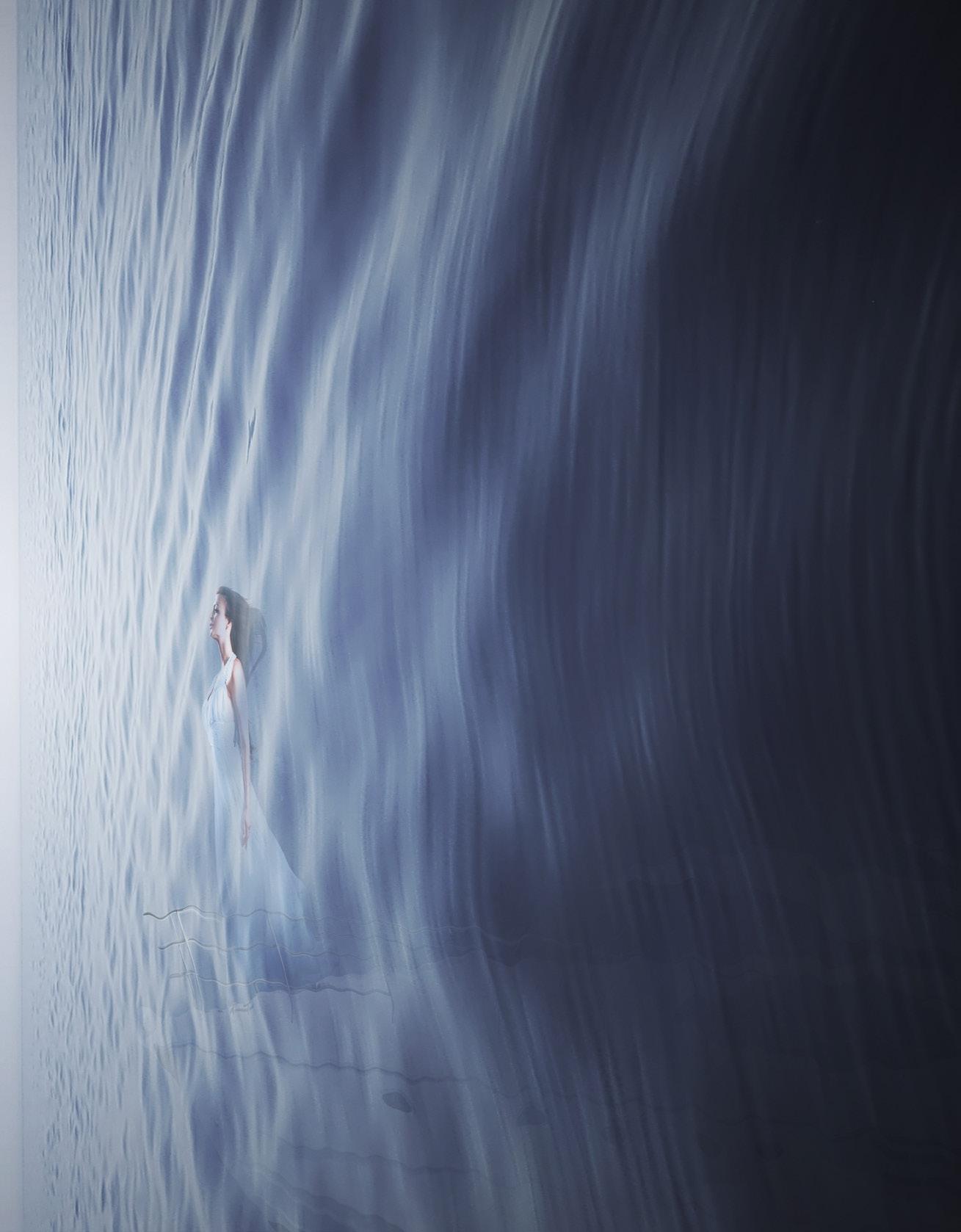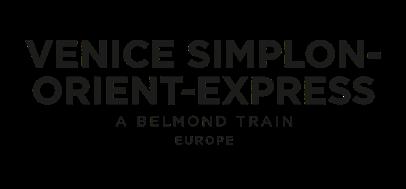Caribbean

South Tyrol
New
Zealand
Morocco
Lapland
Nepal
Owner-Operated Hotels











Caribbean

South Tyrol
New
Zealand
Morocco
Lapland
Nepal
Owner-Operated Hotels










The new era of Bizzarrini continues on the achievements of its founder Giotto Bizzarrini, whose design art is signed under the iconic Ferrari 250GTO, a twelve–cylinder engine for Ferruccio Lamborghini, but mainly under its own Bizzarrini 5300GT Corsa model, which won Le Mans in 1965 in its category.
The 5300GT Corsa Revival comes in a completely unique limited series of 24 iconic cars, created according to the original designs of Giotto Bizzarrini, but using the latest modern standards and craftsmanship. Above all, this car combines absolute elegance, performance and driving excitement with a desire for excellence.




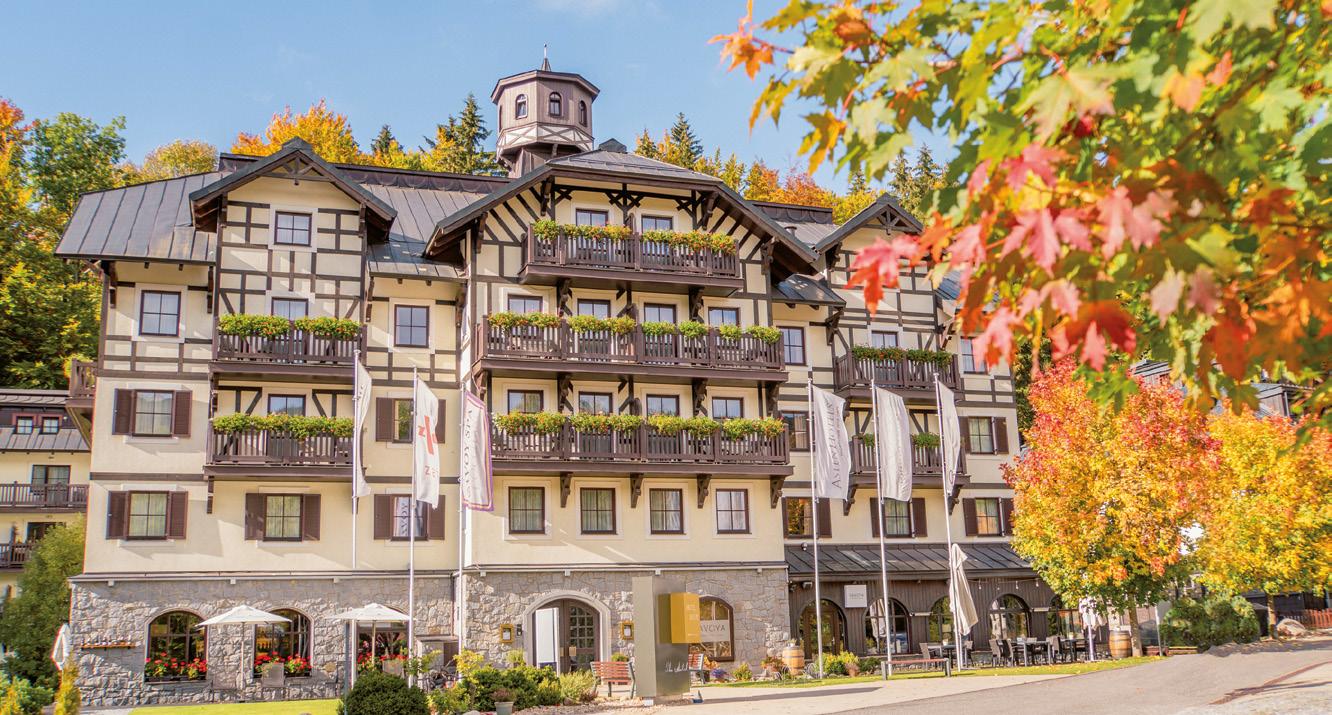







Holidays create many of our most cherished memories. They are our opportunity to relax, be ourselves, and dedicate time to what’s most important to us: the people we love.
At EliteVoyage we’re seeing our clients travel with more people. They’re going on a holiday with their children and parents together, travelling with groups of friends or extended family. How fantastic! Our headline destination the Caribbean (p. 38) is ideal for a holiday that suits multiple generations and interests. As are Lapland in winter (p. 54), South Tyrol (p. 94) and the best new African safari properties (p. 20).
On one holiday we can disconnect, reconnect with loved ones, and create new connections. With people, like Jean-Michel Jefferson in New Zealand (p. 104), polar photographer Jan Hvizdal (p. 74), chef Raymond Blanc (p. 118) and the amazing personalities behind Europe’s best owner-operated hotels (p. 64). Or also with a new country and culture, like my trip to Nepal (p. 28) and editor Stephen Bailey in Morocco (p. 124).
Where will you explore next with the people you love?
Bon voyage, Petr Udavský Co-Owner & CEO EliteVoyage
Co-Owner & CEO EliteVoyage
14 the HOT list Hotels to visit now
24 HOT list Close Up
Patina Maldives & Malakiya Villas at Madinat Jumeirah
28 Nepal Goddess of the Sky
Petr Udavský breakfasts with Everest
54 Winter in Lapland
Northern lights, skiing, snow experiences & sleeping in igloos
64
104
New Zealand

Jean-Michel Jefferson introduces his remarkable home
by EliteVoyage
Best Owner-Operated Hotels
Grand Hotel Excelsior Vittoria, Schlosshotel Fiss, BIJAL, Forestis
88
Gabriela Marková The Connector
The trends shaping tomorrow’s travel
116 Legends From Farm to Fine Gastronomy
Raymond Blanc, Leonor Espinosa, Laura Hernández, Tomáš Karpíšek
124 Morocco
Stephen Bailey extends the summer on a family holiday

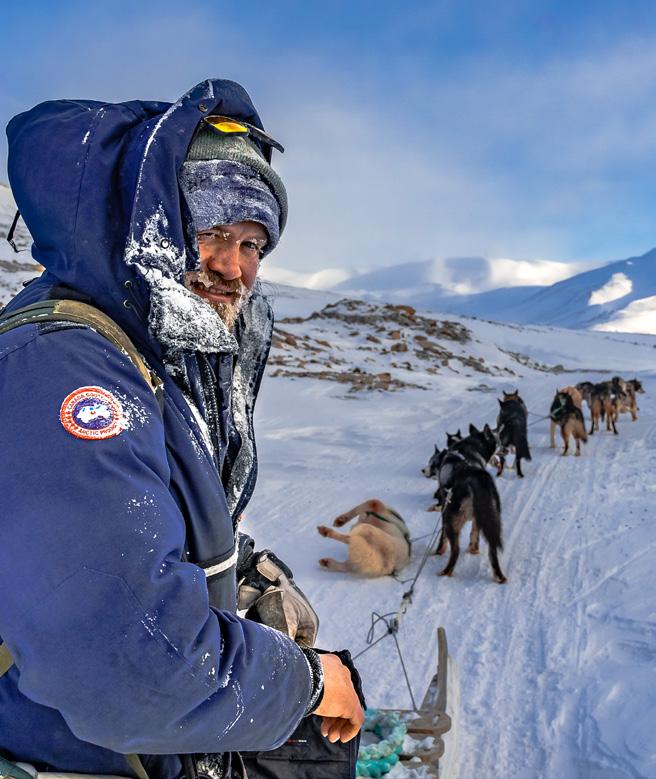

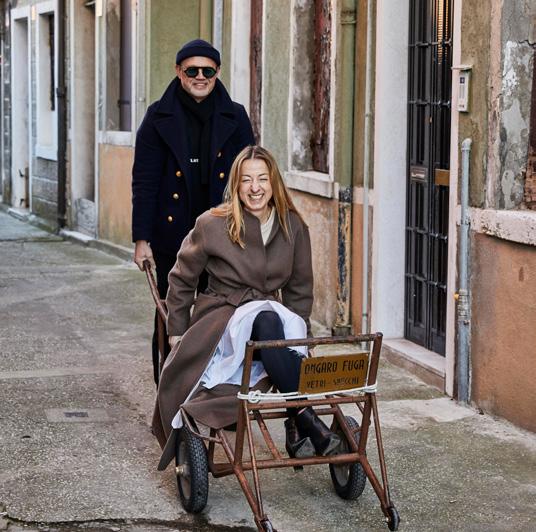


Mandarin Oriental Costa Navarino Peloponnese, Greece
A beachfront hideaway in Navarino Bay, where suites and villas with private pools are literally hidden into the earth. It’s a design inspired by traditional Messenian architecture and completed by earth tone interiors. Mandarin Oriental’s first Greek property has a breathtakingly unspoiled location, with the stay made whole by the brand’s renowned service, spa and dining.
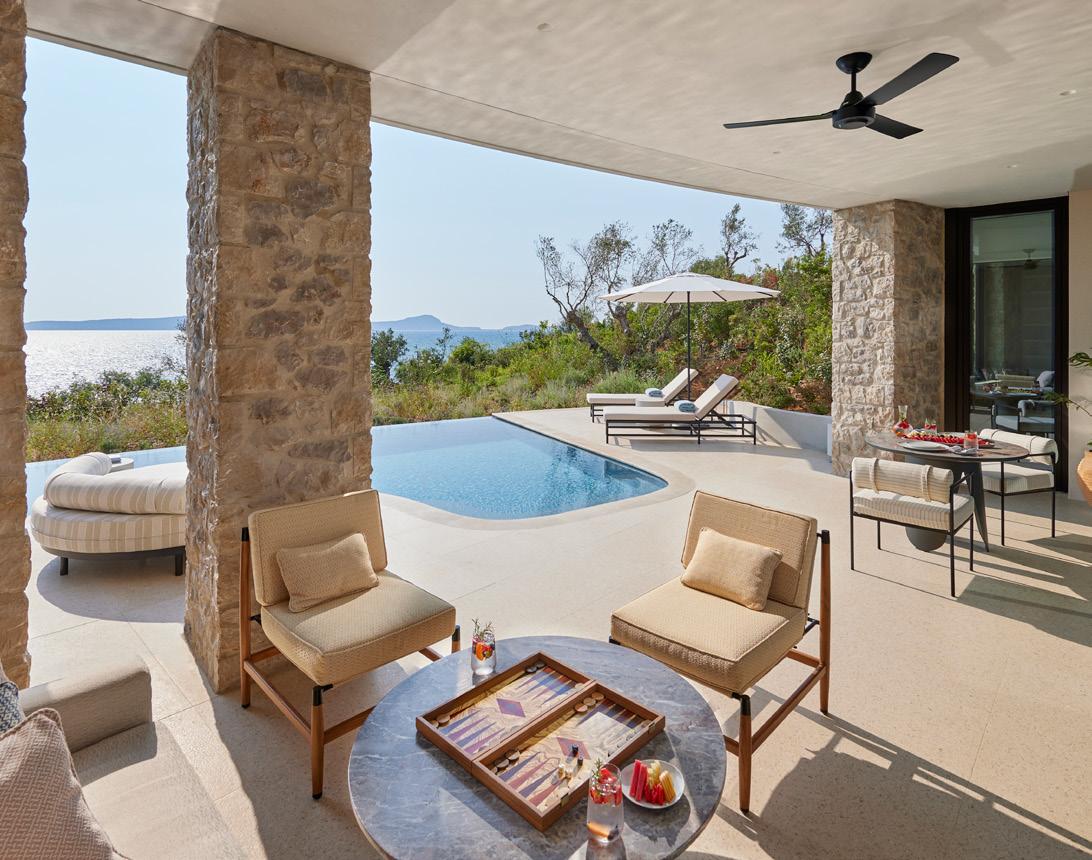
Sprawling across a lush mountainside of rice paddies and forests, Avana Retreat showcases understated luxury and Vietnamese authenticity. It’s a secluded mountain resort, a place to explore nature that tourists rarely see. And also an insight into genuine sustainability, local hospitality and culture. Just 36 spacious villas, some with private pools, plus a waterfall, Hidden Spring Lagoon, riverside spa and three-level infinity Cloud Pool.

Thick jungle meets wide-open Caribbean Sea, a divine setting for this reimagined beach resort. It’s mysterious, rejuvenating, inspired by both Mexican and Mayan traditions, with Belmond’s distinctive signature too. Like Mayan healing rituals in the Maroma Spa by Guerlain. Designed by Tara Bernerd and built by hundreds of local artisans, this is the place for an experiential Riviera Maya holiday.

Rosewood has reawakened this family resort on a beautiful and sacred Pacific coastline.
12 years after catastrophic tsunami damage, Kona Village has been sustainability rebuilt and is 100% powered by solar. It’s unmistakably Hawaiian, wrapped in the concept of ho’okipa: the hospitality of complete giving. Enhanced further by Rosewood’s contemporary quality, like signature beachfront suites (kauhale) with oversized terraces (lanai), plunge pool and butler service.
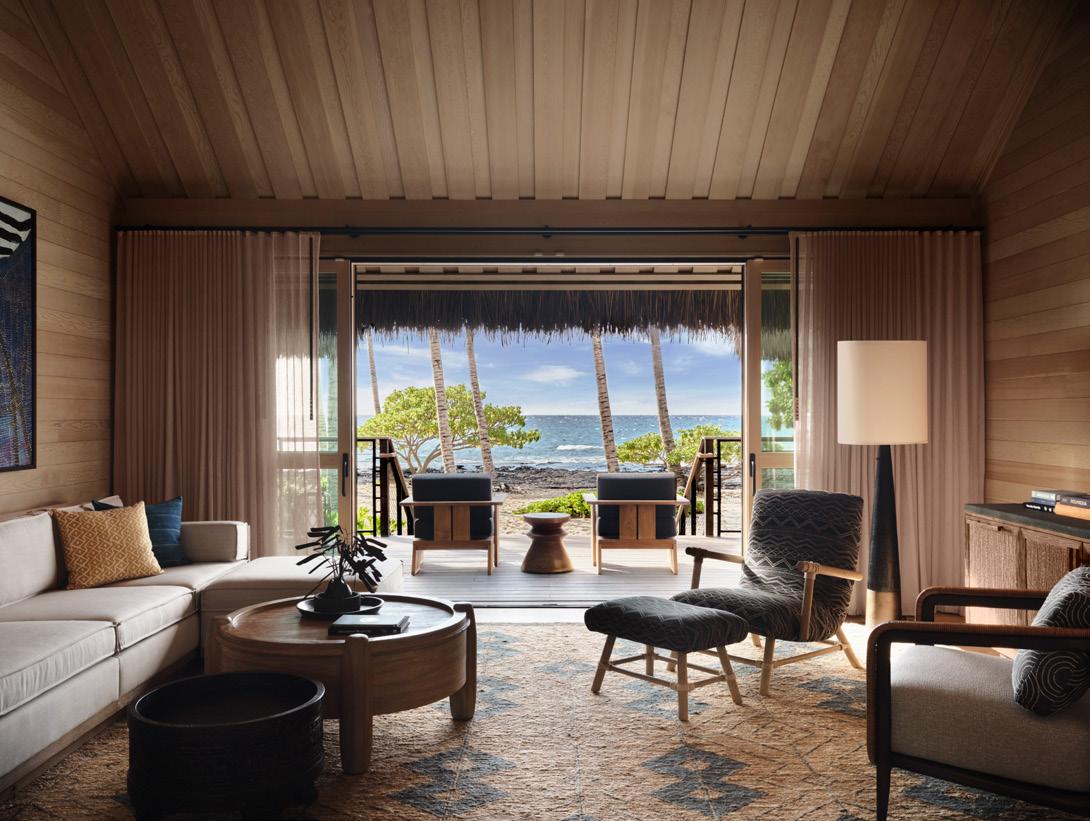
Irina Jordaan from Ker & Downey Africa introduces four recent properties that are helping to redefine the safari experience, for a new generation of safari goers. EliteVoyage partners with local specialists Ker & Downey Africa, to create highly personal and contemporary luxury safaris all across the continent.
Nyaruswiga is in the heart of the Serengeti grasslands, on the great wildebeest migration route, in a wilderness known for the big five and Africa’s greatest lion population. “This new hotel-like lodge helps guests have a deeper and more complete Serengeti experience” says Irina. “Like bush breakfasts and dinners, romantic sundowner spots, a walking safari, visiting a local Maasai village and the Moru Kopjes, a refuge for black rhinos. Game drives are in what I call the Rolls Royce of safari vehicles, their open design ideal for photographers. Nyaruswiga will soon open an on-site astral observatory too.” The 14 canvas suites are the modern quintessence of safari elegance, with copper bathtubs, indoor and outdoor showers, wood burning stoves and emperor-sized beds. “They’re super comfortable while being authentic, perfect if it’s your first-time on safari. I love the two-bedroom luxury family tents!”

“Arijiju is primarily a family home and its people are its soul” explains Irina, about this exclusive-use safari house in the vast and private Borana Conservancy. It is located in Laikipia in north-central Kenya, a last stronghold for black rhinos and a region where wildlife populations have increased significantly. “There are so many reasons why we at Ker & Downey Africa recommend Arijiju. Like service, guiding, gastronomy, the modern meets ancient design partly inspired by Ethiopian monasteries. And the feeling that you are experiencing your own Africa, your way, without seeing another vehicle or guest.” Across Africa, private conservancies and concessions restrict human access, meaning there are a lot more animals per guest. Compared to national parks, there are also fewer restrictions on what guests can do. Irina adds: “Arijiju is the most amazing place in Africa to go on safari as a multigenerational family.”

“An urban oasis and home away from home, with all the charm of safari” says Irina about Cheetah Plains’ three private-use safari villas. Each villa accommodates up to eight guests, with an expansive pool, art collection, wine cellar, formal lounge, spa treatments, private chef and spacious rooms. “They’re ideal for families, with lots of relaxation, different activities for children and adults, plus game drives in electric safari vehicles, one part of a zero-emission safari.” Cheetah Plains is a private safari concession best known for incredible leopard sightings and being a home to endangered species, like African wild dogs, honey badgers and cheetahs. Irina adds: “By moving soundlessly your senses are better heightened to the wonders of the bush. And you can get closer to the animals.”
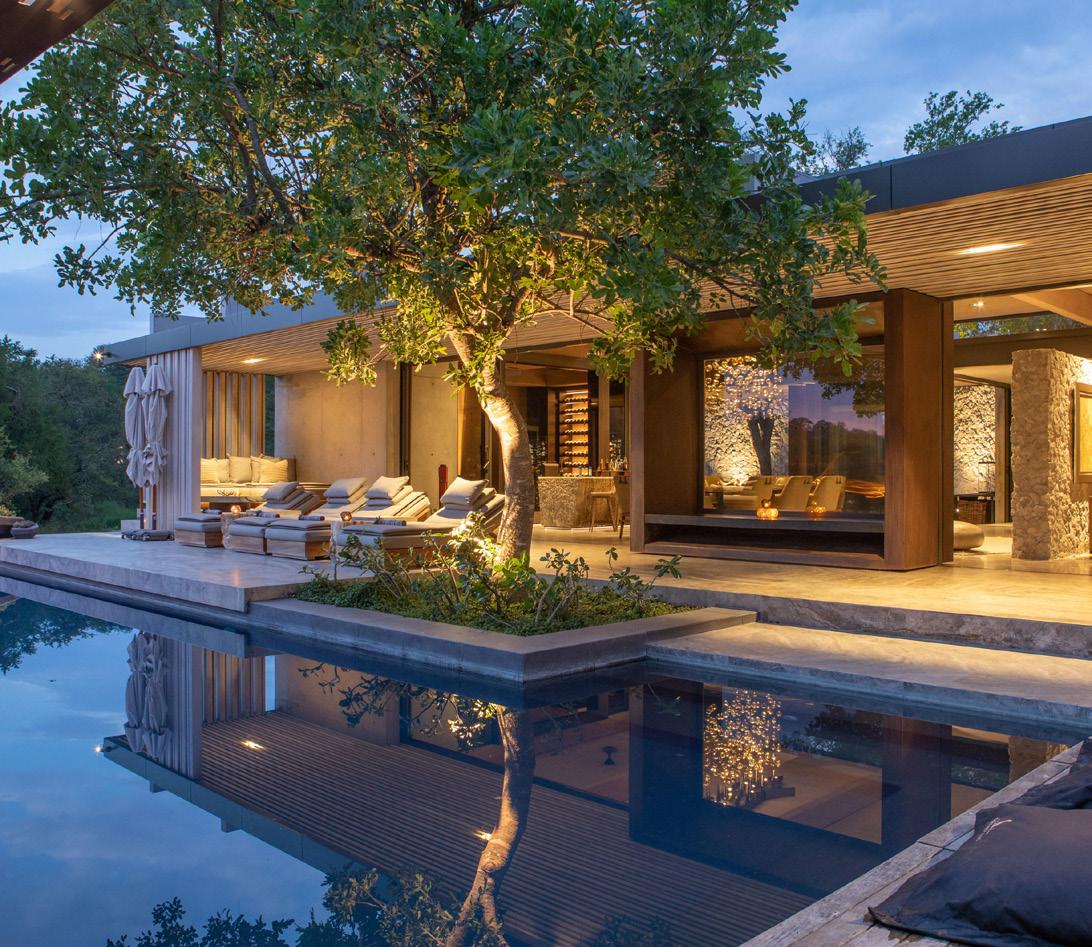
“Xigera is redefining the art of an African safari, by fusing exceptional luxury with African design, local community empowerment and pioneering sustainability," says Irina. The 12 suites enjoy private access to a wetland paradise in the heart of the Okavango Delta, the most remarkable being the Baobab Treehouse, located one kilometre from the lodge. “You encounter the real Africa here” continues Irina, “a wholly immersive experience from the solitude of this artistic treehouse, with its private guide and guard.” There’s a multi-award-winning spa and art gallery too, at a lodge that’s off the grid, in an area of papyrus swamps, wooded islands, hippos and elephants. Wetland areas create opportunities for rare water-based safari activities, such as exploring in a traditional mokoro canoe, a very enchanting insight into the wilderness and its wildlife.
 Xigera Safari Lodge Okavango Delta, Botswana
Xigera Safari Lodge Okavango Delta, Botswana
EliteVoyage Travel Designer Matous Grund explores one of the most exciting recent additions to the Maldives.
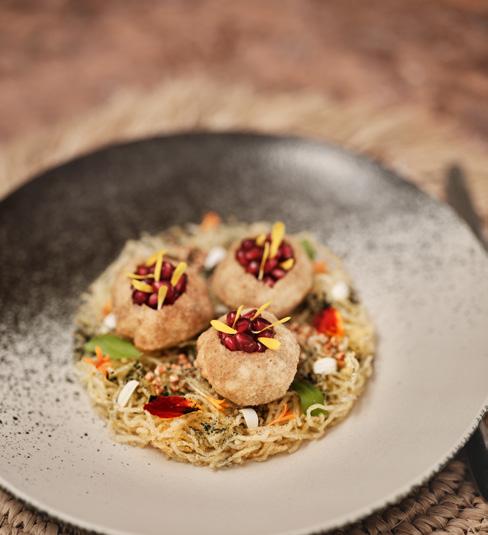

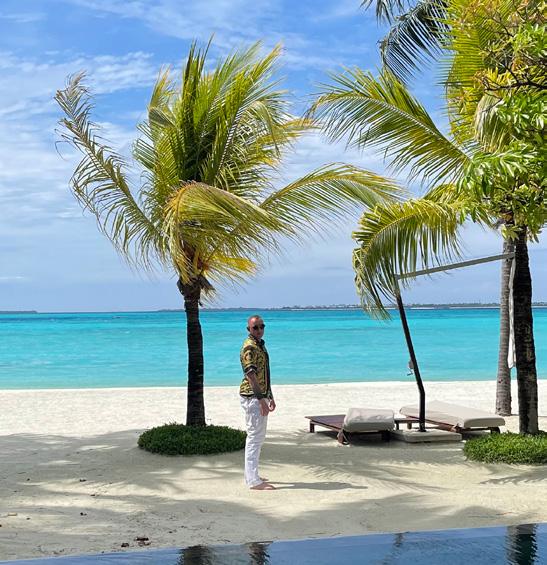

A soft breeze and tropical feeling. Drinking Champagne in my private pool. Ah, how I love the Maldives. Except this isn’t the Maldives most people know about. I’m discovering the youthful and contemporary Patina Maldives, its style and feeling different to the dozens of other Maldives resorts I know. The sunset continues, from turquoise to blazing orange and the silhouetted palm trees of night, as I reflect on what’s so special about this relatively new resort.
My villa feels like cubist architecture, its muted and modern interiors nothing like the exotic hues of the ocean outside. You may think such architecture and design is more suited to a trendy new city neighbourhood. But why should all Indian Ocean resorts look similar? I love the bold and enthralling approach. I know younger travellers will definitely enjoy Patina’s design-led, contemporary approach.
This novel design is a visual representation of the resort’s ethos. Take dining as an example. I spent one evening with my feet in the sand, eating a burger from a food truck. The innovative vegan restaurant Roots wowed me. All of the 12 restaurants have an interesting and creative concept, like the Patagonian steak house Brasa, and modern Japanese Nordic fusion of Kōen. There’s Wok Society, where I enjoy lots of craft beer with Asian food. During a ten-day stay there’s always another interesting food option here.
Activities and experiences celebrate the best of the Indian Ocean, but go beyond the typical ones too. There’s wine tasting, surfing, excellent snorkelling and diving. Visiting the coral marine centre I learnt more about the surrounding wildlife and adopted a coral, part of Patina’s efforts to increase biodiversity. I saw dolphins on a sunset cruise and went fishing on a traditional Maldivian dhoani, before barbecuing the fresh catch on an uninhabited sandbank. The island’s wellbeing philosophy is FLOW and on this serene island, the benefits of using a spa extend well beyond the spa itself. I also try a floating pod, a sensory deprivation therapy that instantly clears my mind. Then a guided watsu session.
In the Maldives, so much of the holiday experience comes from the resort’s atmosphere and essence. With the sunset over I take a walk with my art map. First to Skyspace Amarta, a beautifully lit-up chamber with a ceiling open to the stars, an art piece by James Turrell. Past the evocative photographs of Cássio Vasconcellos titled “The Palms”, the volcanic sculptures of Jose Dávila known as “Los Límites De Lo Posible IX,” and the exquisitely crafted “Home Deep Blue” by Hiroka Takeda. The “Momento” sculpture on the beach also has surreal lines that captivate my imagination. Where will I dine tonight? So many options take my fancy, but for now I enjoy a stroll on the beach, thinking how I’ve fallen in love with this resort. The soft white sand certainly helps amorous feelings. This is the best beach I’ve experienced in over a decade visiting the Maldives.
Patina is located in the North Malé Atoll, an artificial archipelago built in a prime location, only 45 minutes from Malé. It’s far enough away from the noise and crowdedness around Malé, so the Indian Ocean is uninterrupted.Yet it’s close enough for a very convenient holiday. Transfers from Malé are by boat and can be done in the dark, so no holiday time is wasted in Malé or the airport lounge, regardless of flight times. You don’t need a Malé layover so Patina can be convenient for a short stay too. Except, I wouldn’t recommend only a few days. Patina has the comfort, privacy and things to explore for a two-week holiday.
All the villas have private pools. Mine is over the water and is dominated by glorious views. Villas on the lagoon are better for families and anyone demanding complete privacy. Patina’s small studio rooms are ideal for a nanny or other personal staff, without needing to book a second villa.

Patina is part of the Design Hotels collection of owner-operated hotels and I can tell. The design style is very striking, yet it’s the high-quality furnishes and finishes that really make the design. And despite having 90 villas, Patina never feels crowded during my stay. With so many dining outlets and things to do, guests are spread thinly across the large island. It’s great for couples who can be as social or private as they want. There’s space for families, complemented by a very modern kids club: when I visited the kids were using a 3D printer and recycling fishing nets to make jewellery.
Not everyone will have a strong preference for Patina’s design or contemporary approach. This is a resort which I’m sure will evoke strong reactions in every guest. Which is kind of the point. Resorts for everyone are never usually the best for anyone. Patina will be perfect for people who have a passion for contemporary design and luxury. It’s a really youthful and innovative retreat, a completely new experience in a destination where many resorts start to feel the same. It’s a resort to try, regardless of how many times you’ve been in the Maldives before.

Exploring a home far from home, a new private villa experience at a destination within a destination.


A private limousine airport transfer helps establish the mood at the reimagined Malakiya Villas, the most exclusive offering at the world-renowned Madinat Jumeirah. A private pool heightens the holiday feeling. Space abounds and there’s the beauty of silence and stillness, along the iconic winding waterways. These seven Malakiya Villas are the hidden gems of Jumeirah Dar Al Masyaf, fully private spaces to relax and unwind, amid a destination resort that’s always been celebrated for its excellent facilities.
Malakiya translates as “royal” and these villas were built at the same time as the rest of Jumeirah Dar Al Masyaf. They’ve been reimagined recently with a completely new design, a very contemporary interpretation of Arabian opulence. Dar Al Masyaf means “summer houses” and these houses are neatly tucked away, on the lagoon Madinat Jumeirah is famous for. Three other resorts make up the complex, which is a neighbourhood within Dubai, a destination within a destination.
Jumeirah Mina A’Salam is the boutique retreat by the beach, Jumeirah Al Qasr offers a more traditional Arabian palatial style, while Jumeirah Al Naseem is the cool and contemporary beachside retreat. And what a beach these hotels share! Two kilometres of private beach, with the Arabian Gulf stretching beyond the horizon and a view onto the iconic Jumeirah Burj Al Arab. Guests at the Malakiya Villas enjoy a private beach cabana too.
Guests across Madinat Jumeirah have access to over 20 restaurants, 20 swimming pools, an award-winning Talise Spa and J Club offering a complete range of sports facilities, including rock climbing and padel courts. There’s the Wild Wadi Waterpark, shopping in the traditional Souk Madinat Jumeirah, and the peaceful lagoon that connects it all. Malakiya Villas have a private abra station, so it’s possible to go almost anywhere without walking, in one of the traditional Arabian abra boats. Globally, there are few resort complexes to rival the breadth and depth of facilities and services on offer here. This has always been a destination resort for people seeking a relaxed holiday that can still offer many things to do. The reimagination of the Malakiya Villas provides heightened exclusivity and privacy within the large resort.
The other highest accommodations to consider are the Royal Three-Bedroom Suite at Jumeirah Al Qasr, the two Two-Bedroom Royal Suites at Jumeirah Mina A’Salam, and the two Two-Bedroom Presidential Suites at Jumeirah Al Naseem. They offer a similar quality and space to Malakiya Villas, which is the newest and provides the most flexibility.

Each of the seven villas is unique and vary most significantly in terms of layout. Villa Zahra has two bedrooms and is all on one, ground floor, whereas two-bedroom Villa Dana is split across two floors. Villa Tala has three bedrooms, two downstairs and a romantic top floor space with a bedroom opening onto its separate sun terrace. The three-bedroom villas Mahra and Ayla, meaning sky and moonlight, have larger social areas downstairs and two bedrooms upstairs. Three-bedroom Villa Sama has social areas both upstairs and downstairs. At over 650 sqm the Royal Malakiya Villa is the largest, spread across three floors with an enormous top floor sun terrace. All villas have a kitchen and en-suite bedroom for guests’ service staff. Check-in is done inside the villa and of course there’s dedicated butler service. Additional amenities include in-villa breakfast and signature afternoon tea, daily apéritifs and picnics by the beach.
The seven Malakiya Villas are homes far from home, with the comforts and luxuries demanded by discerning travellers. There’s a villa to suit any traveller and mood, whether long or short stay, family, couple or friends. With its stunning beach and excellent facilities, Madinat Jumeirah is already established as one of the best destination resorts in all of the Middle East. Now, with Malakiya Villas, there is a private villa experience at the heart of the resort. And that’s something very exclusive and rare in Dubai.


EliteVoyage CEO Petr Udavský holidays in Nepal, discovering the highest point of them all.

Everest glows in the morning light. It’s right there. Almost like I can touch it. We fly alongside the peak, above the mighty Khumbu Glacier and beyond the scattered tents of base camp. The helicopter touches down on a remote Himalayan mountain where a lavish breakfast table has been prepared. I have a perfect view onto Mount Everest, a perfect 270-degree view onto many of the world’s highest mountains.
Of all my lifetime travel experiences, this is singularly the most impressive. So I think the local Nepali word for Everest is most fitting: Sagarmatha. It means goddess of the sky.

Of all my lifetime travel experiences, this is singularly the most impressive.
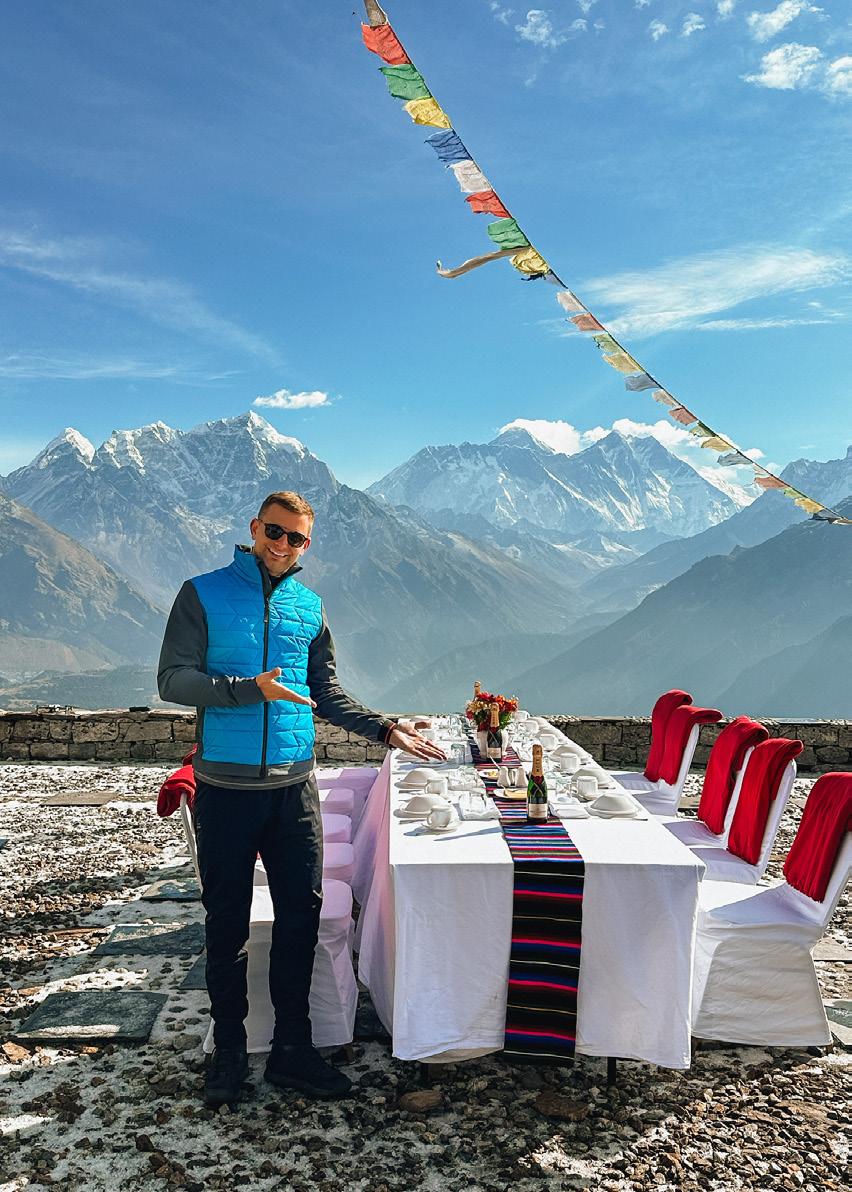


My Nepal adventure started four days ago in Kathmandu, a city of chaos and calm. At first it was completely crazy. Cows lying in the road, cars going everywhere, everything happening on the streets. The city is clean compared to other Asian cities and most buildings are repaired after the 2015 earthquake.
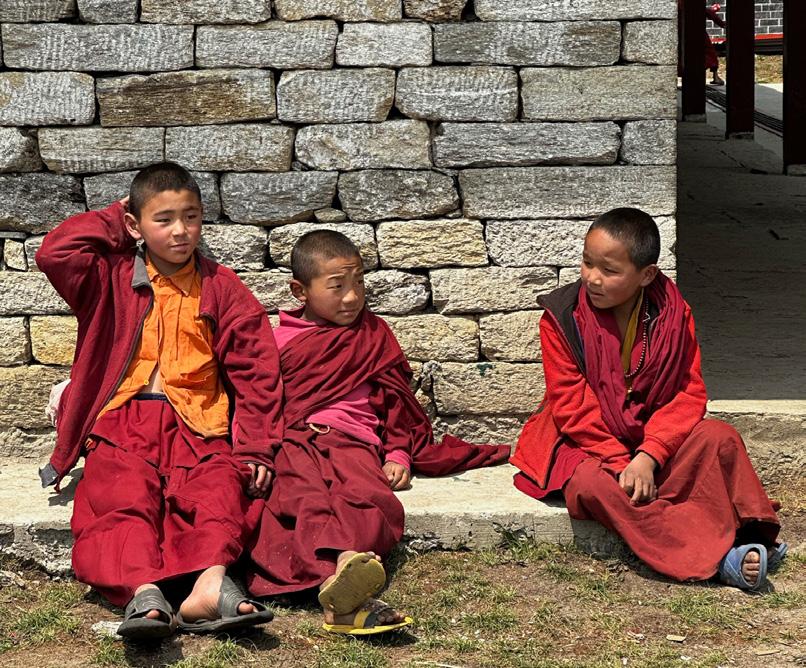
I wasn’t expecting Kathmandu’s best hotel to be located on a very busy street. So what a nice surprise to enter Dwarika's Hotel! It’s a tranquil oasis in the city, the street noise immediately fading away. My first impression was of something extraordinary. Terracotta and
intricate woodworks dominate the facade, reflecting both Hindu and Buddhist beliefs. The hotel is a living museum of local Newar culture, thanks to its founder, the visionary Dwarika Das Shrestha. In 1952, Dwarika noticed carpenters chopping down beautiful wooden columns and decided to save them. He knew that the past is the present and he had a vision to preserve the future. Using recycled antique materials and these hand collected artefacts saved from destruction, he constructed his hotel in the 1960s. It is a showcase of Nepalese history and art, plus proof of human passion.

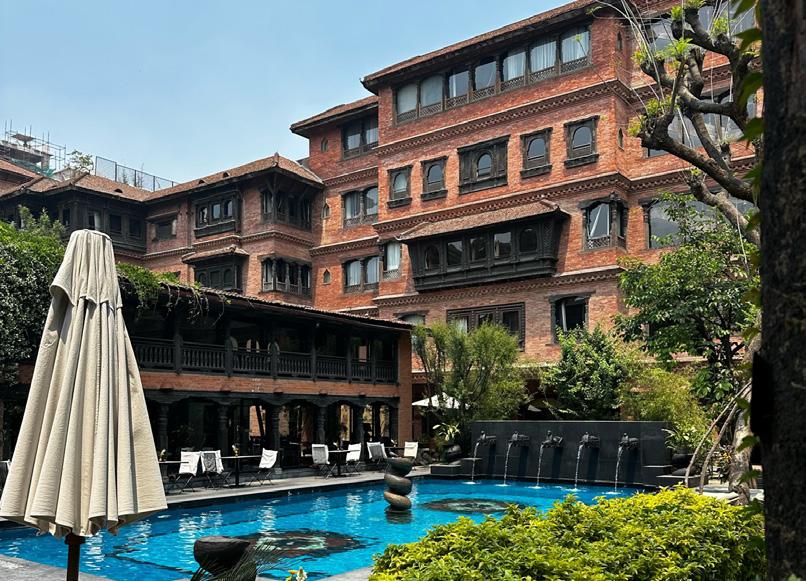
Dwarika’s grandon now manages the operations and I am certainly not the only one charmed by it. During my stay I met Richard Gere. Nepali-British mountaineer Nirmal Purja was also among the guests (best known for the documentary film 14 Peaks: Nothing is Impossible.) The hotel is a magnet for famous and interesting people coming to Nepal, attracted by the convenient location, reliable level of luxury, and most importantly, the unique story woven into its walls.
Dwarika’s exudes calm. And when I went back to the street it’s madness again, mostly in a good and interesting way. Kathmandu has a really nice atmosphere, everyone smiling and helpful. We visited temples, pagodas and historic structures, like the impressive white stupa of Boudhanath. Everything happens on the streets, their energy and colour another highlight of my three days in the city.
Kathmandu is an important layover destination for any Nepalese adventure, as well as trips to neighbouring Bhutan. Nepal has spectacular, otherworldly landscapes, completely different to anywhere else I’ve travelled. On my first day I enjoyed a scenic one-hour flight across the Himalayas in an ATR aircraft. It was a thrilling introduction and I recommend it for people who want to see the Himalayas, but don’t have time to visit them. I felt privileged to see so much on one flight.
It’s possible to explore these mountains without being a mountaineer. From Kathmandu we flew to Phaplu, a tiny village in the Everest region, where everywhere is remote. Village is too strong a word, as Phaplu only has a few houses, an airport, regional hospital and restaurant. Happy House lodge also took me by surprise. How could such a beautiful oasis be created so far from anywhere?
It’s a traditional Sherpa house converted into a mountain retreat with ten rooms and a beautiful garden, a favourite of the world’s mountain literati, including Sir Edmund Hillary among others. Every single wall was painted by hand in the ancient Buddhist Thangka style. And it’s the staff that best symbolise the lodge’s happy name.
Young monks cooked us a lunch of rice and vegetables grown on their farm, at Chiwong Monastery Solukhumbu, a 40-minute uphill drive from the lodge. It felt very authentic to experience how monks are living in these mountains. Then the serene three-hour walk back to the lodge inspired me to visit Nepal a second time to hike a lot further.
What a nice surprise to enter Dwarika's Hotel. It's a tranquil oasis in the city and my first impression was of something extraordinary.
From the Happy House helipad we departed at sunrise for Sagarmatha, first flying over Namche Bazaar, then alongside jagged peaks and towering summits. Four of the world’s six highest mountains are here - Lhotse, Makalu, Cho Oy and Everest - and when confronted with their awesome power I feel humbled by nature. The weather is fantastic and I don’t only glimpse the goddess of the sky. We touch down at a place called Kongde, at an altitude of 4,250 metres. And I have a Champagne breakfast with her, along with my friend Quentin Desurmont, President of Serandipians (read The Trend Maker in Explorer Edition I, page 30). Local cheese, ham, eggs, bottles of Champagne and the greatest vista I’ve ever experienced, looking perfectly onto the world’s highest mountain.
Another exceptional property completes my Nepal adventure. Focused on yoga, meditation and spa, Dwarika’s Resort Dhulikhel sprawls across the hills, around one hour above Kathmandu. My trips end
here as Quentin continues to the Manaslu region. The Upper Dolpo and Mustang regions are also options for mountain adventures, plus there are rhinos to see on safari in the south. September to November and March to May are the times to travel, as summer brings a monsoon and winter is too cold.
Relaxing in Dwarika’s spa pool, I reflect on my short adventure. I expected Nepal to be beautiful. Yet photos can’t do justice to the feeling of being immersed in such rare power and beauty. Nothing could ever prepare me for the scale and stature of these mountains. I expected the adventure. Yet it was most revealing to experience how Nepal offers adventure, with a lot of comfort and luxury. Dwarika's is an excellent example of this. Well-appointed and spacious rooms, authentic architecture and atmosphere, plus top-level service.
So I sit back and listen to the silence of the hills, remembering once more the goddess of the sky.
Lhotse, Makalu, Cho Oyu and Everest: when confronted with their awesome power I feel humbled by nature.
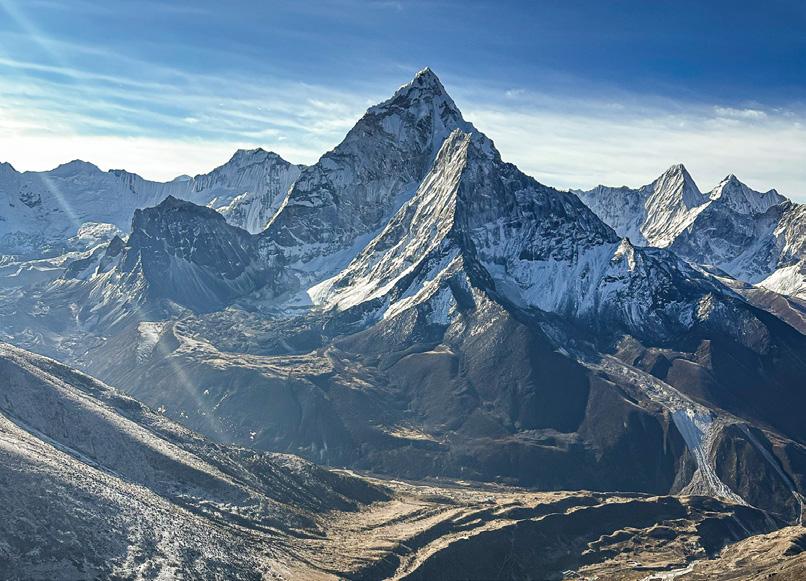
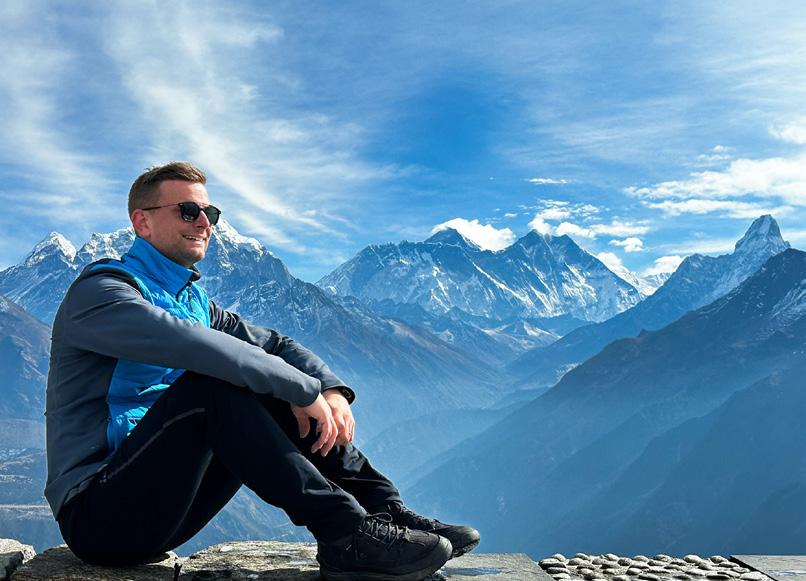


very private and barefoot family holiday for all ages?

Saint Martin is part Dutch, French, Creole and much more, an alluring island with the best travel connections. Start here.

Anguilla feels quintessentially Caribbean to first-time visitors, the culture laid-back, exuberant and proud. And wow, what awe some beaches!
St. Barths is like a Riviera in the Caribbean, where resorts, boutiques, harbours and restaurants are all places to be seen.
Rugged, volcanic, and perfect for sailing, the British Virgin Islands are home to exc lusive island retreats and uninhabited islets.

Sand islands, coral reefs and the most turquoise of waters define Turks and Caicos, an archipelago best combined with the headline destination of Explorer III, the USA.
Antigua is the essence of the Caribbean: rum-infused mellowness, wide smiles, hun dreds of spectacular beaches and coves.
December to May is the best season for a Caribbean holiday. It’s pical, with that exciting sense of adventure for all ages. Holiday here with parents and kids, as a here with anyone who appreciates beach bliss somewhere new.







Nice beaches, colourful low-slung architecture and warm Mediterranean-esque vibes. Saint Martin is a very welcoming island and key for travel logistics.
The most convenient flights from Europe to the Caribbean land at Princess Juliana International Airport on Saint Martin. KLM and Air France operate daily in season, meaning good two-leg flights from Central Europe. Saint Martin is also the best connected hub for onward travel in the region.
It’s also a relaxing place to layover, a melting pot of Creole, French, Dutch and other cultures, with lovely beaches too. Explore contrasting gastronomy, the charming little towns and secluded coves. Or just sit back on the beach and by the pool.
















A calm atmosphere and a long white sandy beach. Two reasons why this iconic hotel is ideal for the start or end of a Caribbean holiday. It’s only 10 minutes away from Maho Beach too.

Suites have a prime beachfront location, plunge pools and rooftop porches, while multi-bedroom villas stand on the cliffs and are ideal for large families. Enjoy Belmond Bellini Club benefits when booking through EliteVoyage, like resort credit and complimentary upgrade upon availability.

A sleepy island of white beaches and gorgeous reefs, where the vibe is somewhere between barefoot holiday chic and archetypal Caribbean culture.
Anguilla is seafood shacks, barbecue joints, calypso competitions and rum cocktails. It’s also a laid-back island of beaches and bluffs, with a long history of traditional luxury hospitality.

From Saint Martin to Anguilla it’s a short boat charter and road transfer to one of the best resorts. It’s a small island, where even the quietest, least explored coves are within easy reach by car or yacht.



















Anguilla’s largest resort is an extremely family-friendly and predominantly US orientated getaway, above two excellent beaches. Service is as modern and efficient as the clean-lined interiors by Kelly Wearstler.

Multi-bedroom penthouses and villas combine with the island’s widest range of facilities and activities, making it especially ideal for holidays with kids, parents and grandparents together. There’s great dining too.
Intimate and cosy, a vision of barefoot luxury that defines many Caribbean dreams. Cap Juluca looks like Moroccan opulence, yet the traditional Anguillan feel helps to make this the island’s finest place to stay.
Cap Juluca is a long-time favourite of Explorer magazine and guests booking via EliteVoyage enjoy exclusive Bellini Club benefits. For more about Cap Juluca see Explorer Edition II, pages 76 - 79.














Mysterious volcanic islands soaring from Caribbean turquoise, some privately owned, many uninhabited. A destination of secretive retreats, an ocean away from prying eyes.
Accept the invitation into another world, an immersion in indulgence and wild landscapes. With so many deserted islands, cays, bays and reefs, a day on a private yacht is the classic experience. A multi-day charter is even better. Often it’s the rarest of pleasures most fondly remembered here: silence.
Multiple daily flights connect Saint Martin with Beef Island and yacht transfers complete the journey. Private jet charters to Beef Island offer excellence value and save significant time and stress.
EXPLORER by EliteVoyageIt took four years and USD 185 million to rebuild this beachfront beauty after Hurricane Irma. And what a rebuild! A contemporary interpretation of rustic, unpretentious luxury, with highly individualised rooms and a vibe from a vintage sixties jetset movie.
Families and couples will find the space they need here, especially at the suites with private pools on the quieter western side. A day could involve snorkelling with hawksbill turtles, a session in the hilltop spa, then conch and callaloo in coconut sauce at The Sugar Mill. And a stay booked with EliteVoyage will include exclusive Rosewood Elite benefits.
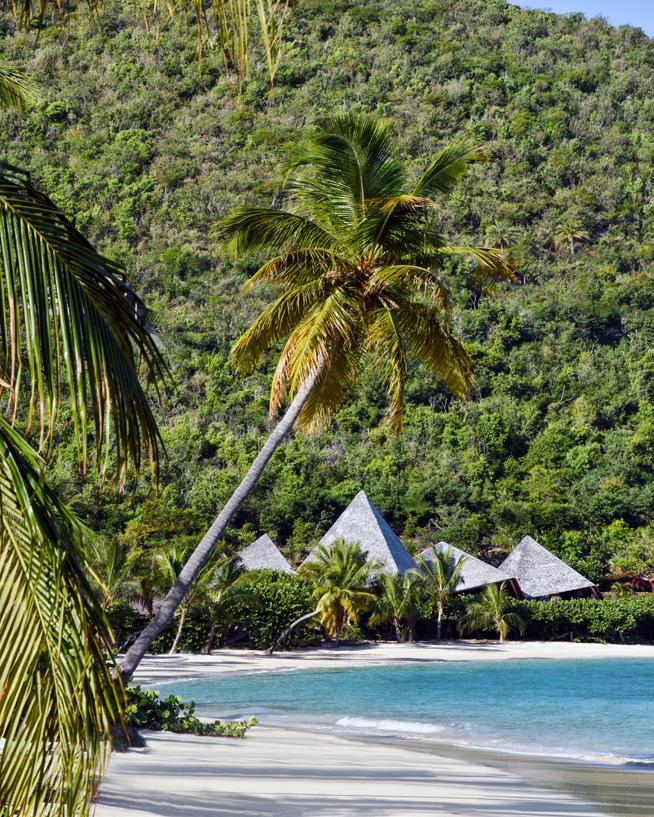

British entrepreneur Richard Branson invites guests to feel at home, at his home, an extensive private island of reefs, beaches, lemurs and tortoises. Stay in Balinese houses and dine with other guests each evening, a social element to an adult-focused getaway.
This is a destination to build a holiday around, only available on a room by room basis during select celebration weeks each year. For 2023 - 2024: 16 - 30 September, 14 - 25 October, 18 - 25 November, 1825 May, 20 - 27 July.
Richard Branson also rents out his Branson Estate on Mosquito Island, with three standalone villas and a private beach for 22 guests.



Dozens of hidden coves. Welcoming locals with huge smiles. Slow-paced island life with smart cocktails, bright colours and lazy days. A British history and feel remains, but Antigua is much more calypso, steeldrum, fungee and pepperpot (a slow-cooked one-pan meat stew).
Antigua is geographically dramatic and culturally Creole, an island that defines a region in many ways. It’s also home to two of the most exclusive all-inclusive island resorts in the world.
Start each day without a plan, because spontaneity and freedom define Antigua. Everyone, of every age, will find something to savour and remember.

A large car-free island, 10 minutes north from Antigua by boat, only 20 minutes door-to-door transfer from the island's airport. Everything is indulgently spacious, just a handful of suites and villas scattered across the island, plus three excellent restaurants, spa and kids club.

Jumby Bay is all-inclusive and very exclusive, the house Champagne being Moet & Chandon, the cocktails and fine wines complemented by a huge variety of dining experiences.
Water sports are included too, plus daily expeditions and activities, from Creole cooking to sunset on a yacht. It’s an island for doing nothing, or an island for trying everything.
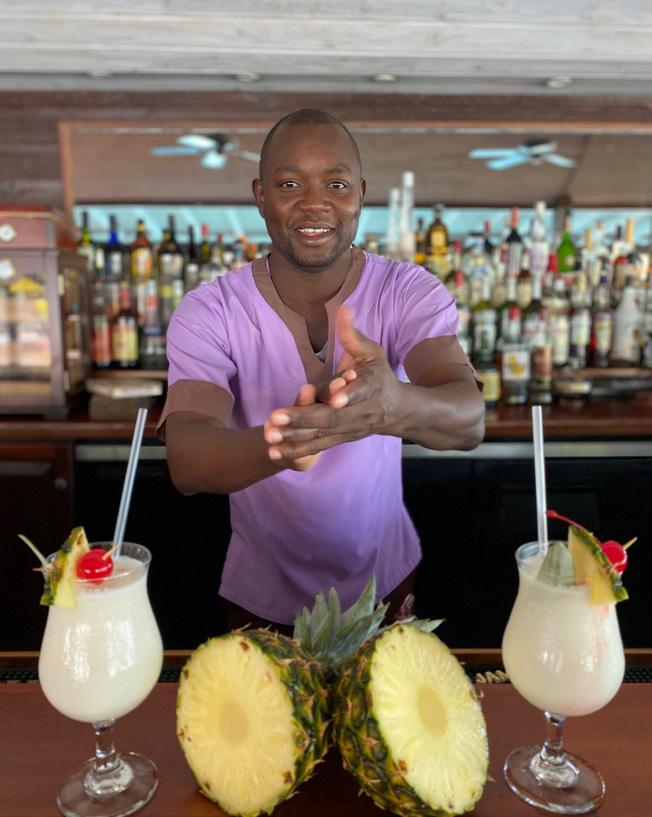
A Caribbean heart beats strongly at Hermitage Bay, an all-inclusive property reflecting the peace, warmth and beauty of the surrounding sea. This is an island retreat, done in an unspoilt and soulful Caribbean style.
There are only 30 suites and an atmosphere attracting honeymooners. Hillside suites are the most private, have the best views, come with a private pool and outdoor showers.
It’s a place to rest and revitalise, as well as a base to go out exploring. The resort’s location, surrounded by wild and undeveloped hills, adds to its exclusivity.
A French Riviera style and ambiance, in an exotic and tropical setting. St. Barths has long been the Caribbean island to be seen, on powdery white beaches, exceptional restaurants, designer boutiques and superyachts anchoring in Gustavia harbour.
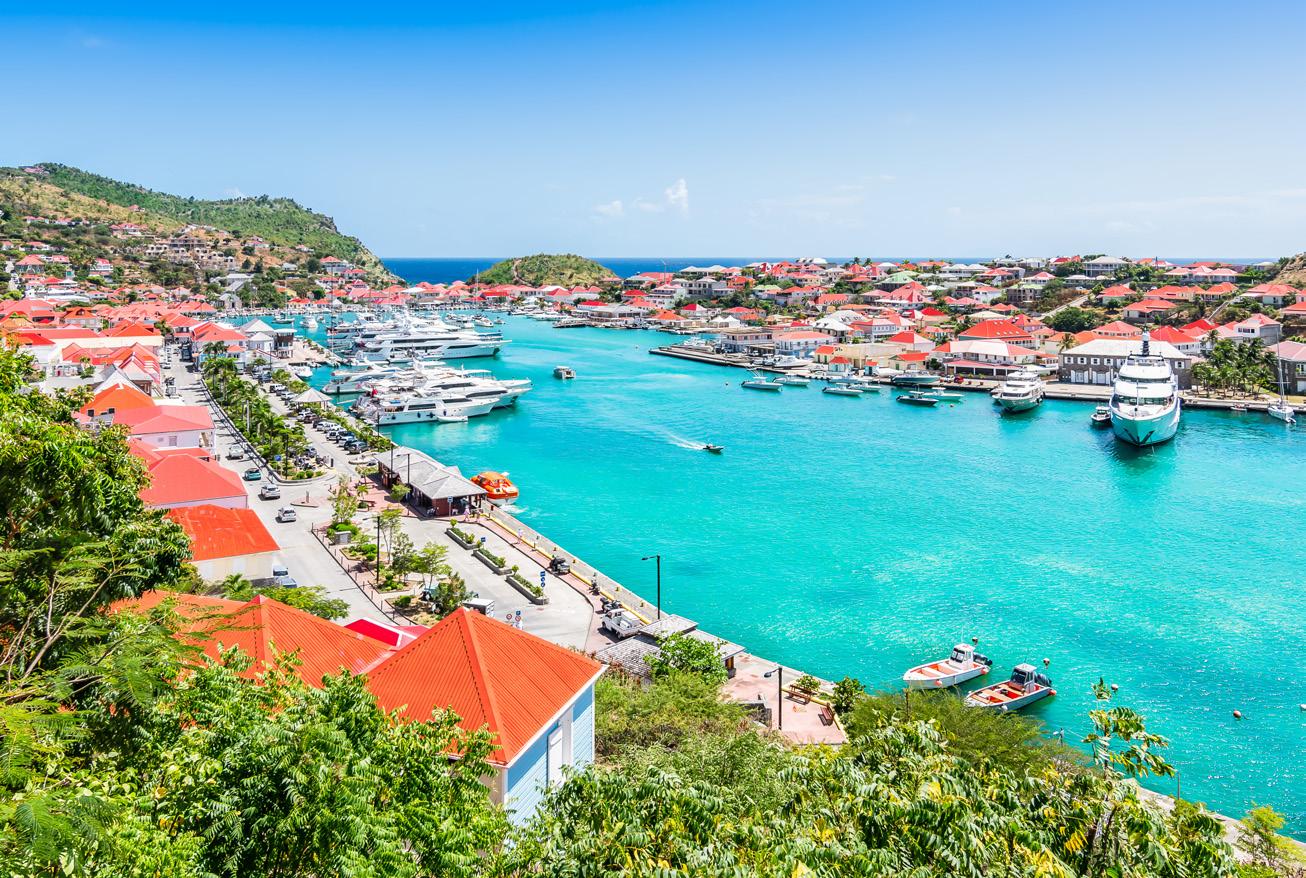
Refined resorts provide the base for exploring this playground of jetsetters: think snorkelling, yachting, shopping, beaches, dining or even hiking.
From Saint Martin it’s a 90-minute to two-hour yacht charter to St. Barths, depending on sea conditions. The waters can be choppy. Scheduled and private flights between the two islands are shorter and typically preferred.














Opulence and elegance define this quintessentially French property. Think Guerlain spa, barefoot palatial living, beach suites, space for some adult mischief and the best gastronomy on the island.


Cheval Blanc is increasingly for children too, for the treasure hunters, and pirate dreamers visiting the Caribbean. Think baby body massage, post-pregnancy spa treatments and baby swimming lessons too.














Space is the first impression at this recently reimagined resort, which stretches across two beaches on an island peninsula, making it naturally private too. Once a famous celebrity hangout, it’s now the hotel of choice for well-travelled discerning visitors, particularly young families.
The vibe is Caribbean energy, tropical colours and a sense of fun. And it’s the island’s most private resort. Read an interview with Managing Director Martien van Wagenberg in Explorer Edition III, pages 107 - 108.









White sandbanks and small coral islands, scattered across the north of the Caribbean Sea. Turks and Caicos creates a private island resort holiday experience, where the highlight is doing nothing at all with loved ones.





Providenciales International Airport is better connected to the United States than the rest of the Caribbean. Make it a city plus beach holiday from Europe, with New York, Boston or Miami. Private jets are necessary to connect Turks and Caicos with other Caribbean islands.
These islands were hidden gems. Now the secret is out, although exclusivity remains and there’s the privacy demanded by both couples and large families.
EXPLORER by EliteVoyage
A wild island now inhabited by a stylish boutique resort. It’s understated and tranquil, one of the truest private island resorts in the entire Caribbean, at once a wellbeing retreat, place of adventure, and home away from home for a large family, COMO Parrot Cay is 50 minutes by boat from Providenciales and its beach houses and villas are vastly spaced on the white sand. All feature private pools and can accommodate families of different sizes. Few places are better globally for a beach holiday combining kids, parents and grandparents.














Hidden on the white shores of a huge nature reserve, this is the archipelago’s most exclusive and spacious resort. It’s a retreat for all ages, especially good for families of multiple ages on a beach holiday together. Multi-room villas with black infinity pools are the standout accommodations. The experiences are many: tailored wellness programs, scuba safaris, horseback rides, fishing charters, and lots for kids.

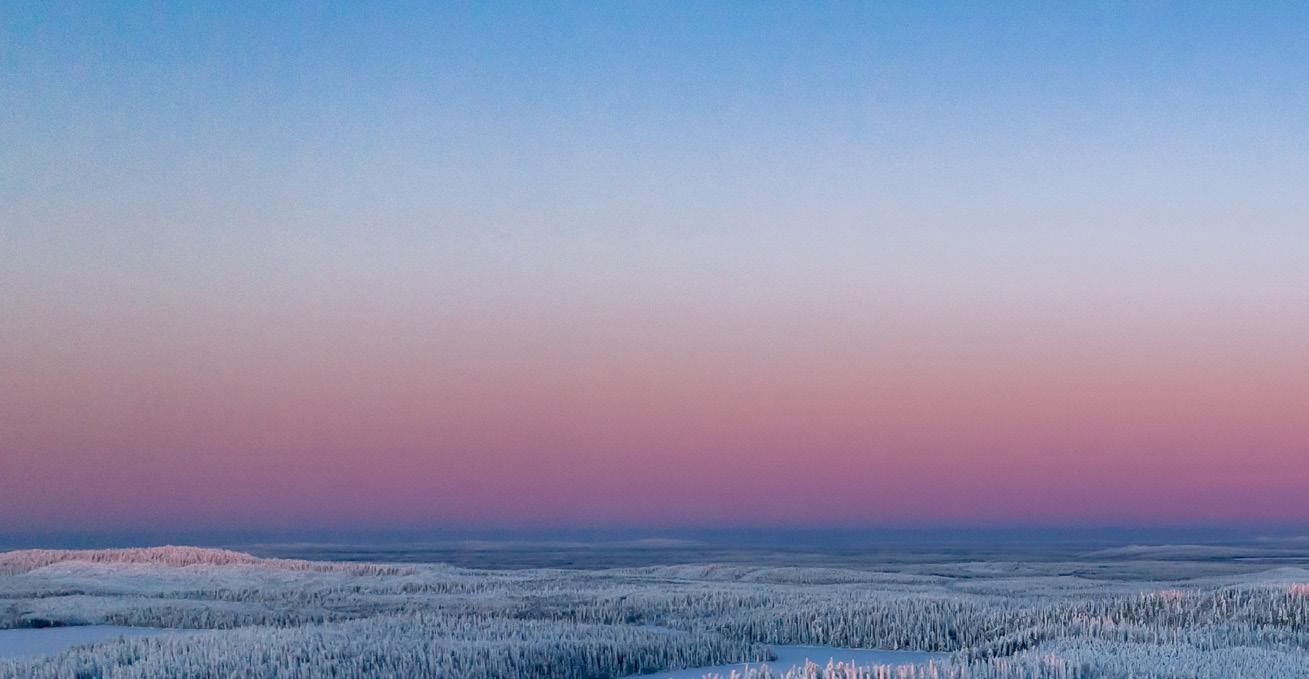

Lapland is a mostly untapped and accessible alternative to traditional winter destinations in the Alps. Go north in winter and there’s skiing, plus a lot of new experiences too.

Explorer sits down with Javier Chiquilla, co- founder of Nexus Polaris DMC, and Štěpán Borovec, project and operations director at EliteVoyage, to talk about northern lights, skiing, santa, snow and sleeping in igloos.

What do you personally find so special about Lapland?
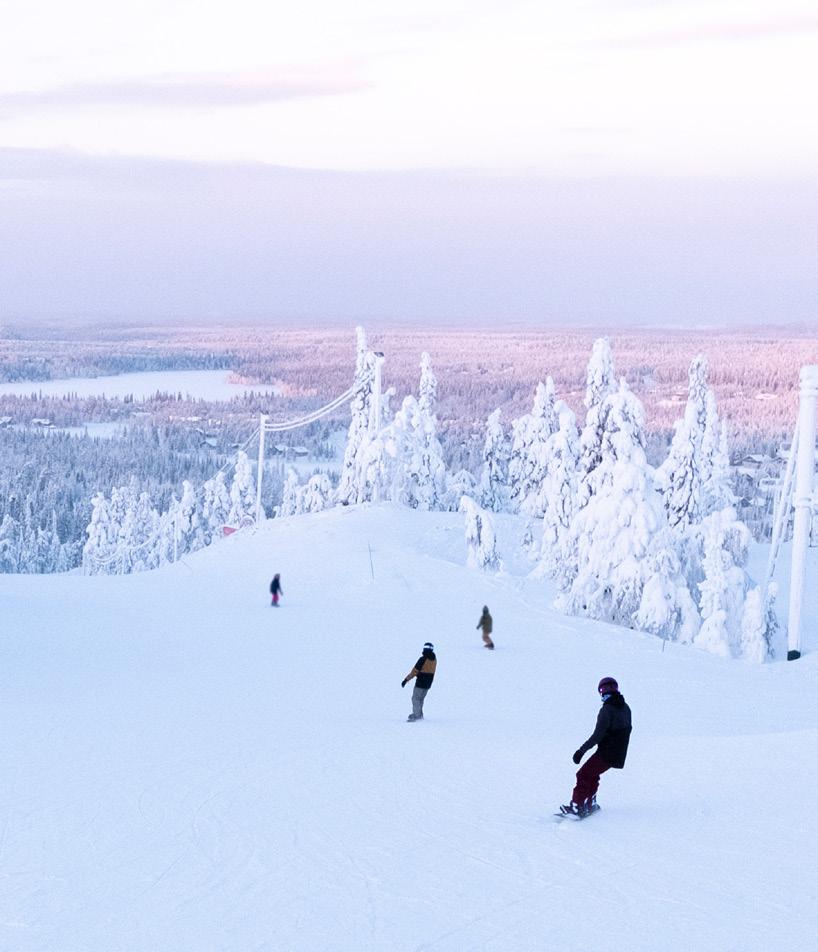
Javier: The experiences with nature. They’re very different from the Alps. Like sleeping in a glass igloo in Finland and looking up at the northern lights.
Štěpán: The snow! Climate change threatens the future of skiing in the Alps and when our clients go to Lapland they always enjoy thick snow. It’s amazing how such a big region has all this consistent snow and not so many visitors.
Javier: It’s what you can do on the snow too, like meeting reindeer. We love to arrange different activities each morning, to have this relaxed morning with nature, before skiing in the afternoon.
Javier: It’s very special to combine skiing with other activities and then the aurora at night.
Is the snow and skiing different in Lapland to the Alps?

Javier: In Finland we have seven different villages with ski slopes and we can offer every level of skiing. Levi is the largest and the best known. In Finland you don’t ski big mountains like in the Alps, but they’re still great slopes peaking at around 500780 metres high. These are great for the full variety of ski activities: alpine, freestyle, snowboarding, cross country and snowshoeing. There’s this new thing, electric snow scooters, like a cross between skiing and snowshoeing for experienced skiers.
Štěpán: Sweden and Norway have the big mountains. I used to live in Canada and that’s my kind of skiing! High-altitude, wide-open powder runs and short, adrenalin-pumping steeps! Swedish and Norwegian
Lapland are definitely more suited to advanced skiing, to going out with helicopters and creating the first tracks in fresh snow.
Javier: Iceland is also about heliski and extreme skiing. It’s not Lapland but the experience is similar to somewhere like Riksgrandsen, which is on the SwedenNorway border. In Riksgransen you can do 8,000 vertical metres a day and the guides have almost complete freedom with the heliskiing, as they’re not restricted to a predetermined schedule of landings like in the Alps.
Štěpán: Riksgransen is pretty extreme and you need to be an advanced skier! Most of our clients are going on ski holidays with their family. Finland is family heaven, with all the services fully adapted to children and all the other experiences beyond skiing, which can suit all levels.
Isn’t Santa from Finnish Lapland? No wonder children love it!
Štěpán: Santa is from Rovaniemi where there are lots of tourist services, including the main airport for visiting Finnish Lapland. The feedback from our clients is always the same. Children absolutely loved the holiday in Finland, so the parents had a fun and relaxed time too. But Santa is just one part of the experience, not the main family memory afterwards.
Javier: How many times can you meet Santa? What’s so nice about Finland is families can do something really cool and unique together, every single day. Like going out on a dog sled or crossing a frozen lake in an electric snowmobile. We can arrange for Santa to arrive at a private villa on his sled, to meet your kids. The next day you can actually go out on a reindeer sled, have this private family experience in nature. It’s an experience that everyone in the family can share and enjoy.
Santa must be in high demand in and around Christmas. When is the best time to visit Lapland, for skiing and these other experiences?
Štěpán: Late season in Norway and Sweden is fantastic. It’s possible to ski there throughout April, sometimes in May too. The snow is far more consistent throughout the entire season, which takes away some of the stress that’s impacting holidays in the Alps. This year we had clients who had to cancel their ski trips in the Alps, because it was too warm and rainy.
Javier: Levi in Finland hosts two FIS World Cup races in November. Some of the world’s alpine stars are training there in October. However, I recommend visiting Lapland later in the season. The unique experiences are possible all winter, but the later you come the more hours of daylight you have. In March it’s around ten daylight hours. And in the evening there are the northern lights.
Štěpán: Rovaniemi does get pretty packed for Christmas with Santa and all!
Javier: Everywhere in Finnish Lapland will be busy in December and if you come in January there are only around three hours of daylight. February is better, March is the best and the ski season continues into April. This year we had fresh snow around Levi in June. The northern lights season overlaps with the ski season, the sky coming alive from August to the end of March. It’s very special to combine skiing with other activities and then the aurora at night.
Ski holidays have always involved a little bit of good fortune, as it’s impossible to predict the exact weeks when conditions will be perfect. Is Lapland any different?
Štěpán: Lapland is a lot colder than the Alps, after all, it’s in the Arctic Circle! It can be around -10 in the day and lower than -20 at night. But mostly it’s a dry, comfortable cold.
Javier: Of course the weather is unpredictable so we have to be flexible. We provide a private host with a car for clients, so we can follow a schedule more than less, but when a client wants to go skiing in five minutes we can take them. We’re continually checking the conditions and how many people are around different slopes, so we can always take people to the best slopes given the conditions and crowds.
Štěpán: Our clients skied in Levi in March. They told me that most of the time the slopes were quite empty. We all want a fresh dump of snow immediately before we arrive, then clear blue skies for a week of skiing. I like Lapland because there is always snow and when you can’t ski, there are other things to do.
Javier: We can easily split a group too. So if some want to grab a coffee, do some shopping, try something else, and the others want skiing, we can do it.
Is Lapland a luxury destination? Does it have the high level of resorts in the Alps like Courchevel, Megève or St Moritz?

Javier: People don’t realise how luxurious we can make it in Lapland, they think about Santa and Rovaniemi. When it comes to skiing we have services up to the standards of Courchevel and other places in the Alps. People also need to realise that the prices in the north will be more than in the Alps in the south.
Štěpán: Lapland offers a different style of luxury too. You can shop but it’s not like Courchevel. Lapland is less about designer boutiques, famous penthouses and places to be seen. It’s about space, freedom, nature, all the exclusive experiences you won’t find in the Alps.
Javier: Some of the ski resorts are for mass tourism in Lapland, just like elsewhere. So we must be very careful about where we take clients and the quality of the accommodation. Finland was the first place to offer special accommodations like igloos. It’s an experience you don’t find in other places.
Isn’t it a little bit cold to be sleeping in an igloo?
Javier: We only work with four places which have igloos. Levin Iglut is very special, where you have these en-suite glass igloos, with a jacuzzi outside. I only recommend the suites, they are simply the best igloos in Lapland. The hotel is on the top of a hill so you will see northern lights for sure. It’s such a clear view from the igloo, you don’t need to get all dressed up in warm clothes to see the sky.
Štěpán: Ice Hotel in Sweden is very famous, most people want to try it. You sleep on a bed of ice, in an ice suite sculpted by an artist. It’s a dry cold and quite comfortable with all the reindeer furs on the bed. But it’s too cold for an en-suite bathroom or a place for your luggage, so there are separate, dry, changing areas. I only recommend one night for the experience, then staying somewhere else.

Javier: Finland was the first place to offer special accommodations like igloos. It’s an experience you don’t find in other places.
What other accommodation do you recommend in Lapland?
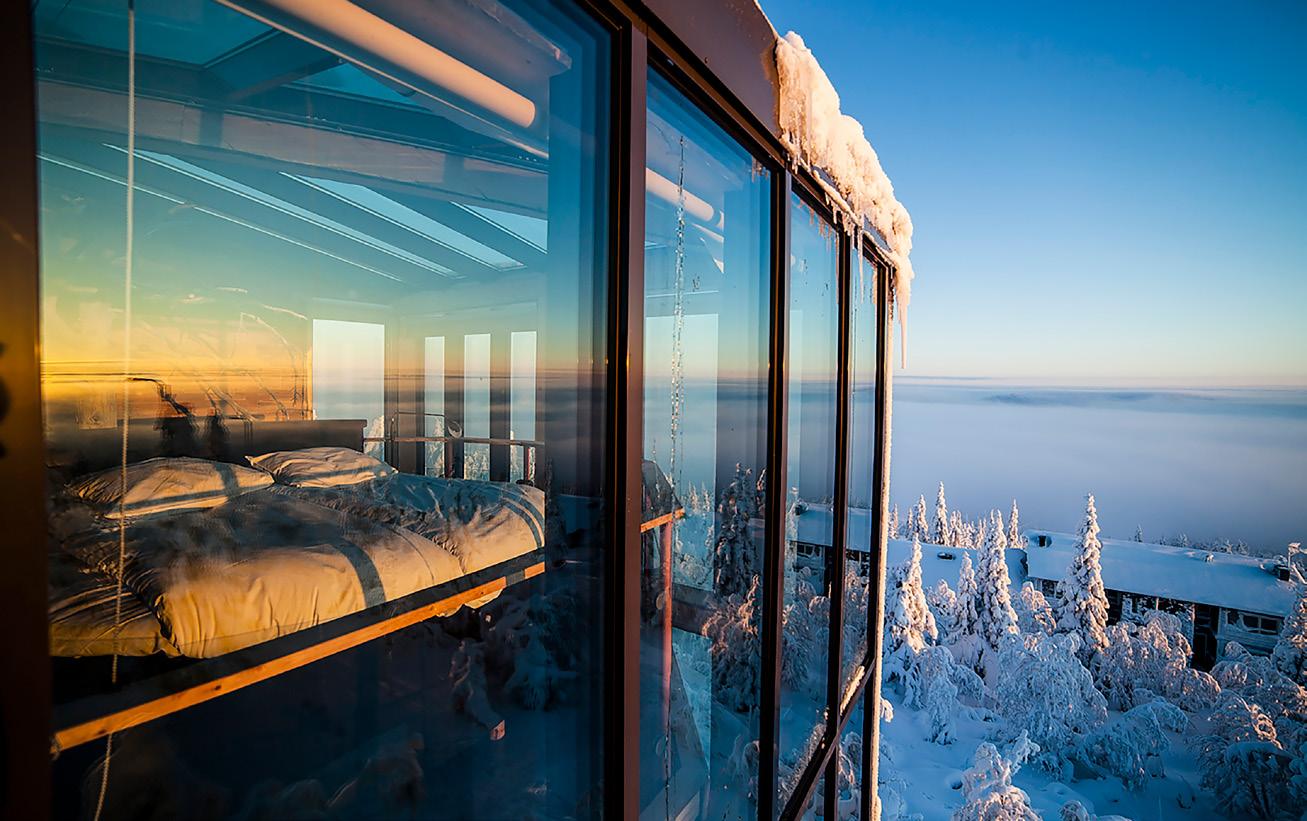
Štěpán: When our clients want skiing in Lapland we usually organise private chalets and villas. Copperhill Villa is a nice one in Sweden, a private ski lodge for up to 16 people, with a very bold Scandinavian design.
Javier: Skabma Villa in Finland is in a more traditional style, a premium loghouse in Saariselkä. There’s all the silence and peace of northern Lapland, with nature stretching out from the doorstep, barely 200 metres from a ski track. Yet it’s also close enough to the village and different services.
Štěpán: In Sweden, Treehotel is a must. It’s so unique, all these unusual treehouses in the forest. The best accommodations in Sweden are in very isolated places where there’s no light pollution, so seeing the northern lights is part of the experience.
I like Arctic Bath, a floating spa hotel designed by Bertil Harstrom, who also designed Treehotel. Niekhu Mountain Villa in Riksgransen is a place for experienced adult skiers, great for combining heliskiing with food and wine. In Norway they have more normal accommodations, like log cabins and chalets. My favourite is Wolf Lodge!
Javier: Iso Syote hotel in Finland is also a really awesome place, not known to international travellers. It’s a little south from Lapland in one of the snowiest parts of Finland, within reach of Oulu, Kuusamo and Rovaniemi airports. The suites make it one of my favourites in Lapland, especially the Eagle View Suite. Its walls and roof are made of glass and there’s a private sauna. A tree grows up to the second floor and the branches support a bedroom, or ‘nest,’ with a phenomenal view.
What about transport connections? How do you get to Lapland and how do you get around?

Javier: With commercial airlines it’s a one-stop flight from most places in Central Europe. You will fly to the capital city - Helsinki, Stockholm or Oslo - then fly north. We don’t have that many commercial airports in the north so there will be a road transfer too. Kiruna to Riksgransen in Sweden is the longest and it’s a little under two hours. In Finnish Lapland it’s a short transfer from the airport to the resort, usually around 30 minutes in normal conditions, definitely under one hour.
Štěpán: Private jets are so valuable for a Lapland trip. They really maximise time and make Lapland a real possibility. With a private jet you depart at the time you want and fly directly to the airport nearest your accommodation. Just be prepared you will most likely have to pay extra for de-icing!
Javier: There’s much more flexibility with private jets, it’s not just about skipping the airport layover. We have more airports to choose from. Like Pudasjarvi for Iso Syote Hotel, Ivalo or Enontekio for exploring the far north of Lapland. For skiing in Levi, having a direct flight to Kittila rather than using Finnair from Helsinki means at least one extra day of skiing and experiences.
Štěpán: There are some important considerations. We typically recommend aircraft like Citation Sovereign and Longitude, Gulfstream G200 and G280, Pilatus PC-24, or Citation XLS + for ski holidays. They offer good cabin and luggage space for six to eight people, plus a good combination of range and price. So for Lapland there are no refuelling stops. We’re monitoring every jet charter on the radar, so in the rare cases a flight is diverted due to a storm or bad weather, we are ready with a solution if a client lands at an alternative airport.
Javier: After you land the roads are empty, except when we have reindeers on the road. There are strict laws so we can’t honk to get them off the road!
Štěpán: We typically recommend aircraft like Citation Sovereign and Longitude, Gulfstream G200 and G280, Pilatus PC-24, or Citation XLS + for ski holidays.
Finally, enlighten us on how the two of you work together to create a trip to Lapland.
Štěpán: Along with our travel designer team, I’m helping create trips to destinations all around the world. In one day I could be working on Greece, the Komodo islands, a safari in Kenya and skiing in Lapland. I know the destinations and I know client feedback from these destinations, but I can’t have such an intimate knowledge about everywhere in the world.
Javier: Stepan knows the clients, knows their preferences and requirements. He communicates this to me and together we brainstorm the best holiday ideas. I have no idea about Kenya or Komodo. But Lapland is my playground so I can suggest something different for every client.
Štěpán: For every destination we cooperate with a local specialist on the ground, a partner like Javier. Somebody I trust completely, somebody who shares our dedication to quality. Our clients are demanding and I’m very demanding of our partners. I love working with Javier because he’s also very creative, always able to find a solution, always thinking of a new way to enhance a trip.
Javier: Lapland isn’t the easiest destination, that’s for sure. There are many variables and there’s a lot you can only know when you come here. Sustainability is very important for us so it’s nice to work with Štěpán and a company who share a longterm vision for sustainable travel.
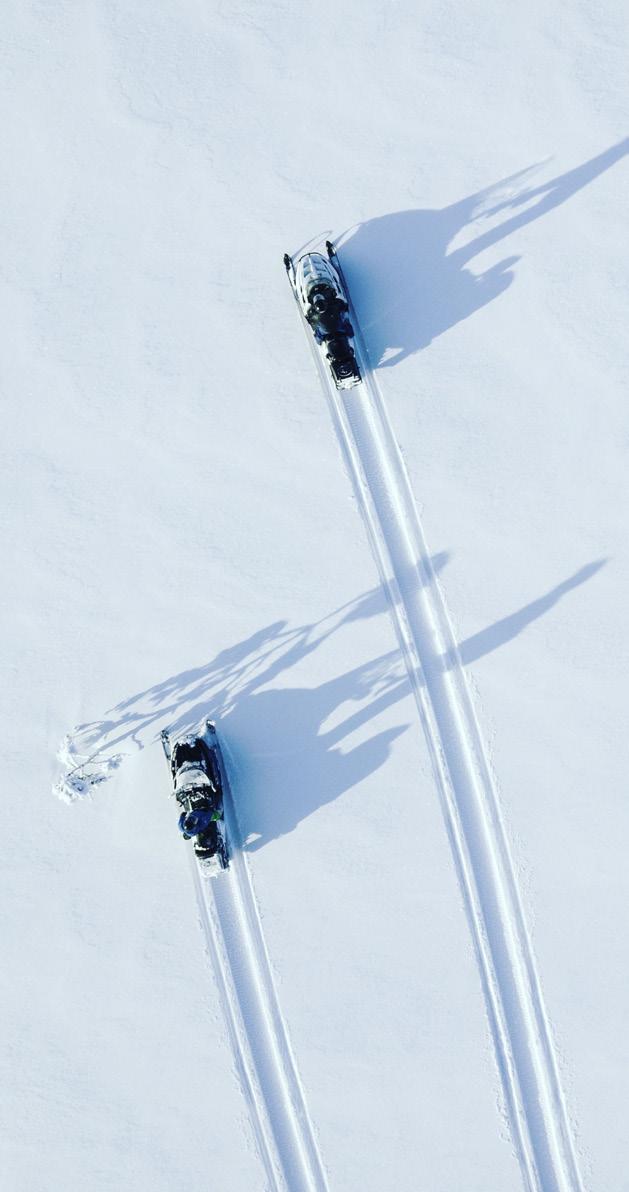

True luxury and the personal touch. The owners of four of the world’s best owner-operated hotels share their vision of hospitality, plus some of the stories and inspirations behind their remarkable properties.
Luca Fiorentino, sixth generation of the family who have owned and operated Grand Hotel Excelsior Vittoria, Amalfi Coast, since 1834.
Simone Domenig was nine years old when her parents bought the Schlosshotel in 1992. Schlosshotel Fiss is now Austria’s premier family spa hotel and she’s General Manager.
Esin Güral Argat, one of Turkey’s most successful businesswomen, has a passion for creating conceptual ultra-luxury beach resorts. BIJAL in Antalya is her newest project.
In 2020 Teresa Unterthiner and Stefan Hinteregger created FORESTIS in South Tyrol, Italy, a sustainable destination hotel rooted in their native region.
Continuously run by the Fiorentino family since 1834, Grand Hotel Excelsior Vittoria is an icon of the Amalfi Coast. It stands on the cliffs of Sorrento, overlooking the Bay of Naples and Mount Vesuvius. Luca Fiorentino is the sixth generation of the family to run the hotel and preserve its tradition of Italian hospitality excellence.
Luca, what is your own vision of luxury hospitality?
My vision of luxury hospitality is very simple. Every five-star hotel has the most expensive products, serves the most expensive food and wine, has the most comfortable linens and more. But true luxury is given by the human touch; a chat with a waiter in the morning, someone who makes you feel relaxed and at ease, who discreetly anticipates your wishes, who makes you feel like a regular guest even if it's your first time staying.
What are the other advantages of being an owner-operated property?
That we are always present and there is an obsessive attention to the smallest detail. Knowing the owner is constantly present is a form of assurance for many guests, who can trust that the level of personalisation is always high. For us, this is our home, and therefore we welcome the customer as if they were at home. Furthermore, there is a very close relationship with all our collaborators, as if we are all an extended family and feel part of it. In my case, most of the staff raised me and, like me, are in love with the hotel.
Grand Hotel Excelsior Vittoria has been continuously run by the Fiorentino family since 1834. What are your favourite times from this illustrious history?
The consideration that fascinates me most is the fact that the hotel was built by my ancestors 30 years before the constitution of Italy as a single state.
The hotel was built in 1834 while the unification of Italy was only proclaimed in 1861. Or that during the second world war the hotel became the rest camp for American Army officers and General Mark Clark was our guest.
Can a hotel famed for its old-world glamour also offer a contemporary experience for guests?
One example is our boutique spa La Serra. It’s located where originally there were stables, where guests who arrived by carriage could rest their horses. With the evolution of transport, the stables were transformed into a greenhouse where we kept and cared for the plants that adorn our hotel. Today, on the premises of the greenhouse, we have created a luxurious spa designed according to the principles of Feng Shui. It features three highly comfortable cabins, a private suite for couples with its own jacuzzi bathtub, dressing room, and large private garden. Elsewhere in the hotel our guests can use an iPad to order room service and much more, with USB sockets on the walls and courtesy lights, while being surrounded by original antique furniture.
For us, this is our home, and therefore we welcome the customer as if they were at home.


Schlosshotel Fiss is a long-time favourite of EliteVoyage clients, for both winter and summer holidays. A family and spa hotel in Tyrol, Austria, it’s been owned and operated by the Domenig family since 1992. Simone Domenig has been the general manager since 2016 and she has quite a story to tell.
Simone, what are your favourite moments from the hotel’s family history?
I still remember when my parents told me they bought the Schlosshotel. Being nine years old, I was worried I'd be far from my friends and school, and that I'd be all alone up here at the far end of the village - 800 metres away from the centre. Everything just seemed unreal, the hotel was so huge. But then my friends still came to visit me and experienced how great it is to live in a house with a swimming pool and all these other features. That really made me happy to think of the hotel as my home. Since Schlosshotel Fiss has become my home, I’ve made countless beautiful memories here. All the family celebrations, our wedding, our 25-year anniversary, the cheerful New Year’s Eve parties together with our dear guests, inspiring encounters with employees along with the end-of-season celebrations. At the end of each season, we get together with the department managers and look back on the past months. Regardless of how intense and busy a season is, this moment is always positive and rewarding. In the end, it’s always the good things that count the most.
Schlosshotel Fiss is one of the bigger owner-operated properties. You’re a fivestar spa and family hotel, ski-in ski-out, with over 100 rooms, new chalets and the illustrious restaurant Beef Club. What are the biggest challenges you must overcome?
We seek to impress our guests not only with architectural innovation and infrastructure, but also with our exceptional level of service. The Schlosshotel Fiss crew plays a significant role in this, and to find people who perfectly fit our crew and its requirements is one of the biggest challenges. I’m pleased that we have a great team at the moment. The front office manager,
the bar chef, the restaurant manager: they’ve been here for a long time, and they contribute even beyond their work. We work more like peers, fostering equality and mutual respect.
What are you most proud of?
I’m proud that the Schlosshotel Fiss is an exceptional five-star family hotel. And also that it is not just my job, but my vocation. I’m only 40 years old, and I’ve been working in the management of Schlosshotel Fiss for ten years now. I am proud of my career and that my mother has placed her life's work in my hands - she puts her trust in me.
What are the biggest advantages of being an owner-operated property?
I think that depends on the guests. Many guests from Central Europe, from Czech Republic for example, want to meet the owner of the hotel. As an owner-operated property we have the opportunity to enhance our hospitality and service by being more flexible. This helps us to create memorable moments for our guests. We have around 70% returning guests. They often tell us that the atmosphere is full of harmony and happiness, and that the employees are so friendly.
What is coming in the future for Schlosshotel Fiss?
I am planning to further transform the hotel into a family resort. Guests of all ages should be able to enjoy their own comfort zones and individual programmes within the hotel. Children will have their own play area, while adults will have access to an exclusive pool and spa area. We are collaborating with a renowned Italian architecture and design studio called Noa. The vision extends 10-15 years ahead. My aim is a complete top-to-bottom redesign of the hotel over the next 15 years.



Opened in summer 2023, BIJAL is the first ultra-luxury resort in Antalya, with 19 beachfront villas. It’s the brainchild of Esin Güral Argat, one of Turkey’s most successful ever businesswomen. She’s brought a distinctive perspective to luxury beach resorts with BIJAL and her other properties.
What is your own vision of luxury hospitality?
In luxury hospitality a resort must have its own soul. From the moment you step through its doors, you should feel enveloped by this soul, experience it throughout your vacation, and leave with beautiful memories the soul has imparted to you. I don't believe luxury hospitality is solely about having luxurious facilities in a property. From the design stage to the operational phase, every detail of the resort needs to be meticulously thought out. At BIJAL each visitor and family can shape their own experiences: playtimes that take you beyond time, strengthen family bonds, foster connections with others and motivate you to explore.
Play is the concept of BIJAL. What inspires this?
Games are not only essential for children but also for adults. Play processes are beneficial for the mind and soul. At BIJAL, me and my team are creating a playground where guests can unleash their imagination and gain innovative perspectives to tackle life’s challenges, while having fun. Engaging in play enhances cognitive, emotional, and behavioural skills in children. Adults also need play to relax, recharge, reconnect, and invest in self-care.
You’ve had great business success in many different industries, becoming the first female Chamber of Commerce and Industry president in Turkey’s history. What attracted you to opening ultraluxury resorts?
Our company’s journey in tourism began over 30 years ago with Ali Bey Hotels & Resorts, operating in Antalya. We decided to expand internationally and established two ultra-luxury hotels on separate islands, projects that best reflect my personal perspective and vision. My aim in the tourism industry has always been to present unique and innovative concepts. Successfully launching JOALI Maldives as an art hotel and JOALI BEING as the Maldives’ first and only wellbeing concept hotel has been truly rewarding. Receiving recognition encouraged both me and my team to embark on the next adventure. In BIJAL we unite these experiences with a brand new concept, emphasising fun and playfulness, with tranquil spaces designed to evoke a sense of home.
From the moment you step through its doors, you should feel enveloped by this soul, experience it throughout your vacation, and leave with beautiful memories the soul has imparted to you.Owner-Operated Hotels
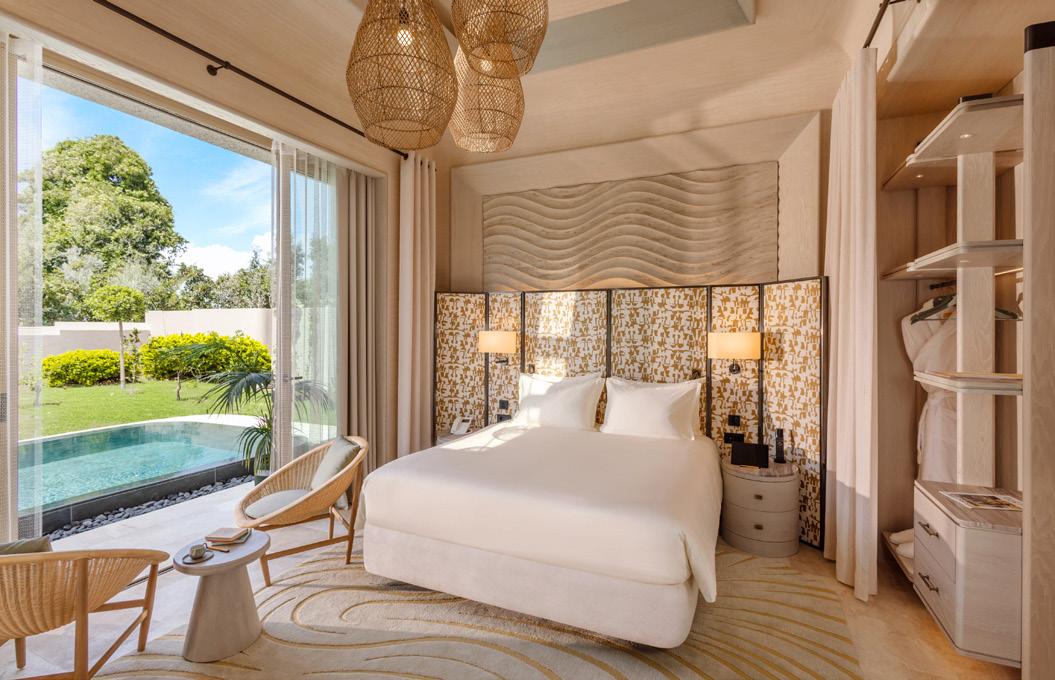

In 2020 co-owners Teresa Unterthiner and Stefan Hinteregger opened FORESTIS. It’s a regenerative and sustainable hotel for adults, spectacularly located high in the Dolomites. Their aim was to create a destination supremely rooted in their native region, South Tyrol.
What are the biggest advantages to being an owner-operated property?
One of the biggest advantages is definitely that we are able to build strong personal relationships between our guests and our team. FORESTIS is the place where we would like to go on holiday. It was very important to us to create a unique place, a place that authentically represents us. Guests can feel the big personal involvement of the two of us.
Furthermore, we can always adjust our way of doing things. In hospitality, that is essential.
What is your shared vision of luxury hospitality?
At FORESTIS we created a place where we want to reconnect our guests to their intuition, and to nature. FORESTIS is a hideaway to experience simplicity, space and time, in a very sustainable way. We want to offer the guests the highest possible flexibility with all their activities and offer, for example, a complimentary activity schedule throughout the week.
Sustainability is at the core of your ethos and operations. What are the biggest challenges you’ve overcome in making this compatible with genuine luxury hospitality?
Luxury does not work without sustainability anymore. Being in the middle of the forest and surrounded by nature, we need to preserve the natural surroundings as much as possible. All our decisions are driven by the urge to do projects and daily operations in an eco sustainable way. This already started during the construction with the selection of materials, and is continued in the daily operations in all our departments. For example, all our food is sourced as locally as possible from farmers. Our energy comes
from renewable sources, like hydro power and solar power. Furthermore, we also have an eco sustainable heating system. The guests nowadays are looking for exactly these types of initiatives. Hotels need to prove that they care about the environment – and guests do really appreciate these efforts.
The architecture and design of FORESTIS is extraordinary. What inspired it?
The general idea was to keep nature in the centre of attention. With every detail we wanted to move the entire attention to our beautiful Dolomites, a UNESCO World Heritage Site. Together with our architect, we found a way of incorporating the hideaway into the surrounding nature. The towers offer the best view for all of our guests without requiring a lot of surface area. We were also very passionate about renovating the historical house, which we kept as much as possible in its original form from 1912. Only the interior was redesigned. We wanted to create a place where the young locals would like to live. FORESTIS is our personal expression of luxury and hospitality.
You recently opened a second property in South Tyrol, Odles Lodge. How has your experience been different, second time around?
The Odles Lodge is only located a few minutes away from FORESTIS, so for us it was great to have FORESTIS as a base during the construction. Both FORESTIS and the Lodge are adults-only properties. All our experience with FORESTIS helped us a lot when creating the lodge. We used a lot of similar materials, like local woods and Dolomite stone. However, the Lodge is a completely different experience. There you can feel even more isolated from everyone, since there are only four suites.

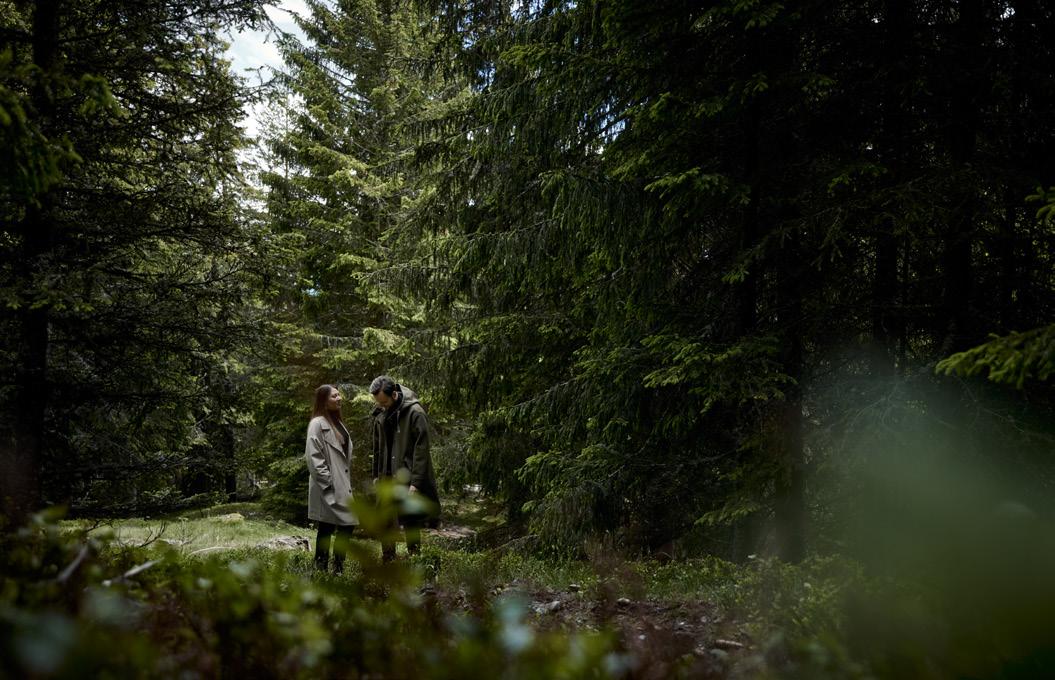

Jan Hvízdal has lived in some of the world’s least inhabited places. He’s a photographer and Hurtigruten Expeditions guide, leads a lecture series Frozen Worlds, and his life as a polar dogsled guide is the feature of documentary film Life Expedition. Following his highly successful solo photo exhibition Frozen Worlds, in Prague and Pilsen, Explorer met Jan to discuss our planet’s least explored and fastest changing places.

Jan, what have been your most surreal experiences in the polar regions?
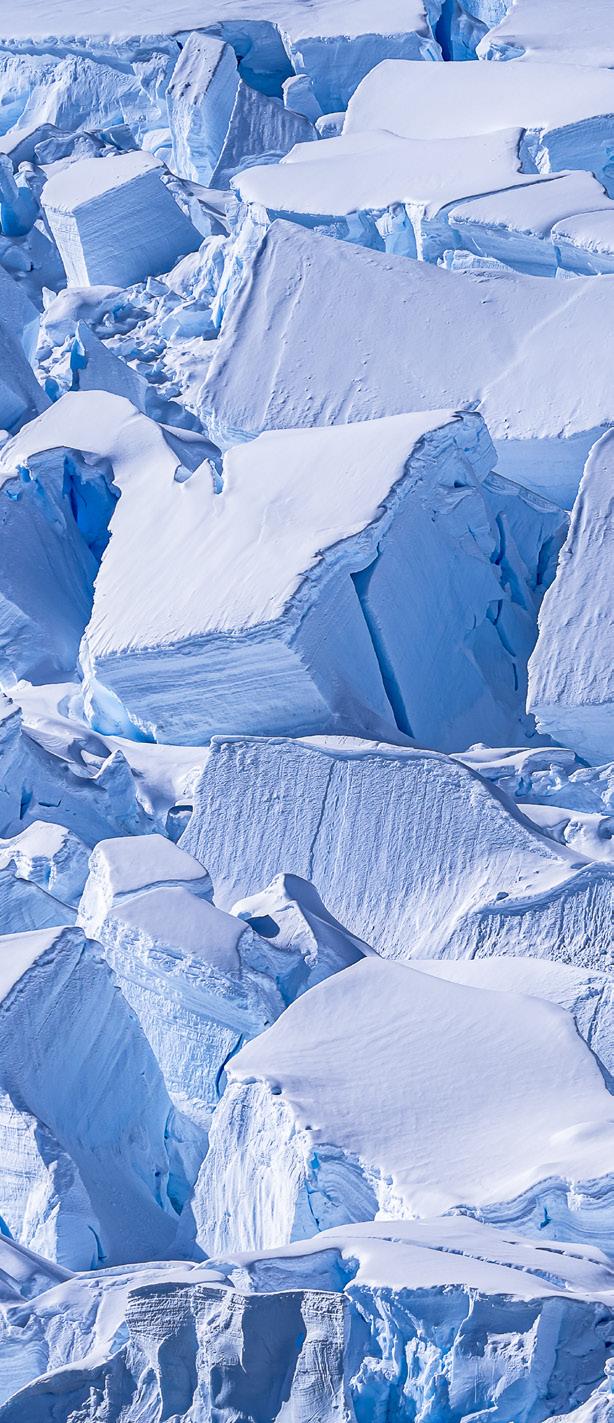
My most surreal experiences are definitely in the Arctic. The presence of polar bears and the long, dark polar night create special conditions for guides in the wilderness. It is very intense. I’ve crossed fresh polar bear tracks in complete darkness, with 30 dogs and eight guests. Those moments were amazing.
What does the wilderness and nature give you, that the modern world cannot?
I need the pure energy and feeling of being alive, that I won’t just be in one place. The modern world is overtechnical, detached. Although I like to use its achievements, I am best in nature. Watching wild animals in their natural habitat is a great passion of mine. The endless open space evokes a sense of peace in me. The people in these places are among the most heartfelt, mainly because they are so few so must be able to rely on each other.
How did you come to live and work in such wild and undocumented places?
I left the Czech Republic 12 years ago, inspired by books like Call of the Wild. Back then it was romantic, in my head I didn’t believe I could achieve this type of life. I was milking cows in New Zealand and picking cherries in Canada. New Zealand is beautiful and is where I started to hike and like the mountains. When I moved to Canada I was wow! The great outdoors! Not another person for hundreds of kilometres!
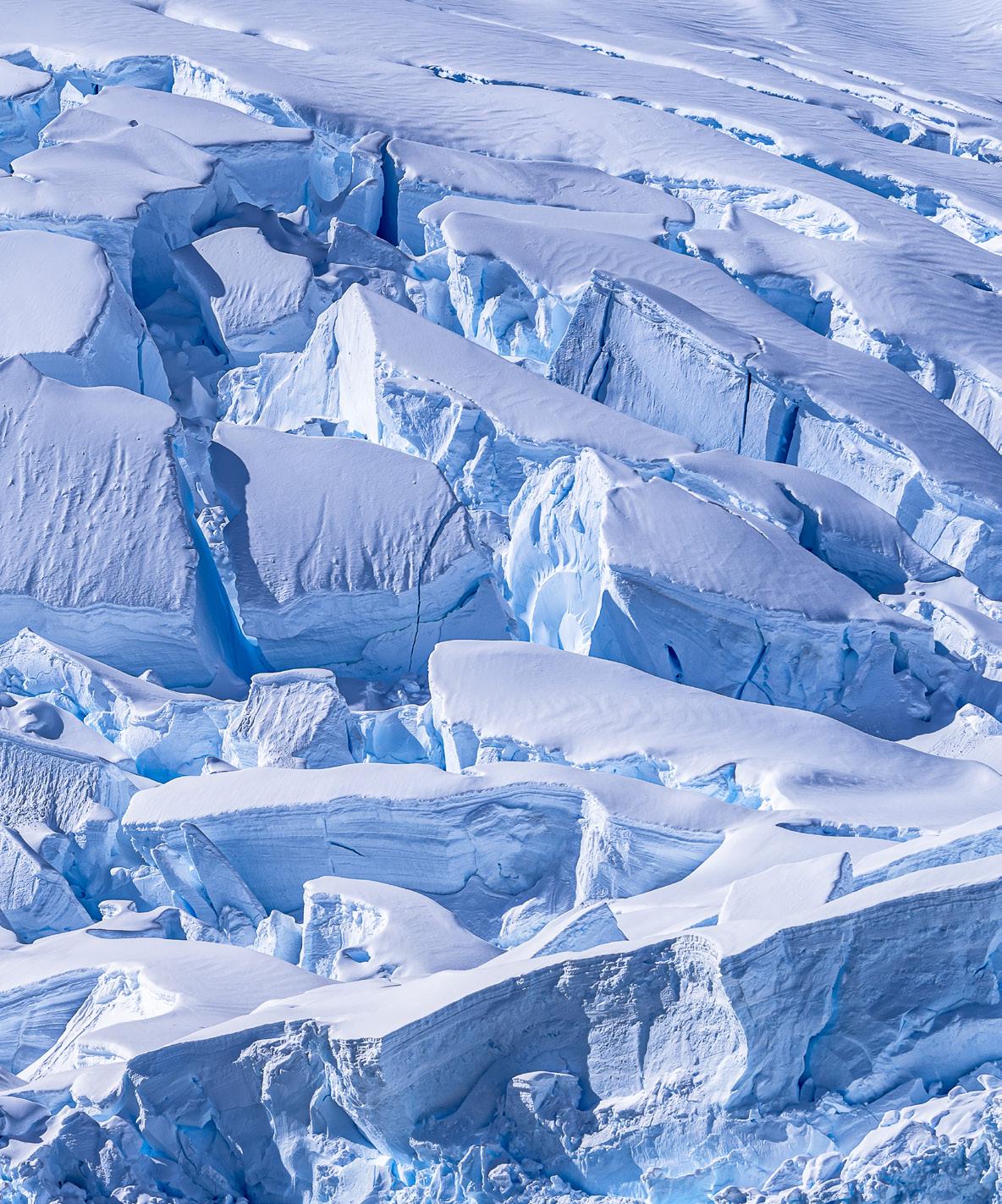
From Southern Canada I did a 25,000kilometre road trip up to Alaska, mostly listening to Johnny Cash. Through British Columbia and Alberta to Yukon Territory, where grizzly bears outnumber people. Here I met my first sled dogs and I had a gut feeling. I needed a higher purpose. I was going to be a dog musher, guiding people in the Arctic. Everything came together: the outdoors, the mountains, physical activity, and my love for dogs.
Tell us about your past life as a dog musher.
Dog mushing was an adventure. I was pushing my comfort zone, challenging myself. It was so exciting. I worked in Kenmore, Alberta, where I met black, brown and grizzly bears at short distances while hiking in the mountains. Dog mushing is heavy work and kind of dangerous. It was intense too, being responsible for guests and dogs. I was scared but didn't realise it.
When I moved to Svalbard I was going out with guests in complete darkness, at minus 30 degrees, with polar bears, carrying a rifle, pistol, avalanche beacon and GPS. Then just digging and digging because there can be a metre of snowfall per night. My boss hunted seals and I had to cut them up to feed the dogs.
I had the northern lights above my head and I was driving dogs, in the complete wilderness. It was brilliant, almost too good to be real, being a musher in that moment, for 365 days a year. I lived in a hut without running water and it was the best year of my life. The documentary movie Life Expedition is about my life as a dog musher, it’s about chasing your dreams and motivation, about doing what you love.
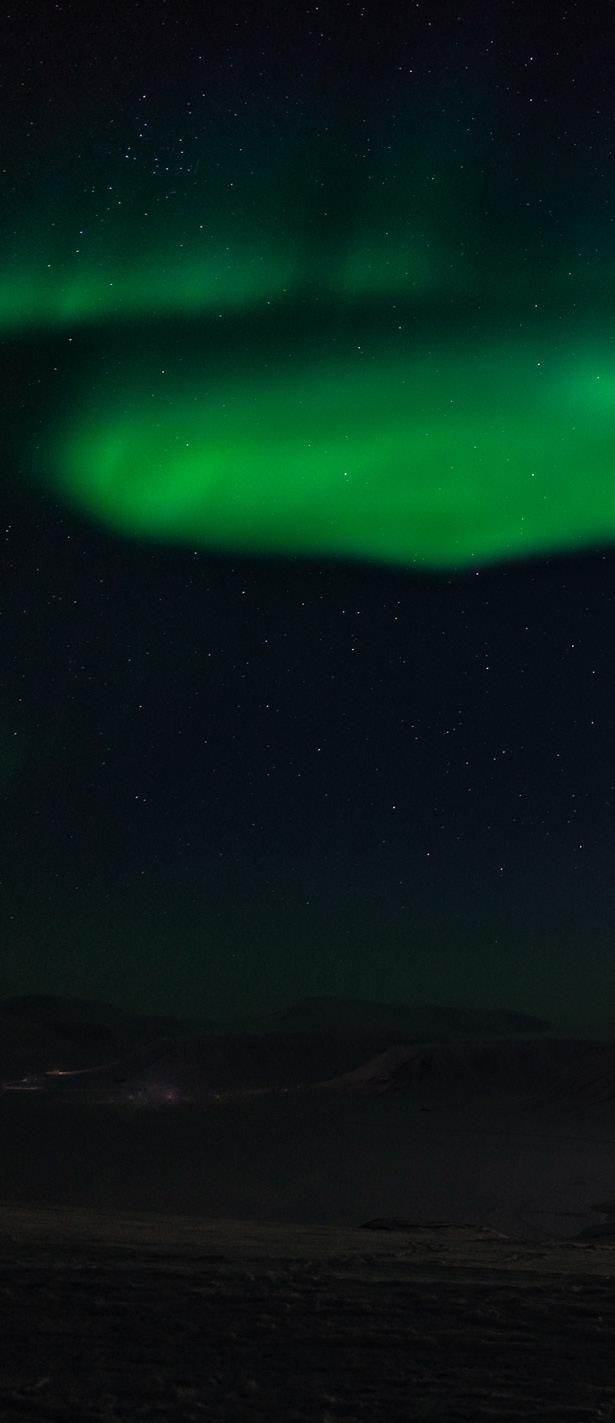
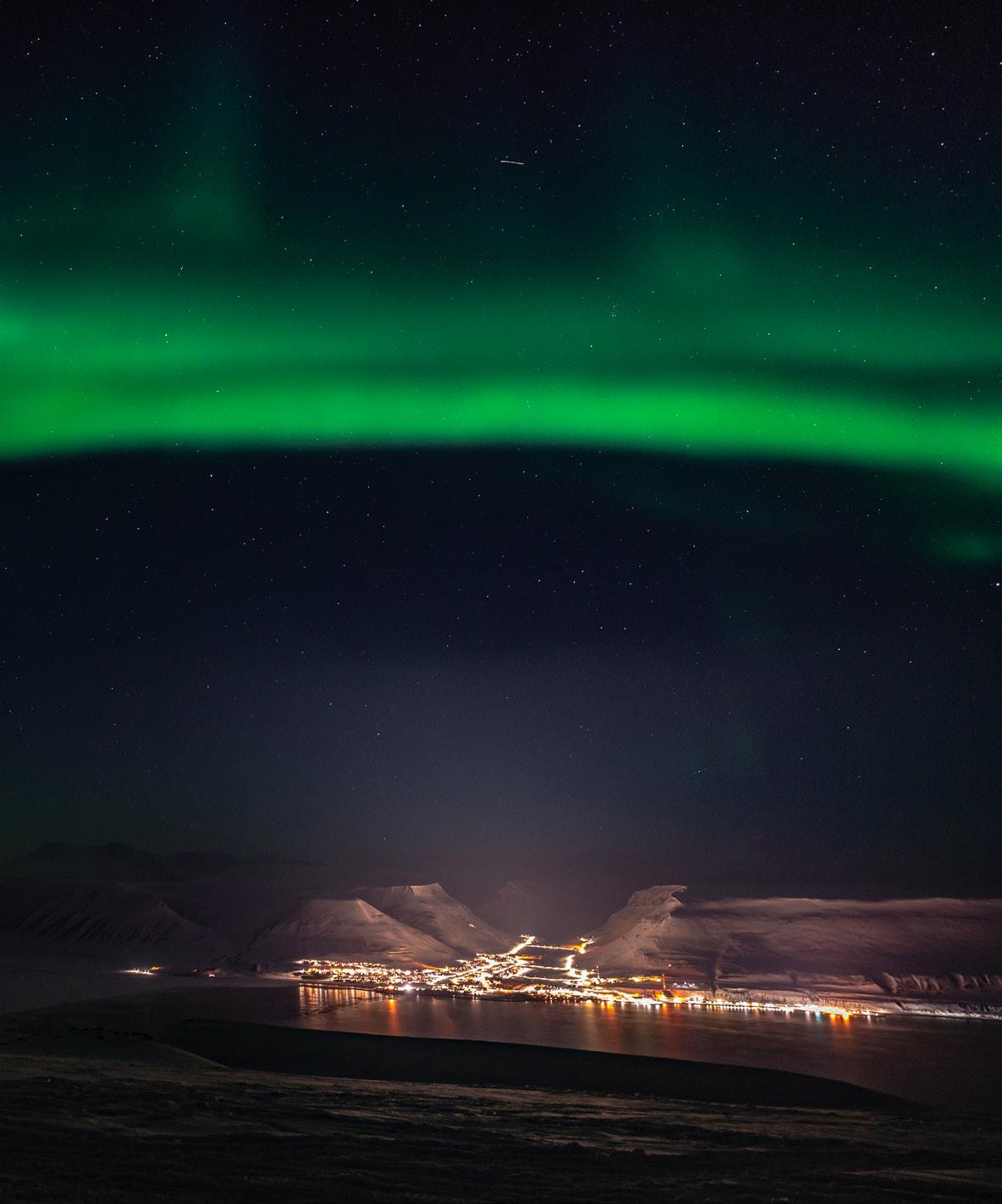


You’re now a professional polar photographer. When did you start taking photos of the Arctic?
In Canada I wouldn’t sleep because I was dreaming of the Northern Lights. I fell in love with the wilderness and this inspired my photography. But taking photos of the Northern Lights is very complex, you must understand the camera and all the vibrations, understand composition before you see the composition. Looking back on old photos I can see I always had a feeling for photography. In Svalbard I really learnt my skills and created photos that will stay with me for a lifetime.
What are the photos you most love to take?
I’m a sharpness freak, looking for sharper than sharp. I just did a series on puffins on the Hebrides islands, off northwest Scotland. As a photographer I like Antarctica, it’s easy to make good wildlife shots there. Norway is exciting, chasing the northern lights. Svalbard is great for photographing bears and Arctic foxes.
How did you move from dog mushing to professional photography?
After five years there was nothing new for me as a dog musher. I became an expedition photographer on one of the six vessels owned and operated by Hurtigruten Expeditions. We are taking people to places like Svalbard, Cape Verde, the Faroe Islands and Antarctica. One vessel is going pole to pole: Alaska, Canada, Greenland, New York, Panama, South America, the Beagle Channel and Antarctica, in 100 days.
I recently fulfilled my dream and created an exhibition called Frozen Worlds. It was in downtown Prague for two months, then in Pilsen, 20 big prints from the Arctic and Antarctica, showing the beauty and fragility of polar areas.
What are the important differences between Antarctica and the Arctic?
Antarctica is a frozen continent surrounded by sea. The Arctic is a sea with islands. Antarctica can only be visited in the summer. It’s easy and entertaining for everybody. You visit the peninsula, the tip facing South America, where Hurtigruten established landing sites. There are penguins and whales. Penguins are like antidepressants. Sit with them for 30 minutes and you feel better about life. On my last trip we had 60 whales around our boat, humpbacks, minkes, orcas. We sometimes see blue whales there too. The summer starts in early November and the climate is mild. It’s impossible to not love Antarctica.
In the Arctic there are less animals, so when I am guiding I get into the history and context. You can explore larger areas and also travel in winter. Pink spring is the time I recommend the most. The Arctic is less comfortable than Antarctica. When it’s uncomfortable in certain moments it’s easier to enjoy the rest of the experience and appreciate everything in nature.
I’m a sharpness freak, looking for sharper than sharp.The Polar Photographer - Jan Hvízdal
Tell us more about pink spring and the other Arctic seasons.
Polar night starts in November, with the sun circling below the horizon, complete darkness. As it gets closer to the horizon the season is called blue twilight, for two or three weeks. Pink spring is when the sun comes up but is circling low on the horizon, giving pink and violet colours. Some northern lights are visible too, from mid-February to mid-March. It’s my favourite time, when the High Arctic is most beautiful, when the sunset lasts for six hours. It’s minus 30 with sun and no wind, which is very comfortable.
The first sunrise is 14 February and by 1 April there is only daylight. Now comes polar day and midnight sun, all the way until late August. Finally there is golden autumn, the sun going down, the flowers dying, a really beautiful time, before blue twilight and the next polar night.
What are your favourite places to explore in the Arctic?
Svalbard is a special place. You can wear skis and just go for 300 kilometres. You can also have an easy trip there. It’s only a 3.5hour flight from Oslo and you land directly in the High Arctic. Svalbard is incredible and the best for people from Europe to discover the beauty of the High Arctic.
Greenland is more challenging. I love it in Arctic Canada and Alaska too, meeting Inuit people and seeing bears, although they are more difficult to get to. All of Norway is a playground. You can travel there for three years and won’t see enough, it’s always changing.
Bearded seal in front of Monaco Glacier, Svalbard. They are the main prey for polar bears.


Puffins on Fair Isle, Shetland Islands, Scotland. Jan says: "Puffins are monogamous and my idea was to create a heart that symbolised their unbreakable bond."
 Polar fox in Kapp Waldburg, Svalbard, hunting a kittiwake colony.
The Polar Photographer - Jan Hvízdal
Polar fox in Kapp Waldburg, Svalbard, hunting a kittiwake colony.
The Polar Photographer - Jan Hvízdal

What specifically is changing? What have you witnessed after ten years living in polar regions?
Year on year I see the changes. It’s terrifying. It’s not just the amount of ice we’ve lost, we’re losing the old ice, which takes the longest to melt. Now polar bears don’t have sea ice to hunt so they need other food sources. Now they are hunting reindeers. Filmmaker Florian Ledoux captured it in Svalbard, bears, Arctic foxes and gulls all around a reindeer.
Polar bears are smart, curious, 600-kg marine predators. They can eat a quarter of their body mass in one meal and go into a phase of walking hibernation, where they starve for up to eight months. Polar bear mothers understand the planet is changing and are now using their cubs to hunt. Long term the bears will reduce their fat layers, so they can run for longer without overheating.
At the start of summer, polar bears are visiting islands where birds nest. 800 eggs are equal to one seal. Last year Svalbard lost half its barnacle geese population, because polar bears vacuumed up all the eggs, and bird flu. And these changes are happening everywhere.
What is the future of the polar regions? Can there be a positive future?
Politics won’t save the world. So no aggression, no shouting, no media display of killing the whales will help. We are temporary and we have so many ways to make the world an ecologically better place. Along with my exhibition I developed an education program called Frozen Worlds, it’s about ecology and chasing the dream, motivating kids to do what they want to do. Kids today are amazing, they are already thinking about how to help the world become a better place.
People should visit the polar regions, sustainably and with care. This creates emotions and raises understanding of these changing places. Geography, culture and nature are all connected to each other. As a guide I always like to put things in context, it’s so important. Explain things that will interest people and transmit the energy between them. Raise their understanding of a place, so they act on what they learn and their emotions. Tourism, when done correctly, will help to make the polar regions an ecologically better place.
People should visit the polar regions, sustainably and with care. This creates emotions and raises understanding of these changing places.The Polar Photographer - Jan Hvízdal Polar bear, Sundnesset, Svalbard. Jan says "Watching the king of the Arctic walking in beautiful autumn colours will stay in my memory forever."
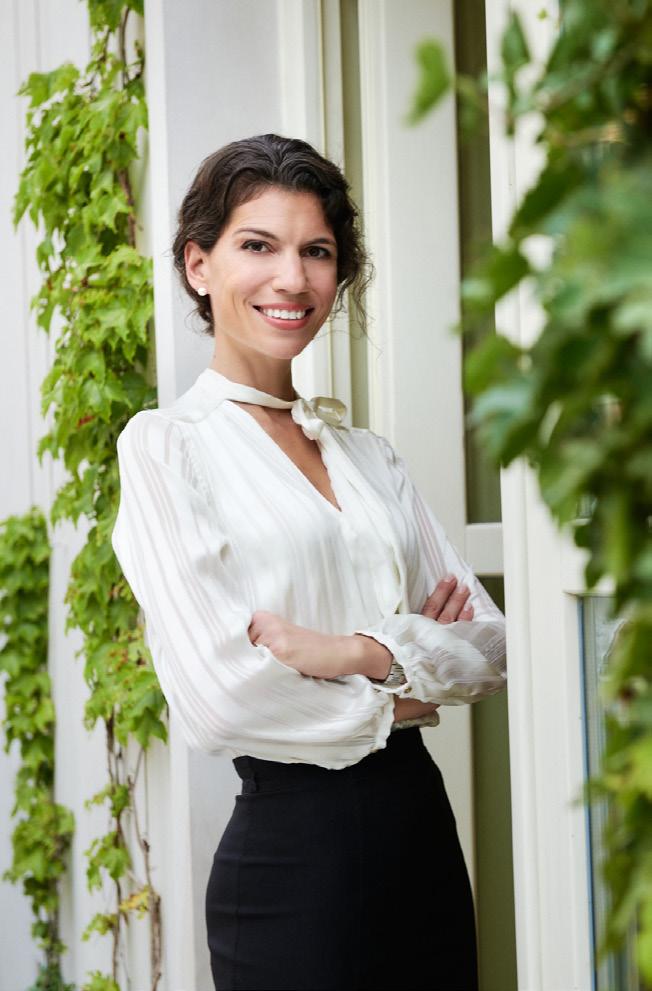
Prague-based Gabriela Marková is the founder of Luxury Bloc, the most important travel event in Central and Eastern Europe. She’s a connector, fluent in five languages, helping the world’s best hotels and destinations reach new audiences. It’s highly likely that she has influenced your holiday choices. In this interview, Gabriela shares her perspective on the trends that are shaping travel for discerning travellers from Central and Eastern Europe.
Gabriela, what inspires you as a traveller?
Inspiring somebody to visit a new destination is something I consider an achievement. I grew up in Latin America and Switzerland, so I lost my relationship with the Czech Republic. For years I was travelling and working abroad, in different parts of Europe or in the Maldives, before moving back to Prague six years ago, to a country very different to when I left. What keeps me travelling today is discovering new destinations and giving the impulse to industry colleagues to consider these new places. Seeing a destination report in a magazine, or a newsletter from a partner travel agency, is the biggest satisfaction to me. Because I know travellers have just been given new inspiration.
So you are the trailblazing type of explorer. What is your travel style?
When I travel it’s always work and play. I see a new hotel and think, ‘I have to at least go and try the breakfast’! I need great accommodation, a clean bathroom, and to go out exploring during the day. My style is trying the street food, exploring through the dirt, then sleeping in the best suite. It’s combining authenticity and experience with comfort and luxury. Like sleeping under the stars in Zambia, but glamping - not camping!
How has travel changed for the ultra wealthy from Central and Eastern Europe?
Luxury travel only really started in our region about 15 years ago. Back then nobody knew about the polar regions. People would consider it too cold, too boring, too limiting, yet when you go to the polar regions you realise how mind blowing it is. You need to understand the what’s, the where’s, the how’s and the why’s. And that’s what has changed. There are people who would buy the most expensive wine just because they can afford it, but they don’t know anything about wine. It’s the same with travel. I’m proud of how we’ve developed in Central and Eastern Europe. People from our region start to understand what they want and truly appreciate distinctive sides to travel. They are becoming the connoisseurs of quality in travel.
What are the current travel trends in Central and Eastern Europe?
There is a big wellbeing trend after the pandemic. People are more aware of themselves and are seeking a better work life balance. Executives are valuing some time to disconnect too. So wellbeing travel has really emerged. Now, in 2023, business is going well and people are working a lot more. So we’re seeing this trend of big family travel, holidays with multiple generations of one family. People realise they need to spend time with their loved ones and they like to travel with their families, or friends. Adventure and experiential travel is slowly becoming the biggest trend at the moment. Whereas sustainability is a travel trend that our market has not yet completely embraced. We know the trends by knowing the statistics. If you look at how certain people travel and how their behaviour has changed, you can see a decline from classic beach holidays to different types of holiday. Many trends can then grow further because of the marketing and PR around them.
People from our region start to understand what they want and truly appreciate distinctive sides to travel. They are becoming the connoisseurs of quality in travel.The Connector - Gabriela Marková
Do you think the travel trends are different in the Czech Republic to the rest of the world?
Not different, we just started a little later than other countries. Over the last 15 years we’ve been to the best hotels, we’ve flown on private jets, we’ve come to understand what’s worth it when we travel. We’ve done the best beach holidays and now we want something more. We want experiences, like adding a safari before the beach or cultural stop in a renowned city before a cruise. In our region we have many affluent people who are financially beyond stable. They have seen it all, done it all. They want to feel alive, experience something else, then come back with everlasting memories and a story to tell. These people are getting into sustainable and community based travel too, adding a ‘good deed’ aspect to their experience, like personally contributing or helping to build a school or a hospital, rather than transferring money to deduct from their corporate taxes. They’re feeling good because they are doing something for the environment and supporting local communities. They’re not just relaxing, they can feel part of something bigger.
How else are discerning travellers from Central and Eastern Europe travelling differently now?
People are travelling more now. During Covid, quality and privacy was the priority. They flew private jet rather than first class, they wanted beach and ski holidays on the highest possible level, but remote. That’s why the Maldives boomed so much. But the CEE market is not as homogenous as other regions. You may find different trends in Romania and Bulgaria, still focusing on luxury beach holidays, while the central part of CEE started looking more into adventurous and experiential travel. For many people, travel is now about the experience, the memories you take away. It’s a cliche but it’s true. It can be a private island, but it can also be more active, like a helicopter to the top of a mountain then hiking back. It can be disconnecting in a retreat place without internet, without TV or news, without alcohol, or reconnecting with family and friends. Most of the ultra wealthy don’t have the luxury of time. Unique travel experiences are also a way to disconnect and maximise the time you have.

Travellers themselves are setting the trends, but only at the impulse from their travel advisors. So travel agencies are really setting trends. If agencies only sold beach holidays, people wouldn’t know about safari in remote African regions, a wellbeing resort in the Himalayas, or an adventurous yet luxurious Amazon river cruise. Travel agencies are helping people to understand the unique experiences they can have, without compromising on comfort. The very best travel agencies are inspiring and guiding these travellers, to go somewhere new and learn something about a different region, culture, or ultimately, themselves.

Are travel agencies becoming more popular, in this age of being able to book everything instantly online?
Travellers now realise that travel is a form of investment, it makes you richer. It’s something nobody can take away from you. These travellers need to know they can rely on their travel advisor, to know their dreams and their boundaries, and create a tailormade experience surpassing their expectations. They need experts who know you can go for different aspects of holidays in one and the same destinations. Because every client is different and will live and explore a destination in their own distinctive way.
There are many other ways that travel changed during and immediately after the pandemic. What will happen in the coming years?
I felt like we were in the shadow of the financially affluent CIS market. As bad as it sounds, the pandemic was really good for the CEE region – recognition wise. Many countries were not allowed to travel, but we travelled, even if it was difficult. We had money to spend and we just wanted to get away from restrictions. This was valuable because travel suppliers - hotels, resorts and other travel companies in the destinations - understood that our region has wealthy potential to travel. And that there are no political or financial limitations. It was a perfect opportunity for launching the Luxury Bloc travel show. With Luxury Bloc we proved that when you connect the right people and show them different options and ways, they will go and explore. During the pandemic the CEE region became a term in travel. Now our region is really rising in terms of luxury travel and step by step we will reach the level of the major western countries.
The very best travel agencies are inspiring and guiding these travellers, to go somewhere new and learn something about a different region, culture, or ultimately, themselves.
2020 was the first edition of Luxury Bloc. With the fourth edition taking place in September 2023, how has Luxury Bloc changed?
We launched in the middle of Covid and the sources were limited. There was a lack of credibility but we pulled it through and the feedback was surprisingly strong. Hoteliers came with doubts, sending one person to ‘test’ the market. A year later they returned in full force with sister properties or a bigger team, which is the biggest compliment I can have. Last year we had one Mandarin Oriental hotel at the show, this year we have six. This year we will have 82 suppliers. My heart is bleeding because this year we even had to decline some big name brands because we are full.
Is there anything holding back travel from our region?
If a hotel thinks we’re from Czechoslovakia or offers a Russian-speaking guide as a benefit, travel advisors get turned off. Once luxury hotels acknowledge our region they have half won our business. It’s quality over quantity so they shouldn’t expect volume but bookings of over 100k EUR are not rare. It’s a two-way partnership and investment in our market is a win-win situation.
The biggest objection to new destinations is access. If it takes more than two stops people don’t want to go there. Flight frequency isn’t fully back to pre-Covid levels so there are fewer connections and longer layovers. The aviation industry has something to improve and it will impact where people go.
So where will travellers from our region go in the coming years?
The Indian Ocean islands will remain number one. But people will explore beyond, like Nepal, Bhutan and Japan in Asia. Africa was considered a backpacking destination and now people realise there is real luxury at the lodges and camps. People are starting to ask about countries like Uzbekistan, Kyrgyzstan, Mongolia, which is very interesting.
I am noticing mixed feedback about Saudi Arabia, but with so many top brand hotels opening there it will certainly become a huge destination, a major competitor to the Indian Ocean islands. Some people say I’m not sure, due to political and social issues. Some say wow, finally a new luxury destination. I see a lot more interest in cruising as well, as the perception has changed, from being seen as a boring and monotonous senior-type-of-holiday to an opportunity to explore multiple destinations combined with a luxury resort experience. Now they’re really taking off. And finally, to my big satisfaction, South America and the Caribbean are gaining in popularity too.
Travellers now realise that travel is a form of investment, it makes you richer. It’s something nobody can take away from you.
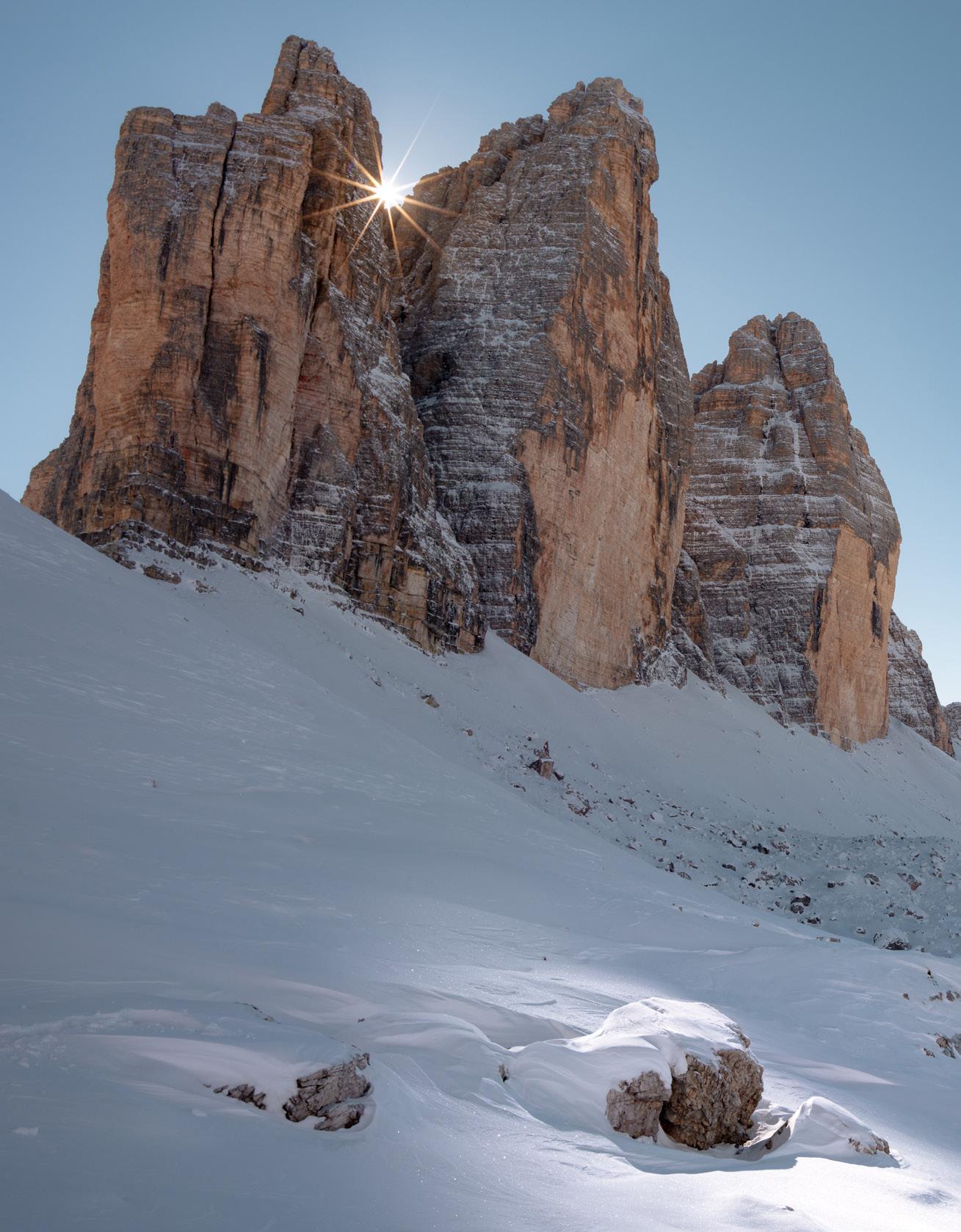
Nature, wellness, skiing and sublime owner-operated hotels. EliteVoyage co-owner David Eder reminisces about different trips to his favourite destination, a small mountain region in the Italian Dolomites. And he invites some friends and EliteVoyage clients to share their memories too.
words David Eder, Věra Bechyňová, Nikol Poner, Štěpán Borovec
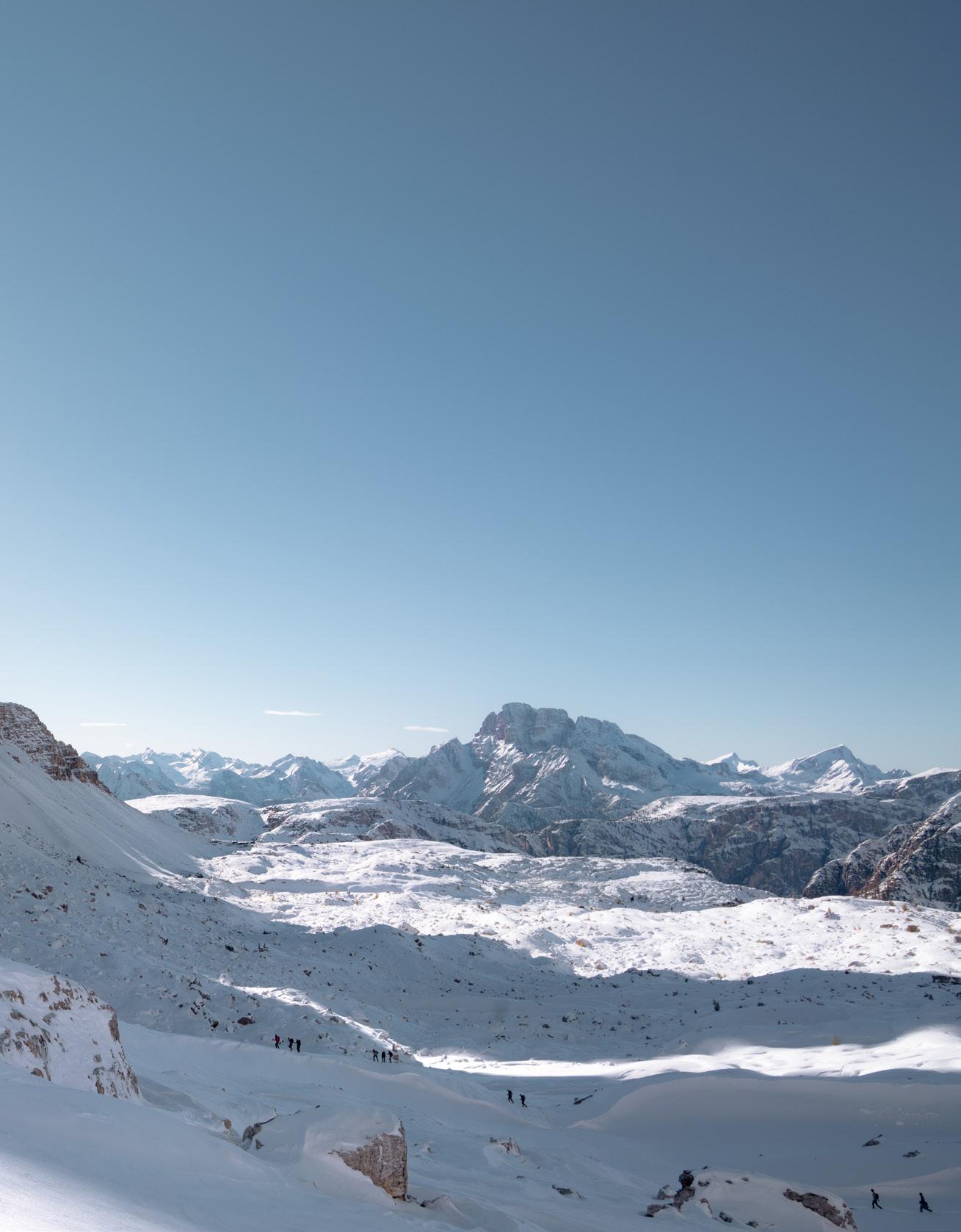

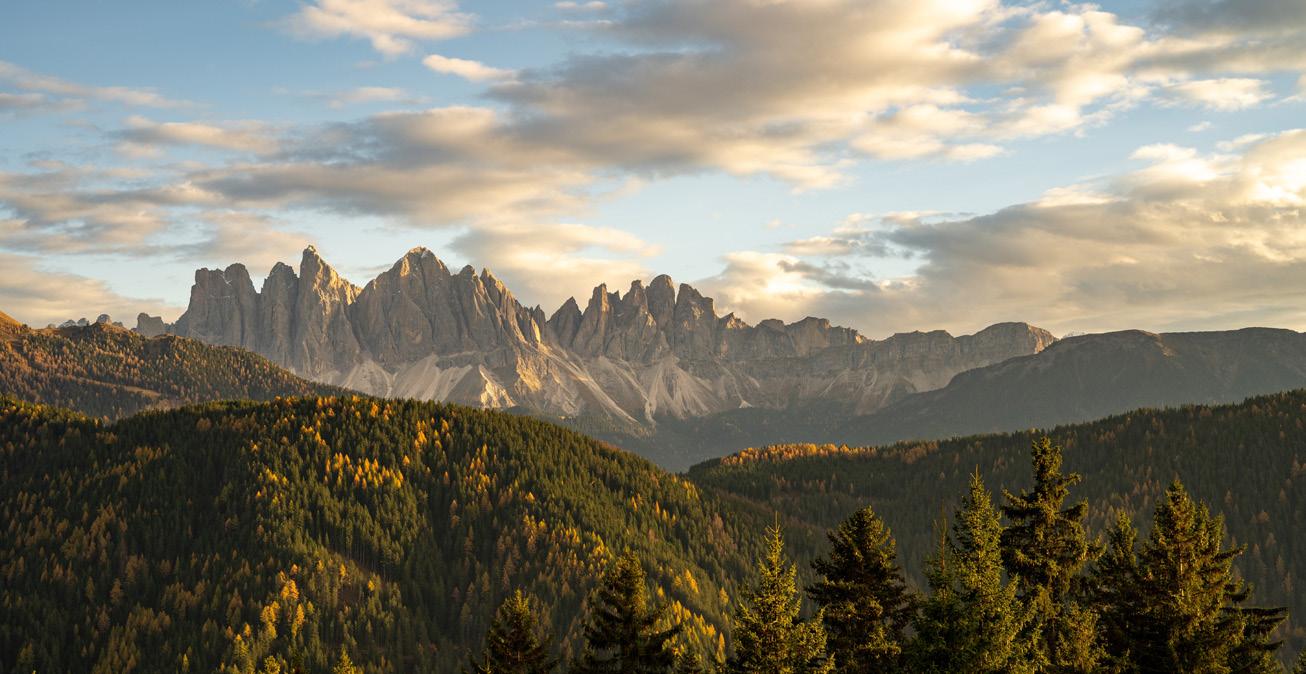 David Eder
David Eder
Walking in a quiet forest with my family, absorbing the fresh mountain air. That feeling of relaxation in an outdoor jacuzzi, gazing upon snow-capped mountains. Rising higher in a chair lift, curious about the next uncrowded slope to ski down. So many other memories also come to mind when I think of South Tyrol, of so many trips with and without my kids. In every memory there’s a beautiful view, a boutique hotel to uncover, and the energising feeling I take home.
Whenever I depart I know that after three or four days it will feel like the best holiday ever. That’s a cliche, I know. As co-owner of a luxury travel agency my job is to explore, to find new destinations and recommendations for clients. This is what inspired me to start in the travel industry, 15 years ago. So, for my own holidays, why do I keep returning to this small region in the Italian Dolomites? Allow me to reminisce and explain.
I have many memories of walking in a quiet forest with my wife and three children, sharp mountains towering in the distance, the sense of freedom and nobody else around. We’re not hikers or bikers, although this is certainly a destination for both. We just love these nature escapes and spending time together as a family. We can experience great nature close to home as well, but does it also come with great weather and food? Does it also offer us the highest level in terms of service and hotels?
South Tyrol is the closest destination that combines all of this into one holiday. For me, Italy is always a safe bet for holidays with young children because there’s nothing it lacks. The infrastructure makes it easy for families, even high up in the mountains.
Forestis is the hotel I love most for nature. Enjoying the view from up there is something I will never tire of. The minimalist design is very clever too, how it enables breathtaking scenery to dominate almost anywhere in the hotel. Like all the top hotels in South Tyrol it’s an owner-operated property. I remember meeting the teenage son of Christine and Michael Reiterer, a couple who were given a plot of land as a wedding present in 1999. Here they built Hotel Chalet Mirabell from scratch, piece by piece. A few years later, I see the business being passed to their son Martin. On every trip here I experience how the owners are in love with their properties. It’s a region where the hotels are full of emotion and soul, each of them created detail by detail, generation after generation.
South Tyrol is a model of sustainability because of these hotels too. There’s this collection of independent hotel owners working together for the better of the destination. They know that their fortune isn’t to have golden bathtubs, but to preserve the spectacular surrounding nature. They’re achieving this by limiting how they increase the number of hotel beds, even though the region is now in high demand. It still amazes that there’s more of this pristine nature I’m yet to discover. Next year we’re planning to explore the South Tyrolean lakes, as an alternative summer holiday on the water.
I’ll visit these mountains before summer though. I just love the feeling of relaxation in an outdoor jacuzzi, gazing upon snow-capped peaks, savouring the atmosphere and clean air with my wife. It’s always wellness with a view, like a lounger beside an outdoor spa pool, or the mountains coming in through floor-to-ceiling windows. The hotels don’t boast about how many saunas or treatment rooms they have, nor how many square metres of wellness they can offer. Instead, they do wellness rituals. At first I thought it was weird to sweat together in a sauna with 40 people. A ritual at Hotel Chalet Mirabell with Aufguss master Rob Keijzer changed my perspective, as I relaxed into the vibe that a top professional can create. I still don’t love all the rituals, but overall they’re a very nice experience and we really enjoy the time and atmosphere.
We can experience great nature close to home as well, but does it also come with great weather and food?
Of course they have great facilities too. The people who visit this region know good taste. They can see it, feel it and smell it. Cheap materials impact hygiene and in South Tyrol they don’t cheat with the hardware. They know their guests can discern quality and they’re proud of the quality they offer. We return regularly to Hotel Chalet Mirabell for wellness. The kids area is separate from the adults-only area, so it never feels like a crowded resort. For families I recommend the beautiful villas which come with five-star-hotel-level service.
Lefay Resort & Spa Dolomiti is another wellness favourite of mine. I’m yet to try Alpen Tesitin, which Rob Keijzer recommended to me. And I’m interested in the experience at Rosa Alpina, which is currently under renovation and will open as an Aman partner hotel for the 20242025 winter season. Simply having such a strong choice of wellness-focused hotels is another reason I believe this is the world’s premier wellness destination.
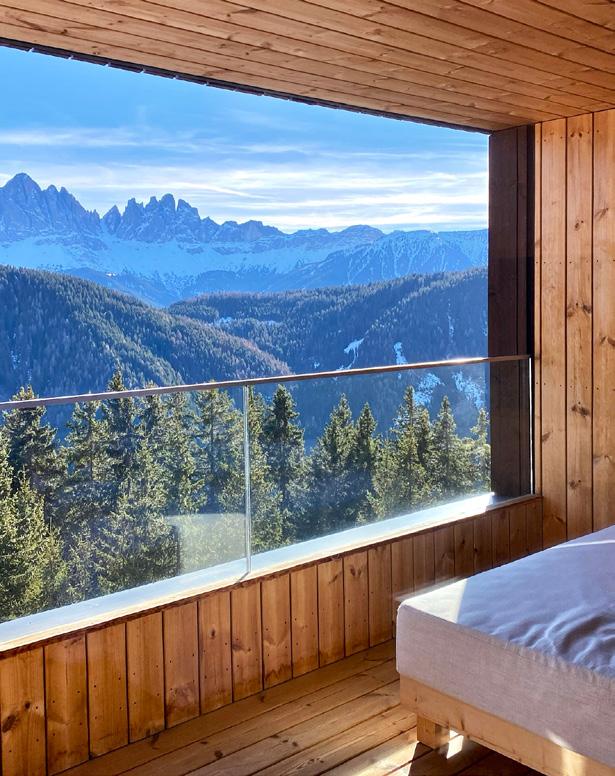
But I wouldn't stay at Mirabell for skiing because it is inconvenient for the slopes. With South Tyrol it’s important to know why. Every time I go I ask myself, why am I making this trip? What do I want, what’s most important? With that information I can find the right property, with the help of our travel designers. Recommendations are so important and our travel designers not only have their personal experiences, they have all the feedback from different clients who stayed at different hotels.
Skiing was the first reason I visited this region. I prefer it to Switzerland and Austria because the food and weather are much better. The northern Dolomites get more sunshine than anywhere else in the Alps. And like almost everywhere in Italy, South Tyrol has amazing cuisine with a capacity to surprise, whether the abundant fine dining or a traditional mountain hut. I skied in Austria recently and wondered, why don’t they have heated seats on the chair lifts? I prefer South Tyrol to France because it’s closer and more convenient, while boasting a high quality infrastructure that’s comparable with Courchevel and Megeve. Cortina d’Ampezzo in the neighbouring Belluno region will host the 2026 Winter Olympics, so there’s been a major infrastructure upgrade across the Dolomiti Superski area. Snow cannons cover over 1,000 kilometres of pistes and in general, there’s always snow to ski at the highest altitudes, despite warming weather in the Alps.
When skiing with kids I recommend Amonti & Lunaris in the Aurina valley, or Tenne Lodges, just over the border from Austria. Neither have a remote location or open view to rival a hotel like Forestis, which is also good for skiing. Instead, they’re next to the road and super convenient, because they’re only a few metres from the main lift station. There are many South Tyrolean hotels I recommend for foodies and Tenne is high among them - their multicourse daily menus are mind-blowing!
For every Dolomites ski holiday I love to try a new hotel, ever curious about finding the next uncrowded slope to ski down. Like Hotel La Perla in Corvara, one of the few ski-in ski-out in the Dolomites. This winter we’ll try the new Excelsior Dolomites in Kronplatz. It’s another resort town with direct access to the interconnected Dolomiti Superski area, where I know there are slopes to satisfy every age and level of skier. Unfortunately, many people descend on the Dolomites every Saturday afternoon during ski season, creating tiresome traffic jams. I recommend two simple tricks, especially for school holiday weeks. We leave on Friday and overnight in Innsbruck or Salzburg, then beat the traffic the next morning. Going back we have a late check out and another day skiing, before departing Saturday evening and overnighting on route home. The roads are great all the way from Prague and at most other times it’s a relaxed one-day journey. We’ve done it twice in a Tesla and even with two 30-minute charging stops it’s still very comfortable.
After seven hours of driving I’m a little tired when I arrive. But not when I return. South Tyrol always recharges my batteries. I come home with so much more energy, for the office and everything else. That’s what favourite destinations can do, create this rejuvenating and restorative effect that continues long after the holiday. Returning home I’m always planning the next trip too, be it spring, summer, autumn or winter. And even after so many trips to South Tyrol, I can always find somewhere new to explore and uncover. It’s a destination for people who are very demanding, people who know what they want from a holiday and know quality.
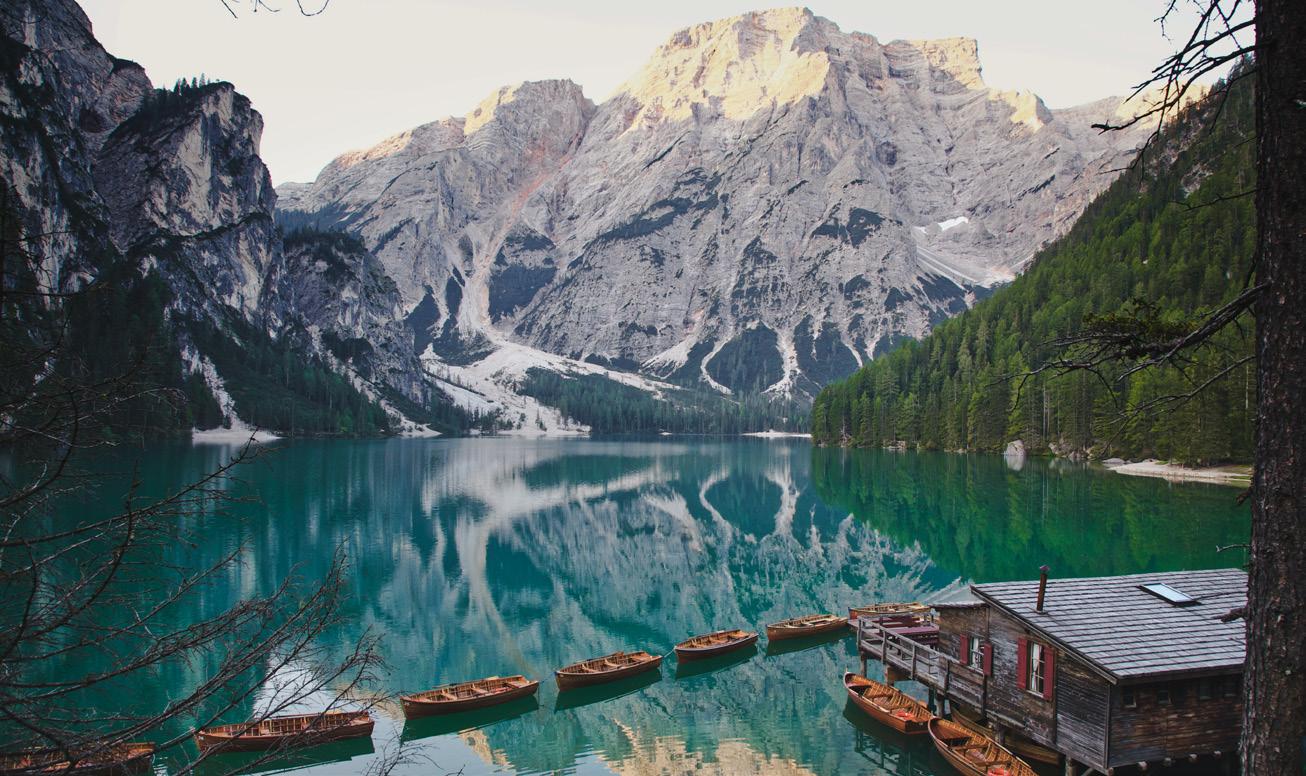 South Tyrol, by David Eder
South Tyrol, by David Eder
People who visit South Tyrol know good taste. They see it, feel it, smell it.

Fresh, youthful and creative: the three words I can best describe Hotel Lindenhof in the town of Naturns near Merano. It stands in the middle of beautiful nature and is built exclusively from natural materials. The warmth of the Nischler family, who have been running the hotel for three generations, creates a great atmosphere. Chef Giosué cooks with local products and recipes he learned from his grandmother - both the taste and presentation are breathtaking. The owner of the hotel, Joachim, is a sommelier and wine connoisseur, giving tips to guests about the extensive wine list and several hundred types of whiskey. His daughter Chiara goes running with guests around the local area.
Joachim is also happy to accompany guests on a round of golf. Lana Golf Club is closest to the hotel. It’s dominated by Brandis Castle and is relatively short and almost flat. The crouse winds through a terrain of vineyards, apple trees and the houses of local winegrowers. It’s one of the most in-demand golf courses in all of Italy. Yoga in the feng shui garden is unforgettable. The spa is dominated by the sky sauna and the castle sauna is a special experience. For complete privacy, the penthouse suite has its own spa, with sauna and jacuzzi. Elsewhere there is a large playroom, cinema and special spa for children. There are also a few "adults only" weeks throughout the year. Lindenhof Pure Luxury & Spa Dolce Vita Resort is a great base for active and relaxing holidays, in winter as well as in summer
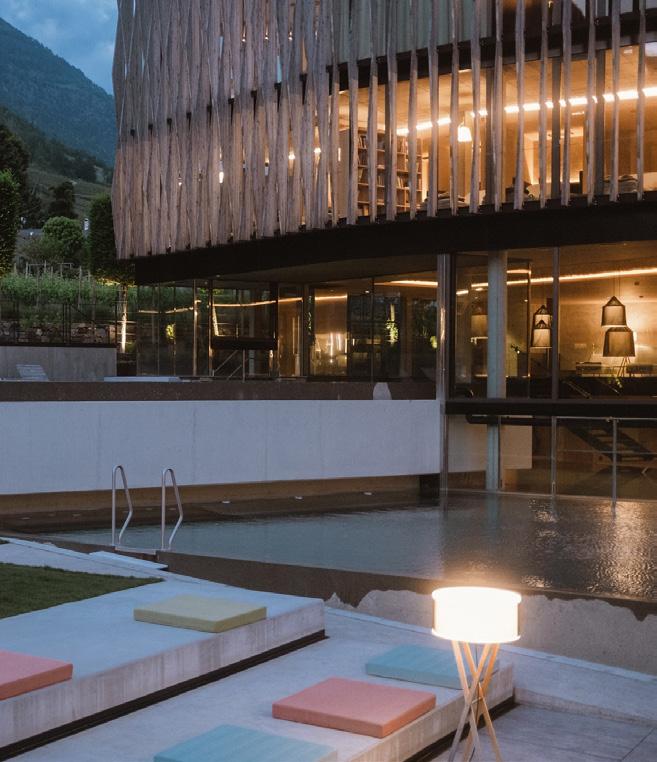
 by Věra Bechyňová
by Věra Bechyňová
The number of sunny days per year in South Tyrol is enviable - over 300! Wine thrives on the slopes and Hotel Turm, ten kilometres from Bolzano, is fantastic for wine lovers. The 13th-century building served as a rectory, a courthouse, a prison and an inn. Now it’s a hotel that also includes a vineyard, where owner Stephan Pramstrahler grows classic South Tyrolean varieties such as Weissburgunder, Gewurztraminer, Sauvignon and Blauburgunder. The hotel is an art gallery, with original paintings and sculptures by artists such as Picasso, Dalí, Klee or Kokoschka. The wellness area has four floors and an outdoor pool, salt cave and saunas, where there are treatments like a wine bath with massage and peeling made from pressed grapes. A sauna ritual with the aroma of rum or strudel is also a special experience.
Chef Mathieu Domagal's culinary art has been recognized by both Gault Millau and Michelin and is one of the main reasons guests keep coming back. Sometimes the owner cooks for guests too. Just five minutes from the hotel lies one of the most beautiful golf courses in the Alps, St. Vigil. The course is not long but not easy either, with narrow fairways and almost no flat holes. Ponds, streams, ravines, waterfalls and amazing views define this course at an altitude of 850 metres. Despite the art, wine, golf and wellness, the true passion of owners Stephan and Kathy Pramstrahler is breeding Arabian horses. They rebuilt the farm opposite the hotel into a unique building combining stables and a gallery. It now houses art and sculptures, 11 thoroughbreds, and four luxury apartments with their own gym, sauna and swimming pool.
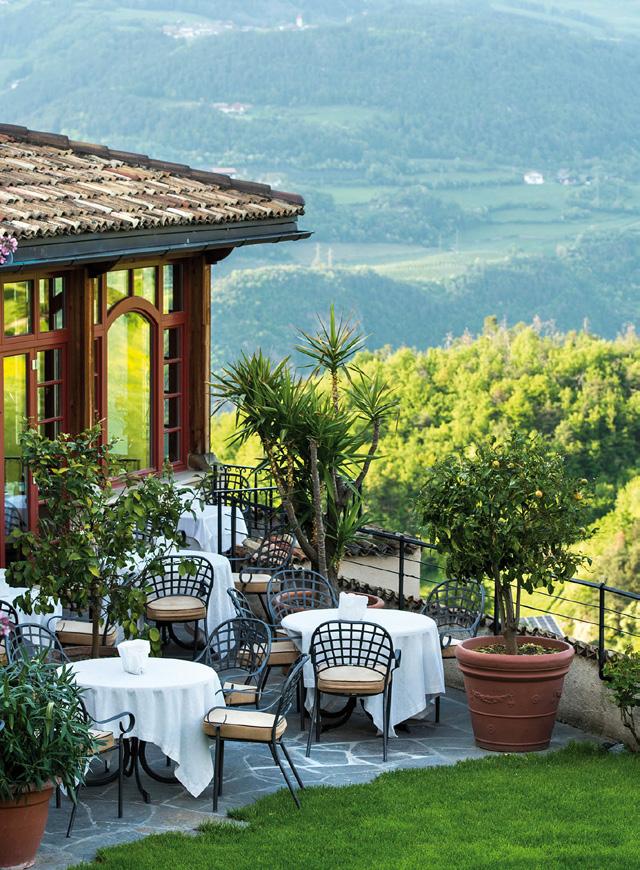
South Tyrol enchanted me with its tranquillity and beautiful nature. I like the combination of absolute relaxation, great gastronomy and sports. I enjoyed San Luis Chalet’s remote location, where we didn’t need to meet anyone unless we wanted to, but could also be on the slopes within half an hour. Near the chalet is a beautiful town, which is ideal for a walk when we were missing civilization. There are many cafes, restaurants and shops. A beautiful park with palm trees sticks in my memory. It created an interesting contrast, especially in winter, when there is snow all around.

San Luis Chalet is a place I’d like to return to in summer. The lake was frozen over during our winter visit, but it must also have a magical atmosphere during the warm summer months. We also met guests with dogs, so next time we will definitely go with a dog! The big advantage is complete privacy - if you don't want to meet anyone, you won't. You can meet other guests at dinner, which is a nice opportunity to dress up and enjoy candlelit romance. The common wellness area is definitely worth visiting, but we preferred the private sauna right on our chalet terrace. San Luis Chalet is an oasis for people who need to escape from the daily grind for a while, switch off, breathe in nature and clear their heads.

The utmost care and attention from the Feichter family was the unmissable part of my stay at Alpen Tesitin. Like the son working on the front desk, wife serving dinner. Later on the trip, the bartender at Forestis told me he was good friends with the Feichter son. And that’s what South Tyrol is all about, one large village where everyone knows everyone. Alpen Tesitin, like many properties in the region, started as a simple inn. The Feichter family have run it since 1978 and it’s now a beautiful five-star alpine property.

The room decor is simple and powerful, lots of wood and stone that stays true to its location, with fresh sawdust as a perfume and the decoration. Along with their personal touch, the wellness and spa are huge highlights. Not only the facilities, also the lovely views, typical South Tyrolean cuisine and sauna rituals. I felt fully recharged every single day. Alpen Tesitin was my first visit to South Tyrol, the first of many, I’m sure of that.



Jean-Michel Jefferson is the visionary founder of Ahipara. Over 25 years he’s created many exclusive experiences that help travellers skip tourist must-sees and connect with the true essence of New Zealand. EliteVoyage partners with Ahipara to create unique holidays which explore New Zealand through its special people, places, culture and food.

How do you describe New Zealand to somebody who hasn’t been there before?
As a beautiful, clean and light place, at the end of the earth. It’s a stunning country which has been properly looked after. Almost everybody who visits says, ‘wow, what an amazing place.’ Why do they feel so good? Why do they feel more adventurous here? It’s not just the land, the people and activities, it’s the energy.
Many people dream of visiting New Zealand yet never end up going. What puts them off?

The world is so big and there are so many options. We all can’t travel a long way every year, because of children, work, a grandparent who is ill, and many other things. People typically say they want to come once and do everything. Then they leave and say we’re coming back. People get caught up in life, so when you have the opportunity for a long-distance trip, do it.
New Zealand is a long distance away. Do you also need a lot of time to explore?
You can come for a week and get an idea. It’s like visiting a top restaurant and only eating the starters. Most people say they want to see everything, but there are 15 distinct regions and if you spend four days in each, that’s already 60 days. Do you have 60 days? The answer is no. So we do strict prioritisation. People’s time is always limited so we only hit the high points.
How do you best prioritise where to go?
Don’t research it on the internet. I don’t want to know what a client thinks about New Zealand if it's their first time. I want to know about their passions, what they like to do. From this I can give many options and there are always too many. I always say, choose only the no brainers. This then creates the backbone of a trip.
On most days it’s a beautiful breakfast, going out to do something crazy, then returning to a place of absolute comfort in time for cocktails.

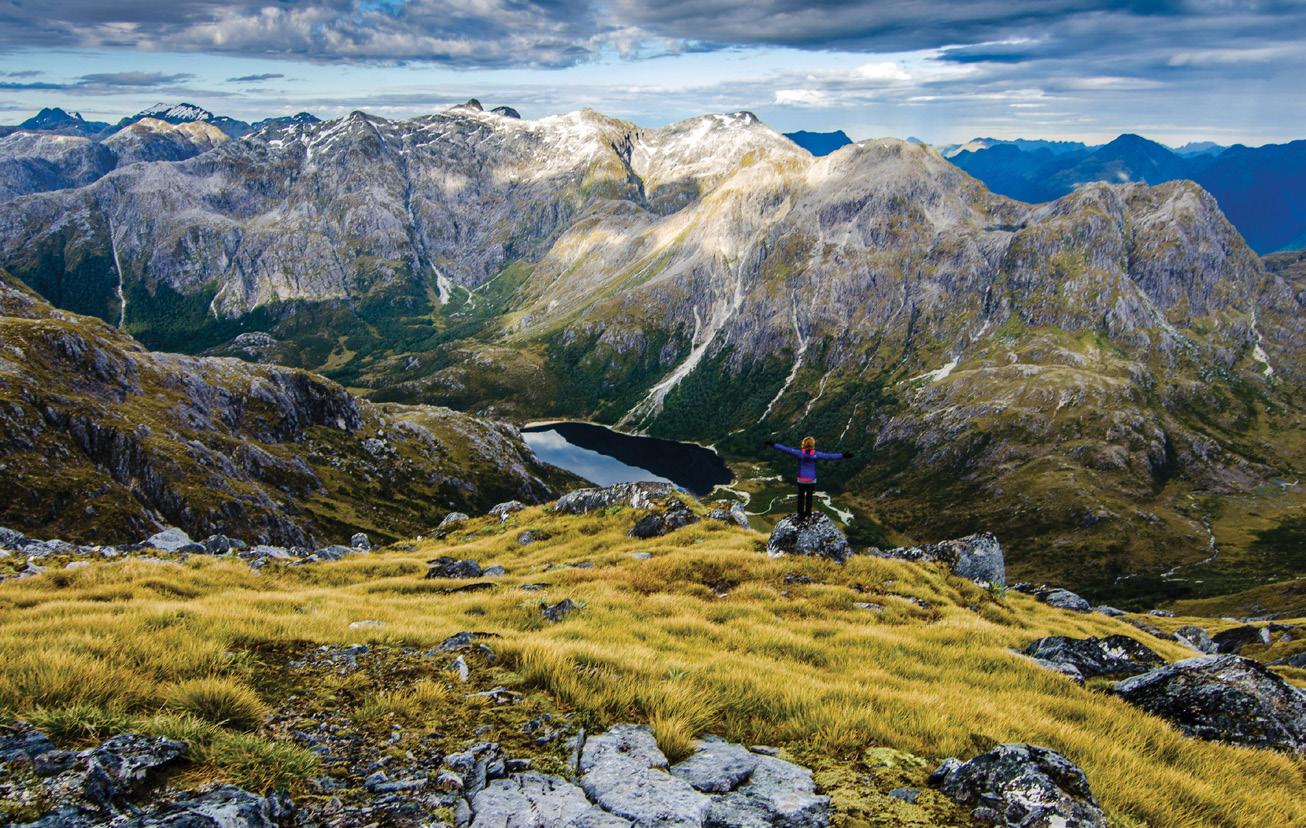

What would you recommend to somebody who came to New Zealand for a week?
Three destinations. The best international flights come in and out of Auckland, so that’s number one. It has a vibrant food scene, especially for seafood. Auckland’s east coast is a yachting playground and the west coast has unique black sand beaches.
Next stop would be the centre of the North Island, like Taupo. For geothermals, rainforests, lakes, but the main reason being this is where we do our best experiences with Maori people. Third would be Queenstown or Wanaka on the South Island, with helicoptering over the Southern Alps for one or two days. I always say you have to visit both islands, even if you only have a week, because they are so different.
New Zealand is known for its wilderness, like the Southern Alps. How do you make these wild places comfortable for people who are not adventurers?
Very few clients want to spend the night in these wild places. So on most days it’s a beautiful breakfast, going out to do something crazy, then returning to a place of absolute comfort in time for cocktails. It’s essential to be in safe and expert hands. Our helicopter pilots are phenomenal, legends of their industry. Back in the day they would pilot their machines over running deer, high in the mountains, while a hunter would jump out to wrangle the
deer as part of a live recovery programme which started our deer farms. Our style is to blend people and place. We do everything with very special people. A food lover, yacht lover, forager, the master Maori carver, a Maori warrior who is New Zealand’s quarterstaff champion. My job is to find the right, most relevant people, and take these people out of their day jobs to show their culture and expertise. If you want to climb mountains, one of our guides is the first New Zealand woman to climb Everest without oxygen. We have these people who are so overqualified, who will guide you, show you why they love this place. But don’t spend good money doing something extreme you are scared of. We can easily split a group, so husband and wife have different experiences before meeting back at the lodge.
This approach must make for some highly unique and private experiences. What are your favourites?
Our feedback from clients is that their number one is a Maori powhiri (pronounced poor-firi), a welcome. Some people think cultural stuff like this is cheesy, but it’s not a tourist group. The energy is amazing, the music haunting, you’re getting scared by the Maori warriors, you’re in touch with your own emotions and ancestors. For 25 years I’ve been putting together these welcomes at these powerful, spiritual places. Clients receive a spiritual cloak of protection for while they are in the country and 70% of them actually cry.
Our style is to blend people and place.
A forager, master Maori carver, woman who climbed Everest without oxygen... We have these people who are so overqualified, who will guide you, show you why they love this place.New Zealand, with Jean-Michel Jefferson
Hunting, fishing and foraging are very big things in New Zealand. Every rural New Zealander has a deer in the deep freeze. We do fair chase ethical hunting, it’s cull hunting to reduce the population of introduced species like chamois, tahr, red deer, sika deer, fallow deer. We can show clients how to scuba dive to grab scallops and rock lobster with their hand, or how to spear fish marlin and king fish. Our Maori guide will take people netting for freshwater crayfish and catching eels. They keep a small one, smoke it and eat it. There’s only one road going through the entire south-west coast of the South Island. The region is deep, remote, only known by a few people. Tourist helicopter flights over the Southern Alps are led by young pilots wanting to increase their flying hours, so they can move on to their dream job. We have older pilots already doing their dream job. So if a client likes gems, our pilot will take them to a greenstone boulder the size of a car, a closely guarded secret in the middle of a river. They can do deep, dark, remote, National Geographic kind of stuff in southern Fjordland. Or visit remote fishermen catching whitebait. The famous landing on a glacier is just one experience. You can helicopter this region for four days and only see new things.
After these wilderness experiences, where do clients return to for their cocktails and absolute comfort?
We consciously mix up the accommodation. Some people want nothing less than the best five stars but most want an experience. They have a more adventurous mindset and push themselves further in New Zealand. So we’ll use the top grade villa for one stay, then a night at a tented camp with Maori, next a small, funky design-led bed and breakfast, before staying in a luxury lodge. Perhaps with a stay at a luxury treehouse included as well!
What is the accommodation like in New Zealand?
It’s magical. New Zealand is known for its many luxury lodges. They tend to be small, from three to 20 bedrooms, in beautiful places. Most are owned by individuals. Wilderness location, superb architecture, incredible interiors, excellent service and food: this applies to them all. Yet they can vary widely because they represent what these individuals perceive as perfection. Some like the Robertson Lodges are American owned and feel a bit like an American country club. They’re great for golfers, but I much prefer places like The Landing. It’s in the far north and there are only private villas, with seven private beaches on a spectacular coastline. There you can do many water-based activities. Mahu Whenua is a 130,000-acre property owned by Shania Twain’s ex-husband, near Queenstown. It’s absolutely serene, the eco credentials are fantastic, with numerous adventure activities in a private wilderness. The Headwaters in Glenorchy is owned by a multi-billionaire whose objective is to host influential people from around the world, to show them what’s possible from a sustainability perspective. They headhunted all their staff, so you’re staying in this wilderness place, with Michelin-grade dining.
New Zealand is known for its many luxury lodges. Most are owned by individuals and represent what these individuals perceive as perfection.

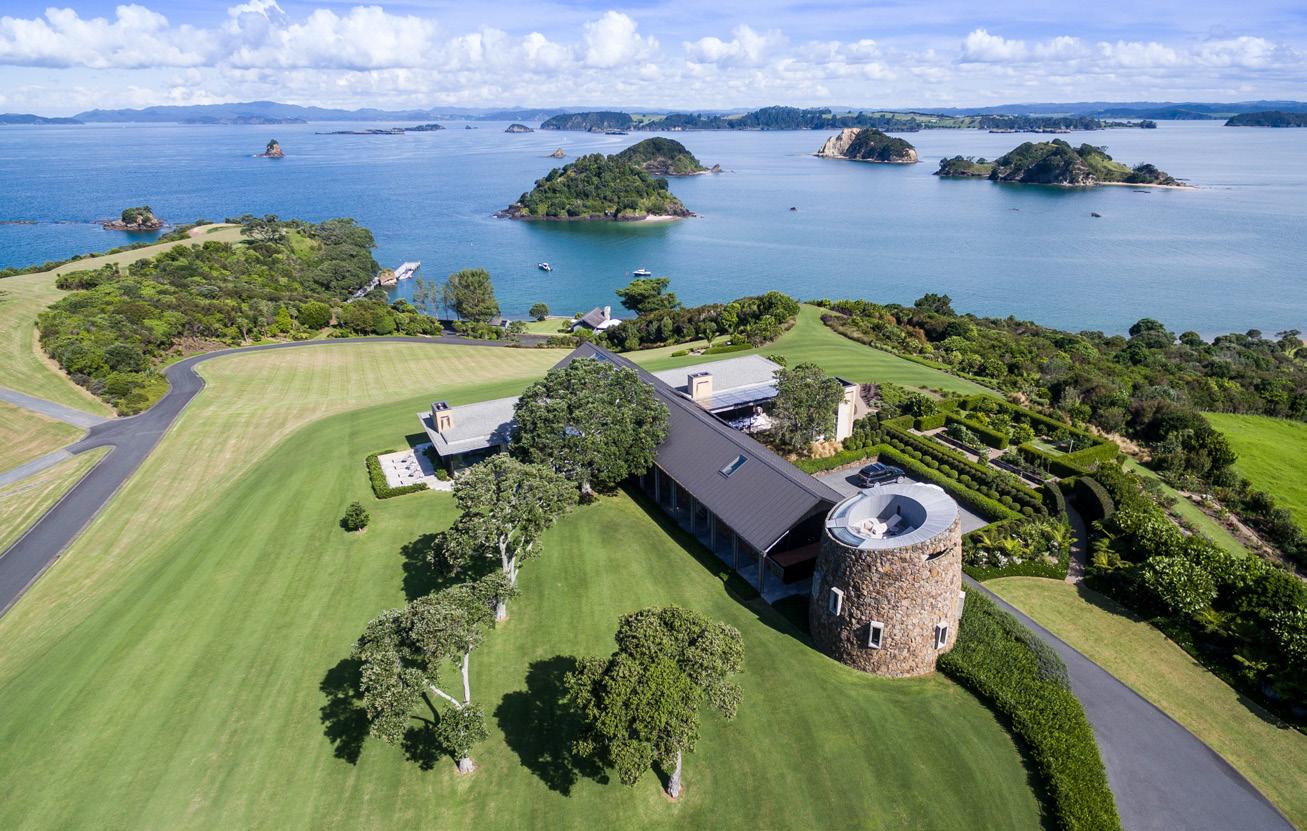

How do you get to these places? Is a helicopter the only option?

Not at all. If you’re scared of helicopters, don’t bother with them. We’ve got high-end four-wheel drives, yachts, speedboats, classic cars, motorbikes and off-road motorbikes, as well as a small fleet of luxury cars. New Zealand is a really easy country for a self driving holiday. People are not that free in everyday life due to work and family reasons. Self driving is a nice way to have a lot of freedom, to just be alone on big olling roads. Our approach is to have a specialist guide in each destination, for each specific experience, so you don’t necessarily need a private guide 24 hours a day. The itinerary is still defined with where to stay and these guided experiences. Everything in between is left free.
When is the best time to visit New Zealand?
For most people it’s the summer, late January, February and March. The ground has warmed up, the weather is most stable, there’s a relaxed feel and you can have experiences on the water. Christmas and New Year is the trophy period and you must book far in advance. Autumn is April and May, great for hiking, biking, outdoor activities, just not the beach. The trouble with winter from June to August is the days are shorter and a lot of the backcountry is closed. If you can only come during the European summer school holidays, then go to South Island for skiing, do an adventure and Maori experiences on the North Island, then fly to Tahiti for your beach holiday. September to December is spring. It won’t be beach weather but it’s still pretty good outdoor weather.
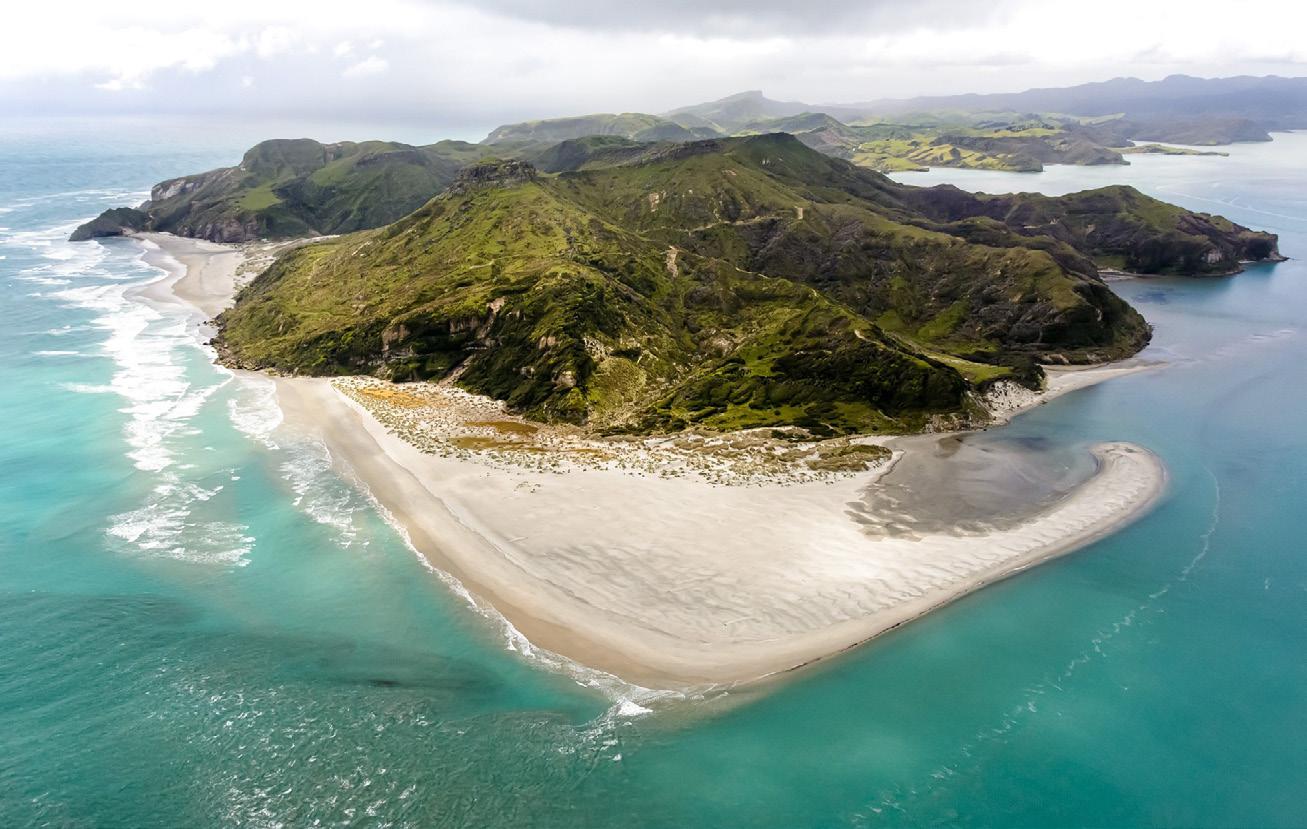

New Zealand weather is notoriously unpredictable. Can it ruin a trip?
Not at all. The weather is unstable, especially in spring. But it’s never unstable for long. We’re a long thin country surrounded by oceans, so weather passes through quickly, it doesn’t linger like in a European winter. We stay very close to clients on the trip, either with a private guide or a 24-hour WhatsApp channel. We’re mainly managing the weather and adapting on the go. The feedback we get is only a little about experiences and properties, mostly it’s about how the service and people exceeded their expectations.
You talked about New Zealand having an ‘energy.’ What do you mean by that?
One of the first tribes in New Zealand, the Waitaha, came from Easter Island for spiritual reasons, a generation at a time on double-hulled canoes. They came to Kura Tawhiti (Castle Hill), known to Pacific islanders as the birthplace of the Gods. The Dalai Lama went there recently and called it a spiritual centre of the universe. The Waitaha came to see this energy and wished to settle a place free of conflict, that treated humans as equals. I believe these roots have made New Zealand brighter and lighter than other countries. New Zealanders are known for looking after the environment: it’s a key Maori concept Kaitiatikanga, meaning guardianship. New Zealanders are famously friendly. It’s Manaakitanga, a Maori belief which means hospitality, treating strangers like you’d treat your grandmother. Modern New Zealand is built on ancient New Zealand which is built on more. People have travelled to this friendly place in the middle of nowhere, chasing a dream. There’s no better time than now to bathe in the country’s energy.
All our clients have very personal and unique itineraries. I see that continuing and going even deeper. It’s not about a hotel room. People are realising that things can be far more personal than they think. Travel has always been about widening horizons. In the future I see people travelling more for their self development. They won’t just look at New Zealand in terms of destinations or experiences, but really ask ‘how can I learn more about myself in New Zealand?’
Cover Photo: Mahu Whenua, New Zealand’s largest private conservation project
Cover Insert: Traditional Maori greeting (hongi) - the sharing of breath and meeting of third eyes
P. 106: Jean-Michel Jefferson
P. 107: Scenic flight from Lake Heron Station
P. 108 top: Fjordland National Park
P. 108 bottom: Master Maori carver Delani Brown and his warriors
P. 111 top: Mahu Whenua Lodge, near Wanaka
P. 111 bottom: The Landing, Bay of Islands
P. 112: Helicopter landing at Earnslaw Burn
P. 114 top: Westhaven (Te Tai Tapu) Inlet Marine Reserve
P. 114 bottom: Beach next to Hapuku Lodge + Tree Houses, Kaikoura
Travel has always been about widening horizons. In the future I see people travelling more for their self development...really asking, 'what can I learn about myself in New Zealand?'New Zealand, with Jean-Michel Jefferson



Exploring better dining, with some of the world's most inspirational and sustainable chefs and restaurateurs.

In 1984, Raymond Blanc opened a country house hotel and restaurant in the Oxfordshire village of Great Milton, England. Le Manoir aux Quat’Saisons, now A Belmond Hotel, is one of Europe’s most indulgent stays. The restaurant has continuously held two Michelin stars since 1984, with fresh, organic ingredients coming from the gardens. Raymond Blanc operates a cooking school and gardening school for hotel guests, launched the restaurant chain Brasserie Blanc, and is president of the Sustainable Restaurant Association.

Many world-renowned chefs learnt their skills under you at Le Manoir, Heston Blumenthal and John Burton-Race among them. What keeps inspiring and motivating you personally as a chef?
People. My team and also the people I give to, the guests. My inspiration is not uniquely about food, it is to give a total stranger the best moment of their life, in every possible way. Through generosity, through the research and curiosity that goes into every dish, through something that transcends emotions. That’s what we work for, that’s what we do, that’s the most important thing. If I stop these emotions, this love for people, I stop doing.
I’ve lived in this profession for 50 years and was totally self taught. We put these seeds into our students, to embrace immersion in a world of beauty, truth, authenticity, creativity, of excellence. Touching excellence, even for just a few seconds a day, that’s what still motivates me.
Your distillation of farm-to-table cuisine has held two Michelin stars for almost 40 years. Has the relationship between farm and table changed over this time?
Yes. That’s a positive sign. I was the first chef to create both an a la carte menu and full vegetarian tasting menu. In 1984! I love vegetables. I come from a background where the garden would provide the food for ten months a year, for a family of seven. I learnt so much about soil, seasonality, varietals and harvesting. We would go mushrooming and hunting wild asparagus at 5am. I would prepare a basket of vegetables and my mother would apply her creative force to cook and preserve them.
My expression is rooted in tradition, always with new shoots of modernity on top of it. Something big happened. Veganism. With enough intelligence, creativity and curiosity, you can transform a humble bean into something unbelievable. Vegetables were a garnish to beautify a dish. Now vegetables have been brought into this huge creative process about eating better. New tastes and flavours are being born, which is exciting. The modern guest also wants to embrace a different form of luxury, which involves sustainability. No more can you put something on your chest saying you are sustainable. Prove it.
How else do you think luxury is changing for the modern guest?
Luxury was in the past, and still is in many ways, gold plated and full of emptiness inside, with no morality, no conscience. The modern consumer is more knowledgeable, more aware, and wants total truth and authenticity. And wants real experiences. I’m very lucky, it’s exciting to create something authentic. I always wanted to create an inclusive luxury. It’s not about a haute waiter coming with a bible of wines. It’s the welcome, the warmth, never intrusive, always generous. We live in a life of the familiar. I want to bring people into somewhere warm where they discover something new. The modern guest comes here to find calm, serenity, a precious moment. And they find that peace through every little detail.
You’ve proved that luxury can be sustainable, in your restaurant and hotel. How will this evolve further at Le Manoir?
I’m creating seven new gardens. We already have 12. One will be a big bee village, with hives taken from different cultures, made of straw, wood, rope. We will have two gypsy houses for hens, who put nitrogen into the soil and eggs for our guests. We are doing a vineyard with these amazing scientists, who have created a grape that’s resistant to frost and most disease, through natural cross breeding. A grape that needs less water and is organic, so no pesticide, fertiliser or fungicide required.
Every suite at the hotel is a story, a real story that has happened to me, through travelling, meeting an artist, or reading a book like The Snow Queen. Every idea at Le Manoir is connected with food, garden, design, travelling and discovery. Everything has cohesion but the human factor will always be the most important of all. I depend strongly on my team, they embrace my values so their values belong to us. We work with Belmond and LVMH and there will be an extraordinary reinvention of Le Manoir. My role now is to prepare this, beyond me, with an amazing team. The whole idea is to keep the soul and culture, to embellish it and make it even stronger. We’re not eternal. We are fireflies, we pass by, and all I want to do is to leave something which is beautiful and will go on to be beautiful.
EliteVoyageby
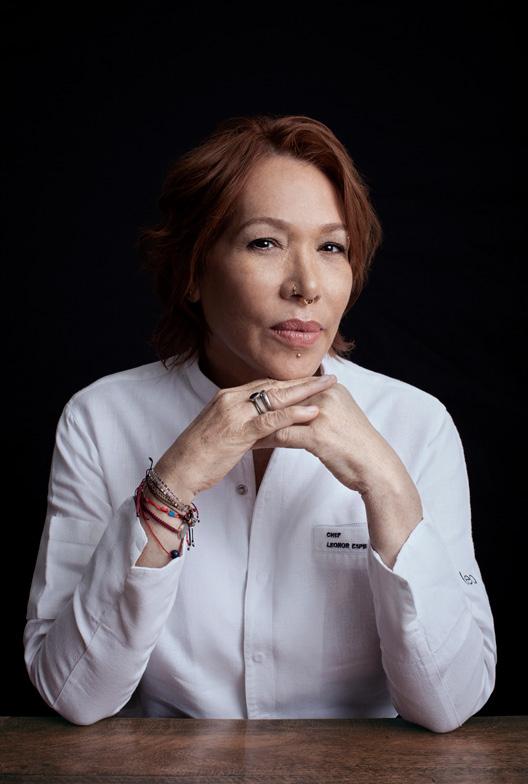
Chef Leonor Espinosa and sommelier Laura Hernández opened their Bogota restaurant Leo in 2007, a venture that quickly put fine Colombian cuisine on the global map. They describe Leo as a gastronomic journey through the ethnobotany of cultures that inhabit various Columbian biomes. In 2022 Leonor was awarded World’s Best Female Chef, by the annual World’s 50 Best Restaurants list.

Leonor, what are your biggest challenges when transforming Colombia’s biodiversity into a single dining experience?
Ensuring a consistent supply of diverse ingredients, while working hand in hand with community leaders and small producers, is definitely not an easy job. More than 70% of our products come from regions that are geographically isolated. Certain ingredients are only accessible by travelling long distances, which requires careful planning and coordination. We work through FUNLEO, our foundation, to support communities in strengthening their identities through gastronomy.
It’s essential to represent the unique food cultures of Colombia’s different regions and communities. Innovation brings new flavours to the forefront, yet we must also honour the roots of Colombian cuisine. This involves engaging with local communities, incorporating traditional recipes and techniques, preserving and reviving their culinary practices. It’s also crucial to balance the desire for a diverse culinary experience with the crucial priority of sustainability and ethical sourcing.
Laura, what inspired your approach as a sommelier, to pair dishes with fermented drinks and botanical infusions?
As Colombians, I knew that what we can show the world is our country's biodiversity. We have always grown coffee, cacao and many fruits, but producing wine has never been part of our culture. The drinks and food of an area complement each other, an invisible thread ties them to the same culture, soil and tradition. The flavours of smoked chicken are accentuated with a chicha. A fish with tucupí goes better with fermented Amazonian coca leaves.
I wanted to build a liquid proposal in accordance with our purpose at Leo: claiming Colombian culinary traditions and ingredients from its diverse communities and ecosystems. I’ve had the pleasure of navigating Colombia’s seas and rivers, smelling the mist of the high Andean mountains and the humid salinity of the Caribbean at sunset. I marvel at how many fermented and ancestral drinks I’ve come across. My aim is to elevate these rural drinks to the world of haute cuisine, drinks like claro de maíz, chichas, or derivatives
of viche. In 2019 I launched TERRITORIO CICLOBIOMA: five artisanal spirits, all with some ingredients never before used in making beverages, such as Colombian nopal and endemic species from the páramo and high Andean Mountains.
Leonor, what have been the strongest influences on your development as a chef?
Firstly, I have embraced my culinary identity and incorporated it into my cooking style. I spent most of my childhood and youth in Cartagena de Indias and other parts of the Colombian Caribbean. Exploration of Colombian biodiversity has also been a strong influence. By studying native plants, herbs, and ingredients used by different communities, I’ve developed a different understanding of Colombian gastronomy and its connection to the environment.
I apply my own life experiences with everything I’ve learned on my travels and cultural immersions across Colombia. Collaborating with local communities and farmers has played an important role in becoming who I am and how I create as a chef. Finally, food is a channel of expression for my art, aesthetically represented in my dishes on the menu of restaurant Leo in Bogotá. I see culinary creations from an observation and experimentation approach that I borrow from the plastic arts.
Laura, how do you see the idea of “farm to table” evolving in coming years?
Colombia has a rich agricultural landscape and the "farm to table" movement can continue to grow by strengthening local food networks. This involves fostering direct relationships between farmers, producers, and restaurants, to ensure a more transparent and efficient supply chain. Local initiatives and collaborations can support small-scale farmers and promote locally grown and produced food.
The concept can evolve by putting a spotlight on traditional and regional ingredients too, reviving heirloom crops, supporting indigenous farming practices, and promoting lesser-known local ingredients. This movement can also place greater emphasis on sustainable farming practices: promoting agroecological and ancestral farming methods, regenerative agriculture, and responsible use of natural resources.
by EliteVoyage
As the founder and heart of the Ambiente network, Tomáš Karpíšek has a long list of successful restaurants, cafes, a bakery, wine bar, butcher and brewery. These include Michelin starred La Degustation Bohême Bourgeoise, the Bib Gourmand Eska, and the educational and creative centre UM. He attributes the success of Ambiente to its distinct personalities and dedicated teams, and the farmers they’ve worked with for so long.


How does the relationship between a farmer and a particular restaurant impact the quality of the ingredients?
I will give an example. When Radek Chaloupka and Vlasta Lacina, who founded Amaso with me, started visiting farmers to find the best raw material for Čestr, we couldn’t find anyone who raised heifers for meat. When we finally found the farmers, we wanted to influence what the heifers or young steers were eating. In the Czech Republic there is an idea that the best meat comes from a bull, which is not true. Breeders fatten their bulls to grow as much lean meat as possible in the shortest possible time. But we wanted a breed whose meat has as much fat as possible, which was fed for the best taste, not quantity. Everyone thought we were crazy, asking for far more expensive meat. We gradually convinced the farmers and today we cooperate with those who breed and feed the way we want. Another example: Chef Paul Bocuse's plates tasted great not only because of his art, but also because he took chickens from the same local farmer for thirty years. Together they gradually perfected the taste and texture of meat raised in their local conditions. We strive for this at Ambiente.
At UM, you take participants of the To the Roots course directly to individual farmers. Does their relationship with the menu change when they know where the ingredients come from and the story behind them?
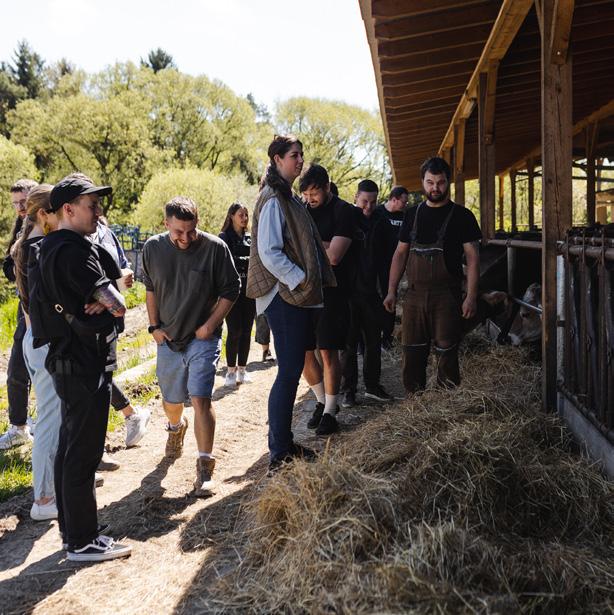
Yes, without fail. Enthusiasm for discoveries is contagious! This is one of the reasons why we founded UM. In addition to our chefs having space to play around and innovate, educating our staff and now the public, we want to rediscover Central European cuisine. What is Czech, Bavarian, Austrian and even Swiss cuisine? We are trying to redefine our ambient and preserve what is disappearing. Finding somebody who can slaughter a pig by hand, butchering, chopping, gutting the way it used to be done, is harder than you might expect.
Serving food according to farm to table principles means fresher and more unique ingredients, but less reliable consistency. Is it more challenging from a restaurateur's perspective?
But that inconsistency is part of the authenticity! In practice this is a big challenge, but a knowledgeable chef can deal with fluctuations and actually benefit from them. A chef cannot simply accept that because the asparagus is worse this year, he will serve worse food. He must search until he finds better asparagus, or process the asparagus differently so the recipe resonates with this year’s crop. This need to deal with imperfections is the engine of creativity and innovation.
Which meal from your last travels most sticks in your memory?
In Portugal I was driving through mountain villages with a group of bikers and we came across a small local restaurant. They were serving pig’s ear and offal…I was in a trance with the food! Everyone wanted to just have a coffee and go, so I had to talk them into eating. I suspect we are so dependent on outside information that we don’t recognise value until somebody points it out to us. We are no longer able to perceive the world through sensory experiences, in the here and now. Cut a tomato, look at the seeds, smell it…fortunately farmers can still do it.
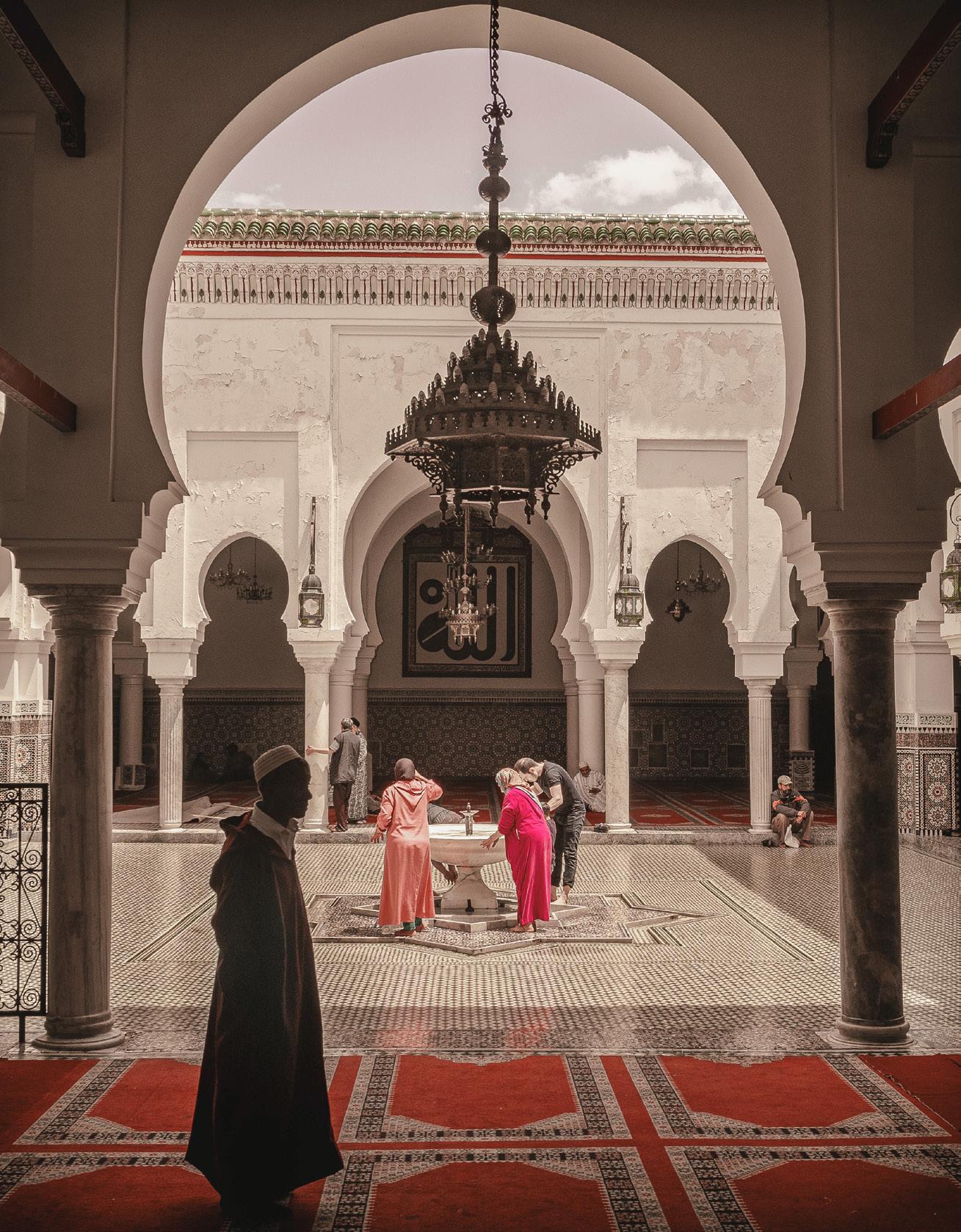 1. Fes
1. Fes
Explorer editor Stephen Bailey extends the summer in Morocco. Awaiting his young family is an exotic mix of smells, sounds, new hotels and unusual experiences.
 2. Siniman restaurant, Oberoi Marrakech
2. Siniman restaurant, Oberoi Marrakech
Smells mingle in the Marrakech medina. Cumin, leather, oranges, argan oil, freshly baked bread and minty tea. Every turn brings a new impression on the labyrinthine lanes. Silver merchants, ornate doorways, grinning butchers, ceramic painters, chefs tending to tajines and treasures spilling from antique stores. Life is lived on the streets here and it’s a boundless show, almost a thousand years of history reflected here and now.
This initially felt very chaotic and I quickened my pace. Now I’ve learnt: Morocco is about opening the senses and taking time to focus on small details. It may seem an odd holiday choice for my oneyear old, but by moving at Leia’s slower pace I’m treated to endless theatre. She is delighted, wandering onto Djemaa el-Fna square, past the fortune tellers, barbecue stalls, henna painters, snake charmers and street theatres that have been here for millenia. We’re beckoned to sit with a group of Amazigh musicians. The crowd gathers. The drums beat. And the music begins.
The atmosphere at The Oberoi Marrakech is completely different. Converted from an olive farm outside the city, this new property is a serene antidote to the medina. It’s still a feast for the senses. At our pool villa it’s quiet enough to hear the breeze. At the Siniman restaurant I’m eating braised lamb shank with mhamsa pearls and sweet shallots, to a soundtrack of Gnawa music.
200 artisans worked on the main lobby, hand-creating geometric patterns from plaster, ebony and ceramics. It’s a modern replica of Marrakech’s legendary 14th-century Ben Youssef Madrasa, and the most beautiful hotel lobby I’ve ever seen.
Hospitality is integral to Morocco’s many cultures and the country has a superb collection of places to stay. Small riads, or guesthouses, are a boutique option within Morocco’s old, lowrise medinas. Beautifully designed and honouring tradition, these provide an immersive travel experience. In Marrakech medina we stayed in a delightful suite of handcrafted tiles and Saharan art, the riad’s calm rooftop a further escape from city bustle. The family-led hospitality was a strong cultural insight, although these riads are not so suitable for children, due to the many steps and lack of open spaces.
There’s significantly more space and facilities at the grander properties, typically located outside city walls, where The Oberoi is far more suitable for my daughter. Amanjena, Four Seasons and Mandarin Oriental are also good options outside Marrakech, while Royal Mansour and Mamounia offer this palatial luxury and space in a more central location. I recommend staying a week at one, to combine relaxation with different experiences.
Hiking to oases in the Atlas Mountains we drink sweet minty tea with Amazigh people and learn about their traditions.
ح
Hospitality is integral to Morocco's many cultures and the country has a superb collection of places to stay.
From a hot air balloon I admire the desert at sunrise. Listening to stories we explore old mud-brick kasbahs, fortified citadels where time stands still. We meet Salma Lazrak, a young designer reinterpreting the Moroccan caftan, such glamour to her use of silk, sequins, strass and pearls.
Morocco is a dream shopping destination and I find the experience is contrary to stereotypes of annoying, forceful sellers. It certainly is with a guide. Being artisanal isn’t a selling point here. It’s the expectation, buying a one-of-a-kind piece the norm, from clothes to carpets, lamps to leather. Design and local craftsmanship is deeprooted in the cultural heritage, a blend of Arab, Andalusian, Amazigh, African, Hebraic and Mediterranean influences. Marrakech is the cultural melting pot and this is reflected in the diverse artisans that inhabit the souks. After a very relaxed week in and around this city we explore more of the country.

First north, to the imperial city of Meknes, where an ancient tradition of inlaying metal with metal is kept alive. This Damascene technique is one small highlight of Morocco’s most artisanal city, the decorative art symbolic of a small walled city that feels like a living design gallery. It’s a relaxing city that creates a very calm medina experience with a young child.
Alleyways of cobblestone and curiosity dominate Fes, the world’s largest walled city and pedestrianised zone. It’s a giant maze, perfect if you don’t mind getting lost: elegant archways, backgammon players, Roman remnants, Arabic calligraphy, leather tanneries, a thousand competing sights and I’m sure we’re just going around in circles. Now the call to prayer, a beautiful harmony that brings a few moments of calm and peace, muezzins responding to each other’s calls from hundreds of mosques’ minarets.
م
Marrakech is the cultural melting pot and this is reflected in the diverse artisans that inhabit the souks.Morocco 3. Marrakech Medina
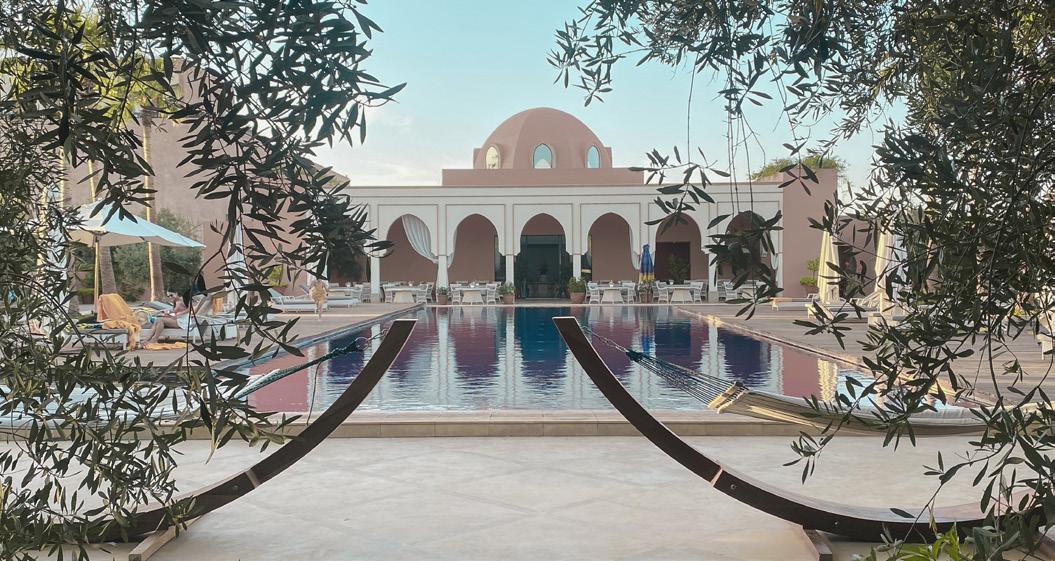

Mosques are the most beautiful examples of local architecture and art, many of them welcoming spaces for non-Muslims too. As are the innumerable cafes, where strong sweet coffee and sweet minty tea are served every hour of the day. Alcohol is available in hotels and the local wine is surprisingly good, but there are very few bars and no drinking culture. Instead, I appreciate how hanging out in a relaxed, convivial environment is more important than what everyone is drinking.
Further north we travel to Chefchaouen, where every wall is painted a different shade of blue. Violet, azure, sapphire, turquoise, even the trees are painted a blue hue. Wafts of couscous and tagine guide us through this mysterious mountain town, where people sit on the street to sell toma-
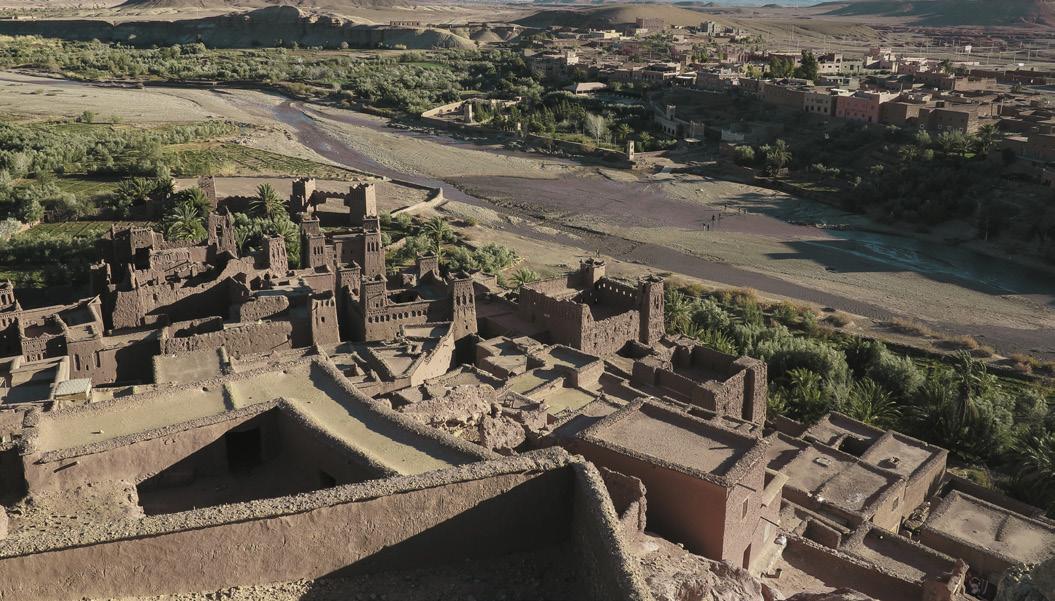
toes, goat’s cheese, spices and fabrics. Fes is to be experienced. Chefchaouen is to be savoured, such enchantment when opening the senses to the subtleties of a blue canvas. It’s Morocco’s Instagram favourite and Leia does more than a few good photobombs.
Sand, sand, sand. The east of Morocco is the Sahara Desert, where staying at a private camp deep in the dunes was among our options. We travelled west to the Atlantic coast instead, where luxury beach destinations are emerging. In Tagazhout Bay we experience new five-star resorts, but the grey beach is a real disappointment and there’s zero exclusivity or privacy. I don’t recommend Morocco for a beach holiday. It’s a viable add-on, not the reason to travel.

Essaouira quickly wins our hearts because it’s much more than a beach. Gnawa music dominates the medina, buskers and performers bringing perpetual energy. While there are many indications of tourism, the medina is traditional, low-rise, welcoming and seemingly unchanged. From the city’s towering fortress walls comes a long beach, mostly populated by kitesurfers. While top hotels aren’t here yet, we stay in an exclusive-use design villa with a pool, in easy reach of both the city and sand.
In many ways, Essaouira reflects the overall Moroccan experience. Beautiful expressions of art and design. An inviting culture valuing hospitality and family. Weather like a Mediterranean summer, for most months other than very hot July and August. Excellent food, whether it’s a street stall or a smart rooftop restaurant. Many different experiences to try, from artisanal workshops to a coastline of wild beaches backdropped by ragged red cliffs.
We’re far from the first to be charmed by Essaouria. Jimmy Hendrix, Frank Zappa and The Rolling Stones holidayed here in the sixties. Every June the city hosts a globally influential world music festival and while exploring the city the music never seems to stop.
Beckoned into a courtyard we follow the sound of drums. A crowd gathers around us, of all ages and many languages. The drums beat faster. And the music really begins. This is Gnawa, all imperceptible pitch changes and repetitive, ritualistic poetry. Leia claps, the drums beat faster, the music whirls in a higher and higher key. Some of the crowd fall into a trance and I feel so calm and welcomed, in such a foreign scene.
وWhere else does the holiday feel so much like summer, without actually travelling during the summer?
Where else is the culture so unique and immersive, relatively close to home? Where else does the holiday feel so much like summer, without actually travelling during the summer? My daughter is adored by the locals and at her slower pace it’s easy to engage in conversations with interesting and friendly local people.
Morocco is a feast for the senses. And I discover there’s a story behind every sound, sight and smell, something new to discover every time we leave the hotel, riad or villa. It’s a destination that has made me feel more alive, a country where life flows perpetually through the streets and everybody is invited to join the show. Most surprising of all is the laid-back atmosphere: Morocco is a cultural adventure and also a very relaxed place to go on holiday.
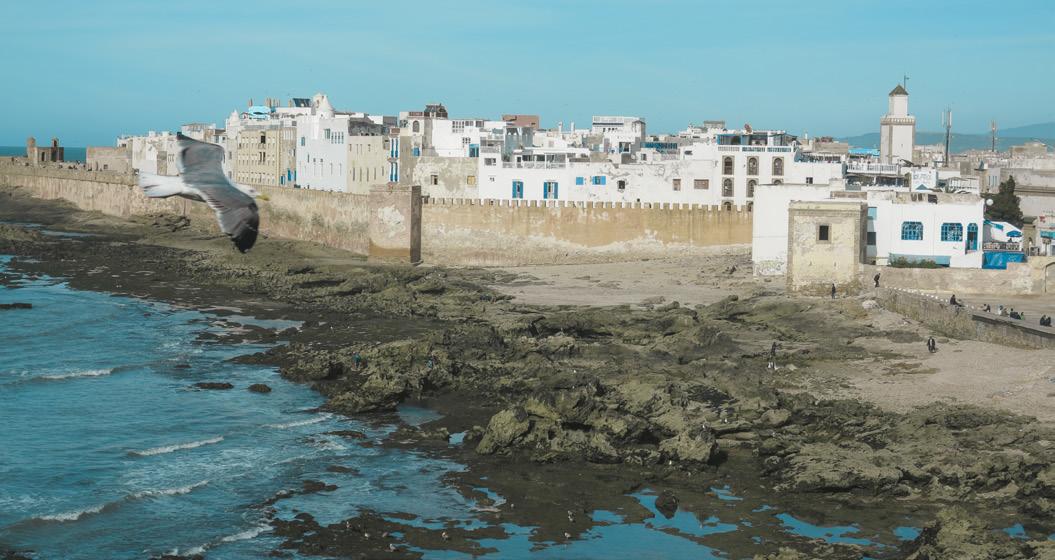
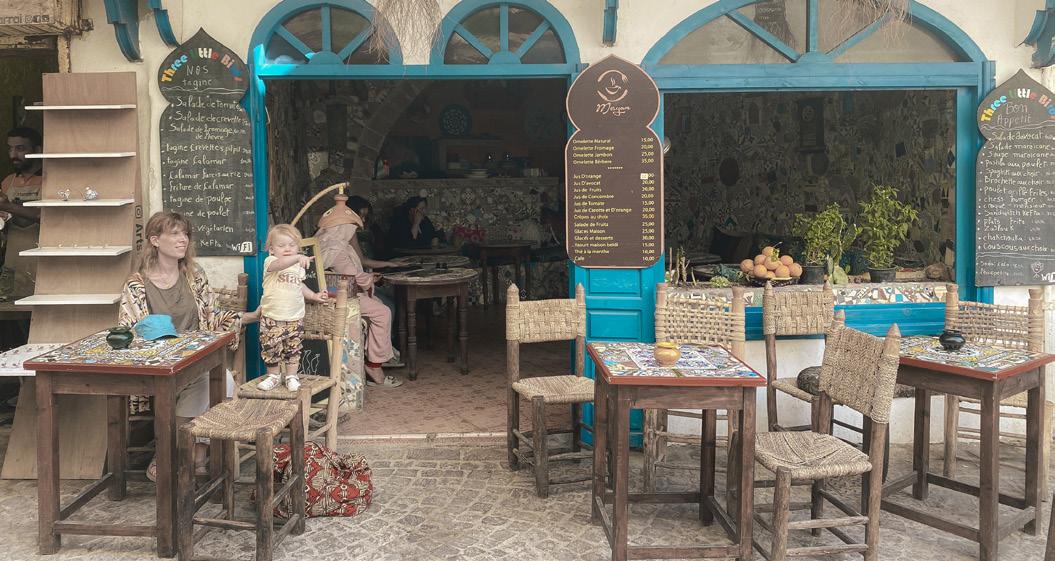
Artisanal glass has a long tradition in the Czech Republic. Contemporary Czech artists have generated international acclaim in recent years, with installations from luxury hotel lobbies to the Venice Biennale. Artist Rony Plesl and his exhibition curator Lucie Drdová take us from the Czech Republic to Venice, in a wideranging interview on art and travel dreams.

“Glass is embodied light” says Leon Jakimič as he discusses how his company Lasvit inspires people. Leon explains four Lasvit installations, found in hotel lobbies in Paris, Marrakech, Jakarta and Saipon.



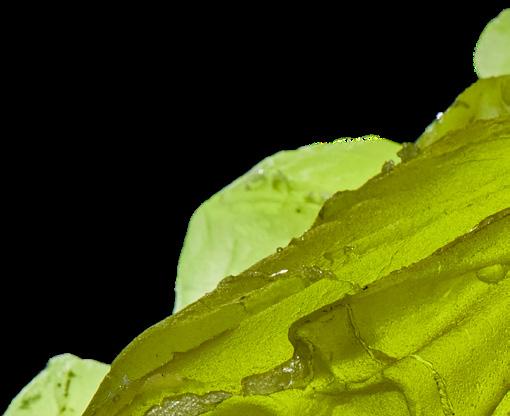


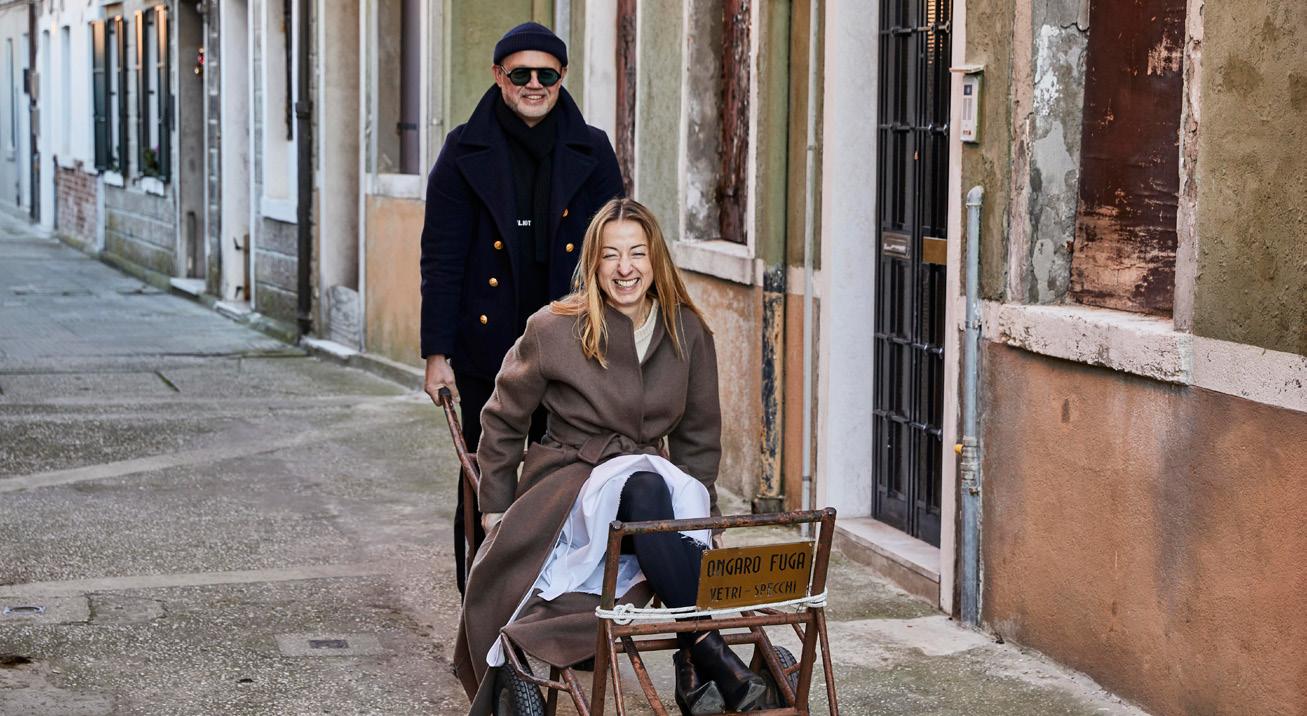
Renowned glass artist Rony Plesl teamed up with exhibition curator and gallery owner Lucie Drdová, to create the installation Trees Grow From the Sky. Inside the Church of Santa Maria della Visitazione, it was an official part of La Biennale di Venezia 2022, and a world premiere of Vitrum Vivum, a new glass melting technology. Rony and Lucie discuss travel dreams and travel experiences that have shaped their careers and lives. And where a story about glass must begin: Venice.
my situation all the more. The Biennale was like a dream come true, a dream I didn’t even dare to dream. If that sounds romantic it’s because it is! Not because I fulfilled artistic ambitions, but because I fulfilled ordinary boyhood dreams.
Lucie, you have been working in Venice for several years. What attracts you to the city?
Rony, you spent four years learning your craft on the Venetian island of Murano, then returned last year to create something for the Biennale. Did it feel like you had completed a life cycle?
Rony: Definitely. I started as an artist in Venice, working for the world’s oldest family business, Barovier & Toso, founded in 1292. However, I first visited Venice before the Velvet Revolution, with my friend Matěj Forman. I went there with the feeling I would see places from my high school dreams for the first and last time. When I saw the dome of Santa Maria del Fiore from Piazzale Michelangelo in Florence I literally cried. To this day I can see us sitting in front of the Guggenheim Museum in Venice, eating sardines in tin cans with Czech bread we brought with us.
Working at Barovier I remembered these experiences many times and appreciated
Lucie: The second Covid wave was peaking when Rony and I arrived in February 2021, looking for exhibition opportunities. Before then, Venice only meant the Biennale. We arrived in a quiet city without tourists, which showed us a completely different face to Venice. That’s when I fell in love. I am mostly attracted by the light and the ubiquitous element of water. Venice is actually a small community and if you wander around for a week, the locals will notice you and let you know you are part of their community, not just a tourist. Perhaps it’s also because our first steps on Murano led us to the mirror shop of Rony’s colleague and friend Giuliani, where there was such a beautiful atmosphere.
Rony: Only a few thousand people live on Murano. They have their own language, they are proud of their traditions. Working there I soon learnt that you can do beautiful things in beautiful company. But most importantly, men go to lunch in a nice quality shirt and give each other a friendly pat on the back. And admiration is expressed loudly to women who return it with a smile. I absorbed their relaxation. Venice is about the sun, the air, the fact that vegetables are sold directly from the boat and young guys communicate naturally with grandmothers. That fragrance of life will stay with you forever and you will always long for it. In Italy, you feel as if, somehow, the world belongs to you more.
Lucie, as a curator, did you need to learn something new to work with glass?
Lucie: It was a personal and professional challenge for me. Just daring to create an exhibition abroad, when it’s just me and one artist. Securing financial support was essential, because making the art pieces was demanding. Nothing like it had been produced before. We became a small team, also with the glassmaker Jiří Šín, Rony's wife Šárka and daughter Josefína. The design process was very dynamic, from the first sketches to the three crystal trees and the luminous uranium glass trunk. Themes like the pilgrim, the road and the tree resonated in Rony. There was my own pilgrimage route, of Franciscan Tuscany and churches. I don’t know if it was intuition or coincidence, but we visited over 20 potential exhibition spaces, and when we entered the early Renaissance church of Santa Maria della Visitazione, we both knew we had found the place.
Rony, seven years ago your exhibition in Queen Anne’s Summer Palace (Belvedere), Prague, presented design and free art. Your recent exhibitions in London, Venice, and this summer in Kampa, are all about pure art. Is this a deliberate development?
Rony: Belvedere was truly a turning point for me. I wanted to cross the bridge from the world of design to the world of liberal arts, because even if it’s another bank of the same river, it is a different world. The design has to be liked, has to be sold, has to support the people in the company that made it.
On the other hand, with pure art, you think about the content and form recedes into the background.
Working with Lucie was one of my dreams, because she is synonymous with quality. It’s a real challenge for an artist when a gallerist or curator doesn’t go below that line of quality. Conversations with Lucie helped me tremendously. Of course I had it inside me, but it’s not easy to awaken! Clients sometimes wonder why art is sold through galleries and curators. It is necessary, because an artist needs to communicate with somebody in order to grow artistically.
How is Czech glass doing in the world today?
Rony: How is Czech wood or Czech plastic doing? In the Czech Republic we still see glass as family silverware, but once you enter the field of free art, unlike in design, the form and material are secondary. Glass as a free discipline is nascent and has only recently reached the hands of important artists like Ai Weiwei, Roni Horn or Tony Cragg. Glass galleries around the world approach this unwisely, as they emphasise the material. There aren’t stone galleries or metal galleries, so why glass galleries?
From a design perspective, Czech glass is extremely high quality and plays an increasingly important role in the world. From a perspective of free art, Czech glass is not doing very well. Glass is terribly pleasing to the layman’s eye and this is its kiss of death, because in the liberal arts, likeability is the last thing you should care about. But glass seduces creators and buyers, to create and buy pleasing things.
In Italy, you feel as if, somehow, the world belongs to you more.Embodying Light: Czech Glass Around The World
Rony, has all your success in the field of design allowed you to purse the creative freedom, or have you just grown old into it?
Rony: Both. I am proud of the exhibition in Kampa because it was without compromise. Of course we devoted ourselves to promotion, but a calmness came over me, I put myself in God’s hands. It’s actually full circle again. When Lucie and I sat for hours in Venetian cafes, drinking wine and philosophising about art, I remember it as some of the most beautiful moments of my life. Whether the work is appreciated by a world-class gallery can be important, but I don’t want to pursue this too much. I want to leave it more to fate, so I can enjoy the process more.
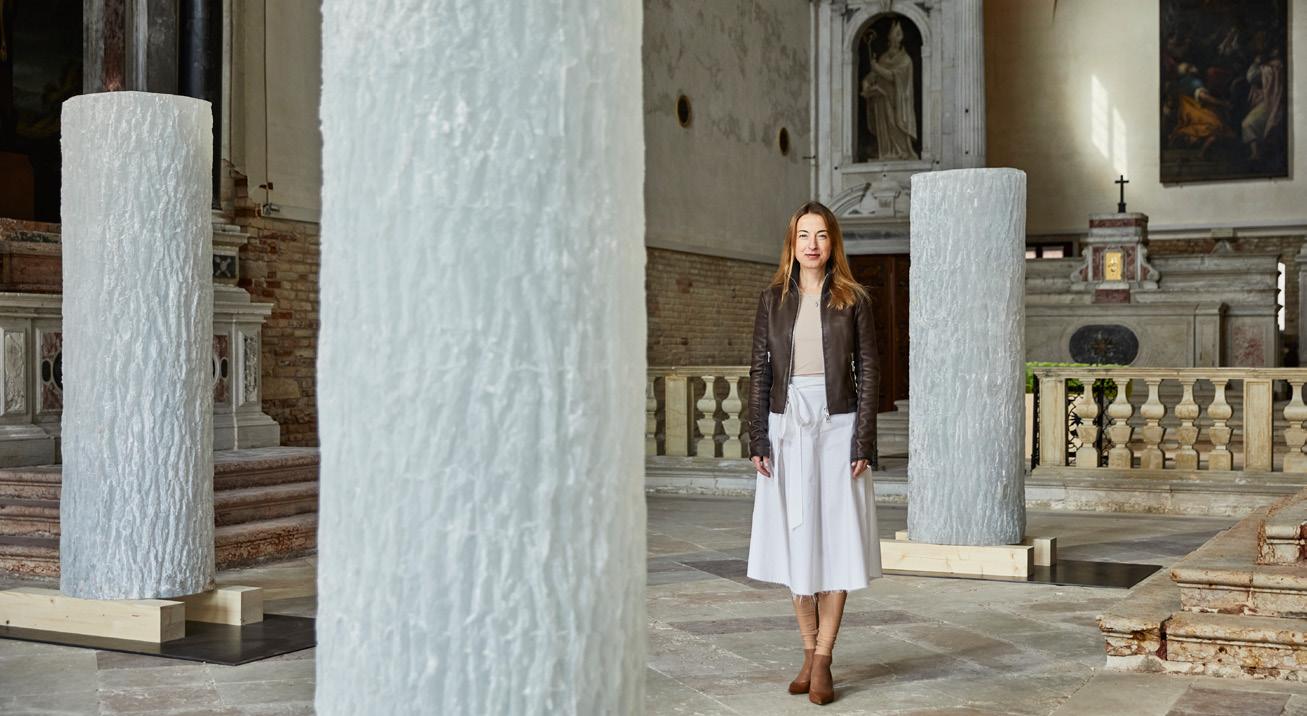
When I apply this to travel, the more you know about a place, its wine, its people,
its architecture, the more you will enjoy it. A thousand years ago, when you let a wheel roll down a hill, everybody understood the principle within a second. It’s different today because the world is more complex. Now, if you are not actively interested in things, you will not understand them. It applies to art too. When you stand in front of the statue of Perseus with the head of Medusa in Florence, and you know about Cellini, what a craftsman he was, you enjoy it more. Working with Lucie is special in this respect. Our conversations are like a balm, I feel that whatever topic we touch upon will lead to something otherworldly. That’s why it’s worth living, even if you’re not the most successful, or even if you suffer. It’s still worth it.
Lucie: When the work is honest, you know.
Lucie: When it comes from the innermost need to communicate something through creation. It is your commentary on the world, which you are willing to express in an abstract, immeasurable form. I find it fascinating. When creation comes out of a calculation, sooner or later it will show.
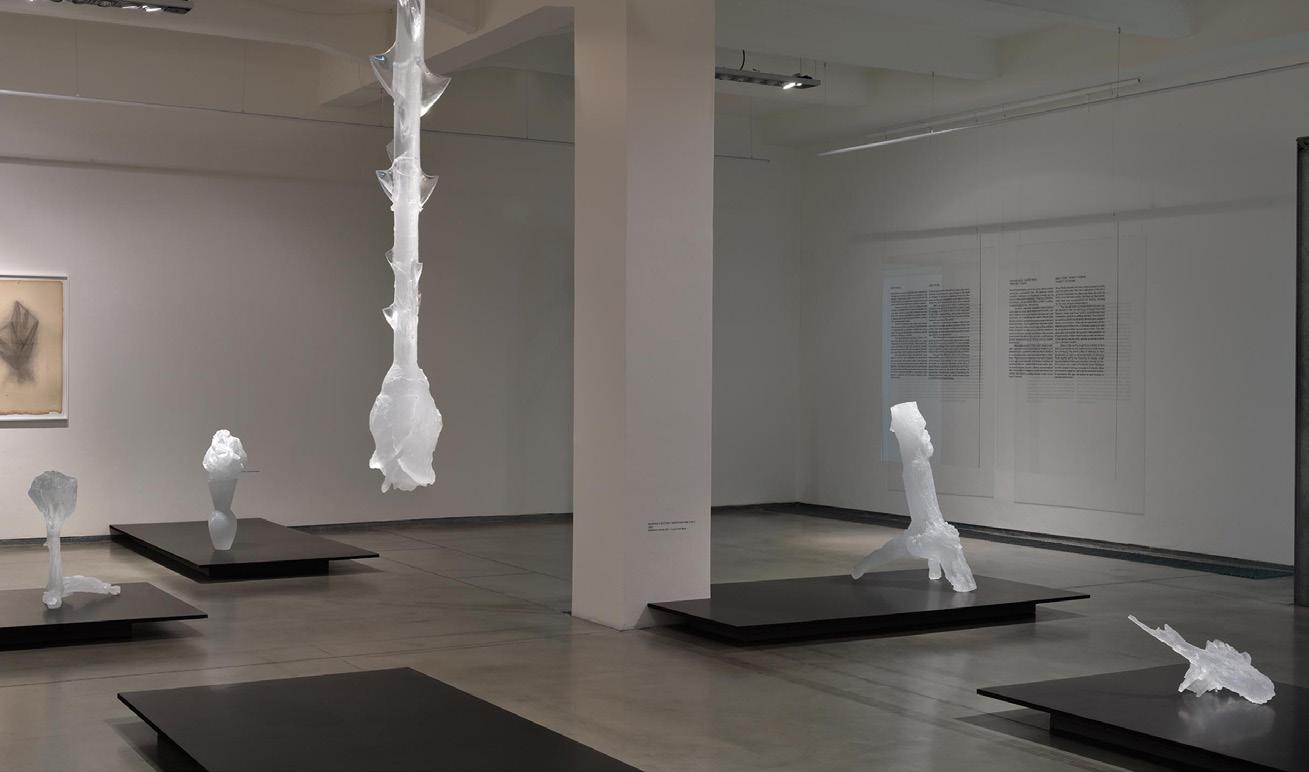
Not all artists make a living from art alone, sometimes even if they are exceptional and sell. They have side jobs to support their families and maintain their studios. And still that something is worth pursuing.
Isn’t the Italian relationship with beauty felt everywhere: churches, food, fashion, or a simple iron railing?
Lucie: Relationship to beauty, that’s nice.
Rony: I felt the same way in Japan too.
Lucie: It isn’t just a relationship to shallow or superficial beauty, but to the immediacy of each moment too. When I am in Italy I feel able to allow myself things I do not allow myself in the Czech Republic, because I am surrounded by the people there and a beauty that gives me joy. When Rony and I arrived in Venice I felt it after the first aperitif. As if the essence of life was more accessible.
Embodying Light: Czech Glass Around The World
1. Rony Plesl & Lucie Drdová, Murano glass shop, Venice (photo Petr Krejčí)
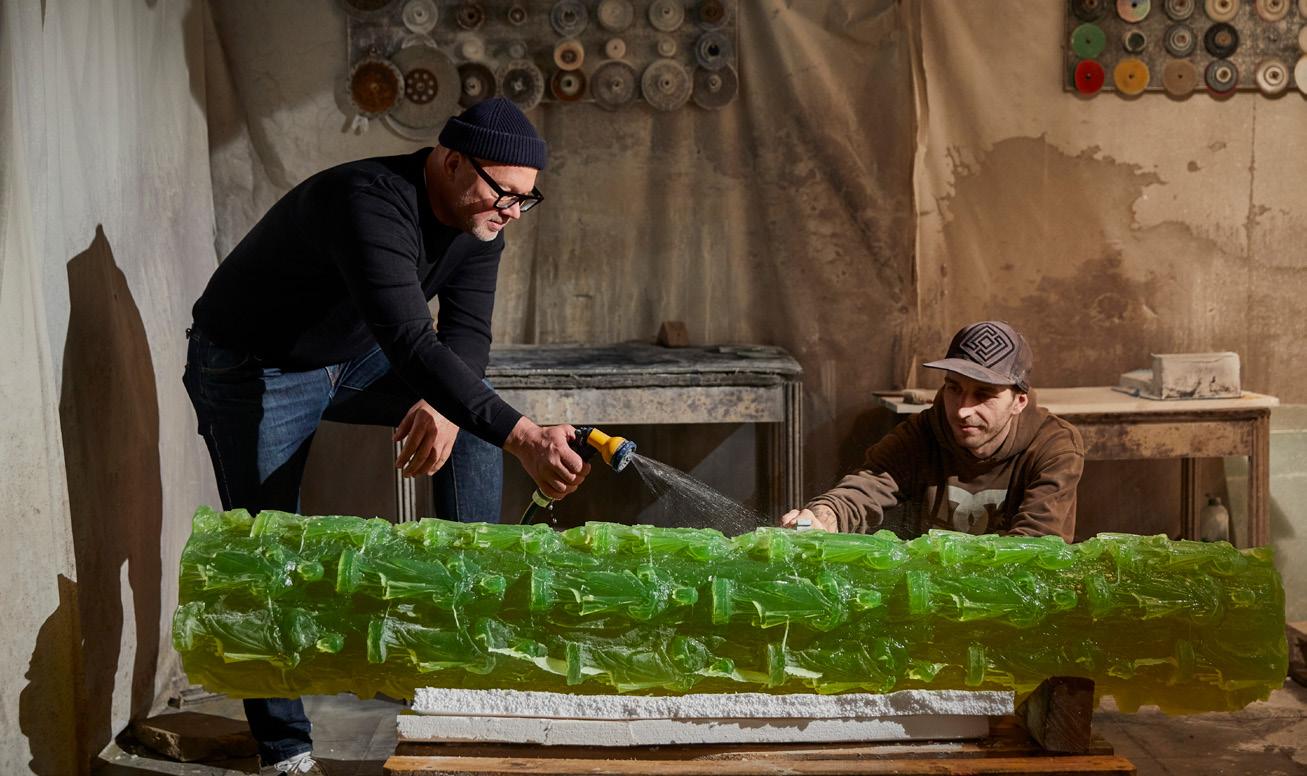
2. Lucie Drdová with Trees Grow From the Sky, Church of Santa Maria della Visitazione (photo Petr Krejčí)
3. Kampa Museum exhibit (photo Martin Polák)
4. Rony in the glass factory creating the statues for the Bienalle
5. Lasvit owner Leon Jakimič
In Italy I am surrounded by a beauty that gives me joy, as if the essence of life is more accessible.
Unique works of art, hand-made in Czech glassworks, proudly installed in some of the world’s finest hotels. Lasvit owner Leon Jakimič breaks down four monumental installations, revealing their concept, inspiration, production and design. It’s an insight into how Czech tradition creates a hotel atmosphere around the world.
 by EliteVoyage
by EliteVoyage
“I have a soft spot for this one. It was the first installation to create a major media buzz and marked our entry into the European market, after our successes in Asia and the Middle East. The installation captures the movement of floating sycamore leaves. Sycamores line the Champs-
Élysées in Paris, where the hotel is located. They were also planted in Shanghai during French colonial times, a city where the Peninsula brand has origins. We imagined the wind blowing between these two cities, carrying the leaves in a gentle swirl to the hotel lobby. Each of the 980 leaves is hand shaped and took two hours to create. Some are clear, while others are silver leaves encased in glass. The installation measures nine metres in height and the leaves hang on three almost invisible cables. This allowed the artist to play with the inclination of each of them. Dancing Leaves is the most photographed element of the Peninsula Hotel Paris, which makes me very pleased, because it is a hotel full of art.”
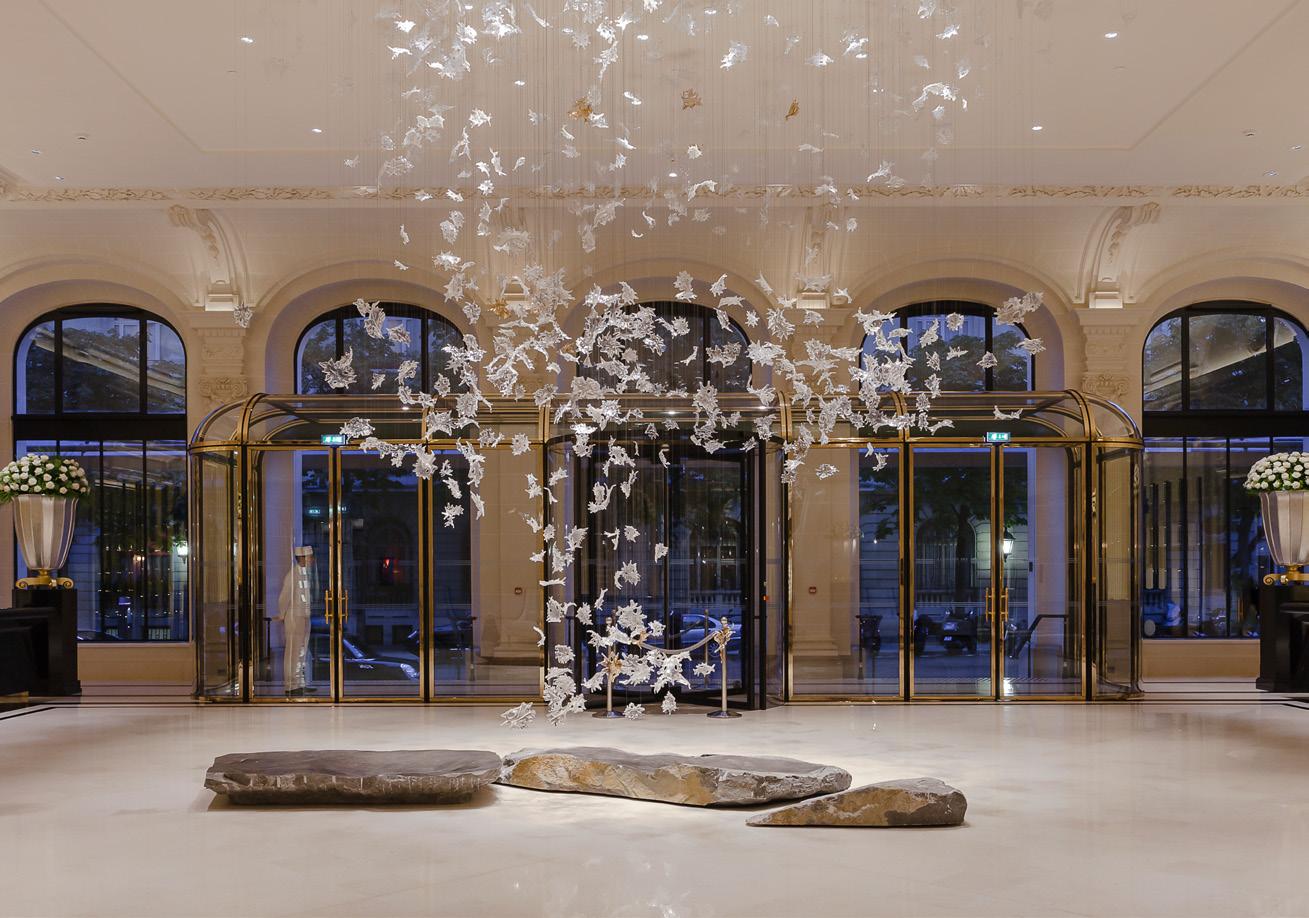 Embodying Light: Czech Glass Around The World
Embodying Light: Czech Glass Around The World
"A timeless and modern work that responds to music that is constantly playing in the lobby of the hotel. Sound and light are connected by relatively simple algorithms that translate the rhythm of Andi Rianto’s musical compositions into light pulsations. We created 1192 pieces of glass and needed 10 kilometres of cables to construct the work. Each of the glass elements is distinct and can respond to the music individually. But it's not a laser show, more about subtle changes that sophisticatedly transform the mood of the space."

 by Ivana Zuskinová and Katarína
by Ivana Zuskinová and Katarína
"In some projects we have 100% creative freedom, but in other cases the interior designers have a clear idea of what they envision in the space. La Mamounia was the latter. Studio Jouin Manku gave our artists a real challenge, in a good way. The lights consist of hundreds of highly reflective prism rods that are hand blown and hollow inside. Some were sprinkled with baking soda during production, which created an interesting cracked effect. This modern yet classical chandelier feels like a fusion of Arabic influences with European art deco. It evokes the traditional ornate ceiling vaults in Moroccan architecture called muqarna.”
“Our largest project in terms of both size and price is these two 20-ton, 30-metre long dragons fighting for a fiery pearl. A grown man could walk through their trunks - their teeth alone are half a metre high. These dragons consist of 2.5 million crystal components, which were hand-
woven stone by stone onto the metal scales. 80 people worked on the project for three years, and we needed 20 containers to transport it. Tens of kilometres of LEDs were used so in one way these dragons are like a gigantic screen. They’re a work of art and a light show in one. During installation we had to consider parameters like air humidity, the high salinity, strong winds and the fact that the hotel is in a seismically active area. Our experience with installations on yachts and cruise ships was useful: we must take into account how an installation withstands the effects of the sea and the vibrations of the ship itself. Our metal and glass dragons in the Imperial Palace are listed in the Guinness Book of Records as the largest piece of jewellery in the world.”
 Embodying Light: Czech Glass Around The World
Embodying Light: Czech Glass Around The World

